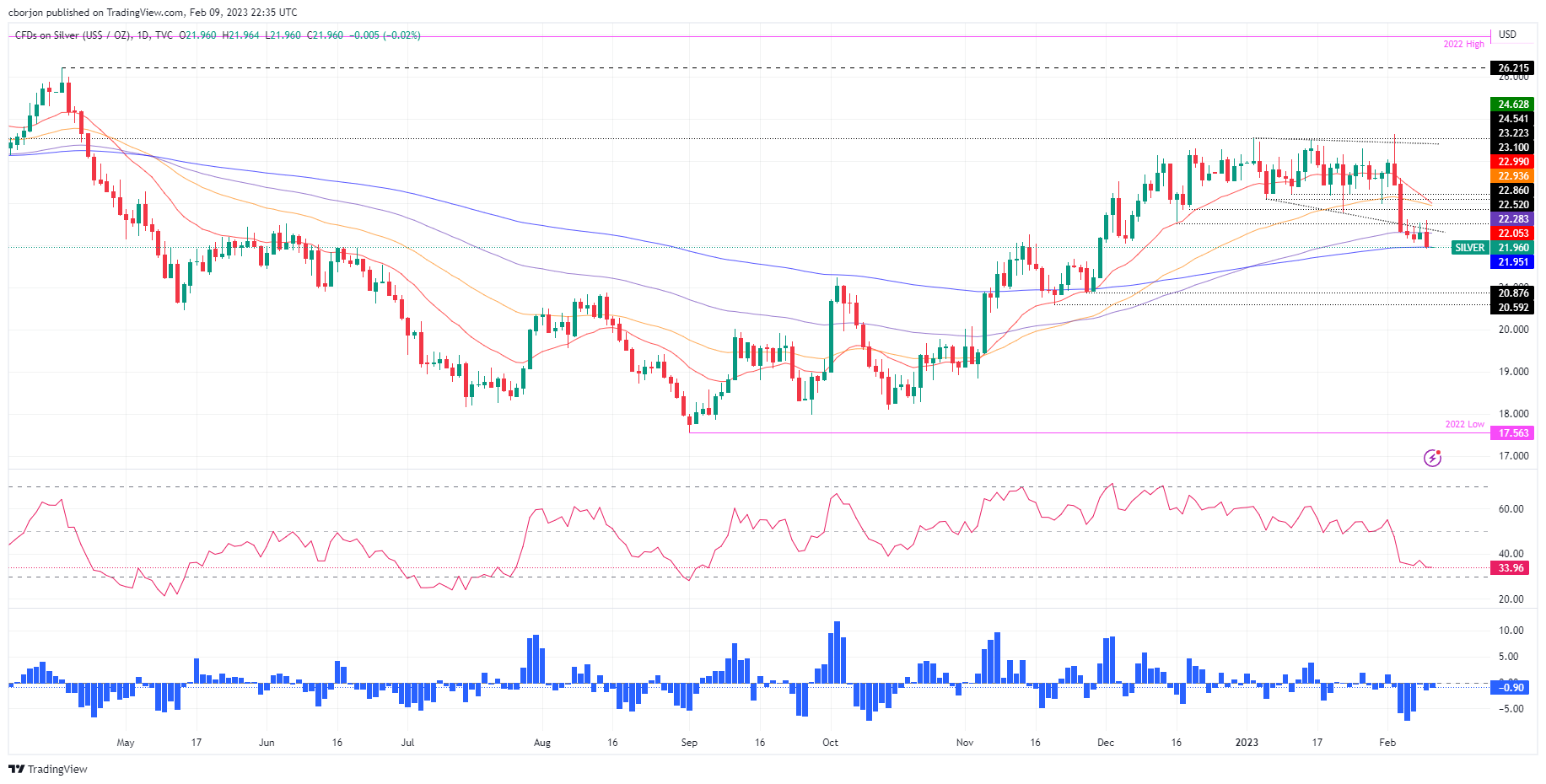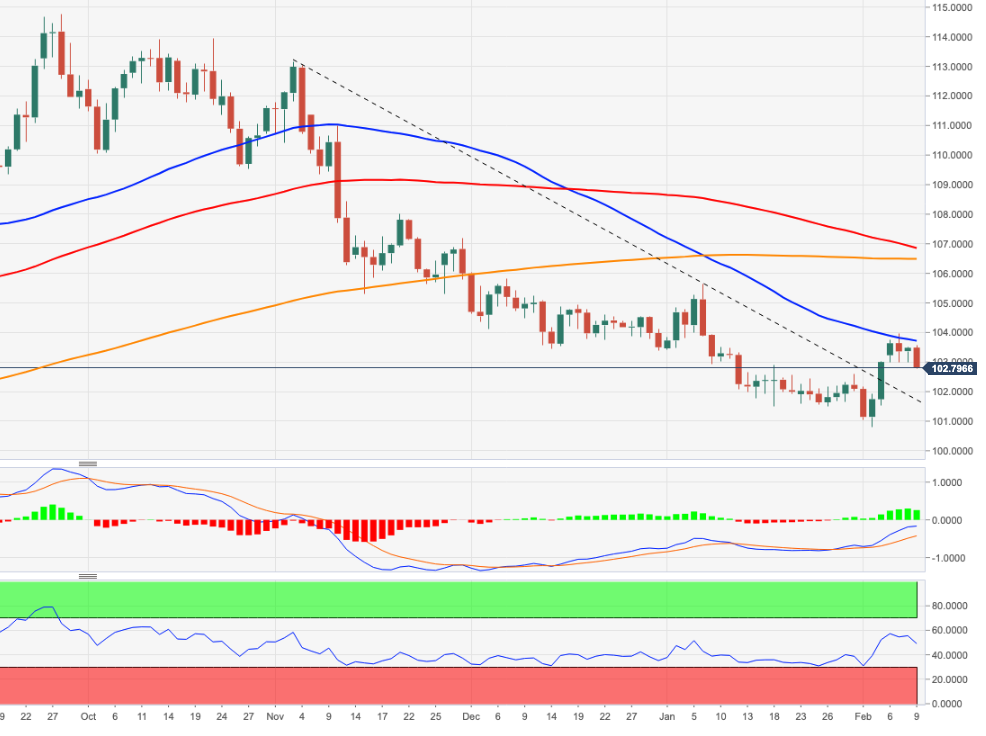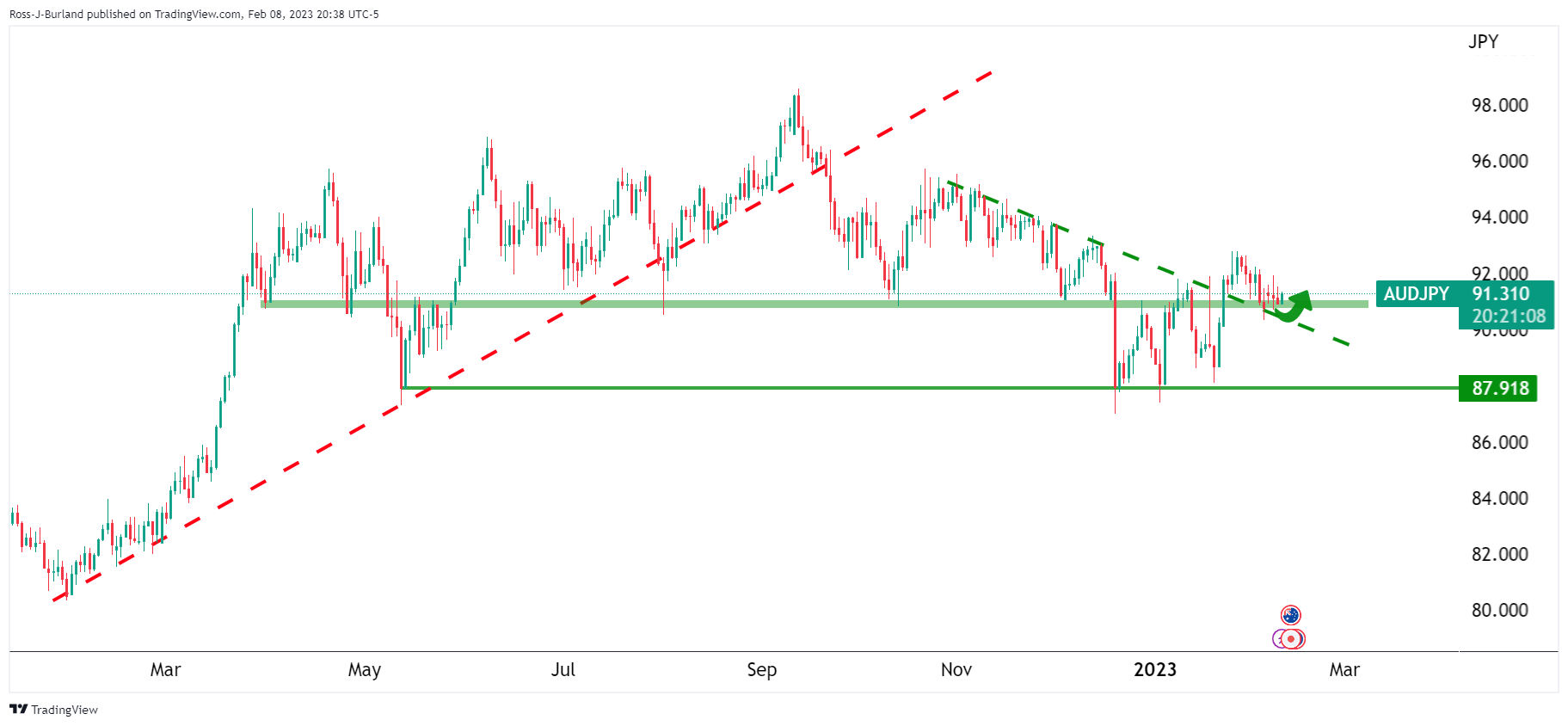- Analytics
- News and Tools
- Market News
CFD Markets News and Forecasts — 09-02-2023
- EUR/JPY remained volatile after a surprise decline in the German inflation data.
- The cross is looking to negate the Inverted Flag formation.
- A bullish range shift by the RSI (14) favors an upside momentum.
The EUR/JPY pair has corrected marginally after testing Thursday’s high around 141.35 in the early Tokyo session. The cross displayed sheer volatility on Thursday after the release of the German inflation data.
The German inflation data decelerated to 9.2%, surprisingly from the consensus of 10.0% and the former release of 9.6%. Although Eurozone inflation is showing the negative impact of higher interest rates by the European Central Bank (ECB), the price index is still extremely far from the required target. Therefore, more interest rate hikes by ECB President Christine Lagarde cannot be ruled out.
Meanwhile, investors are still awaiting nominations for Bank of Japan (BoJ) Governor Haruhiko Kuroda’s successor for further guidance over the Japanese Yen.
EUR/JPY is an inventory adjustment phase above 141.00 and is aiming to negate the Inverted Flag formation on an hourly scale. The chart pattern indicates a sheer consolidation that is followed by a breakdown. Usually, the consolidation phase of the chart pattern serves as an inventory adjustment in which those participants initiate shorts, which prefer to enter an auction after the establishment of a bearish bias.
The cross has scaled above the 20-period Exponential Moving Average (EMA) at 141.04, which indicates that the short-term trend has turned bullish.
Meanwhile, the Relative Strength Index (RSI) (14) has climbed into the bullish range of 60.00-80.00. A continuous oscillation in the same will trigger an upside momentum.
For an upside move, the cross needs to surpass January 25 high at 142.29 for an upside move, which will drive the asset toward January 11 high at 142.61 followed by October 24 low at 143.72.
Alternatively, a break below February 7 low around 140.30 will drag the asset toward January 17 high at 139.62 and January 13 low around 138.00.
EUR/JPY hourly chart
-638115829940960198.png)
- Gold price holds lower ground after refreshing the monthly low on rejecting bullish technical formation.
- Inversion of the United States 10-year, 5-year yield curve hints at recession and weighs on XAU/USD price.
- Mixed comments from the Federal Reserve officials, downbeat US data probe Gold sellers.
- Early signals for the US inflation will be eyed for clear directions.
Gold price (XAU/USD) remains depressed at around $1,860 as markets await the key United States data during early Friday. It’s worth noting that the US Treasury bond yields renewed recession fears and weighed on the XAU/USD price the previous day. However, the mixed comments from the Federal Reserve (Fed) officials and optimism surrounding China appeared to have challenged the Gold buyers.
United States recession concerns weigh on Gold price
Even if United States President Joe Biden and Treasury Secretary Janet Yellen both turned down the fears of economic slowdown in the US, the Treasury bond yields were saying a different story the previous day and weighed on the Gold price. That said, the inversion of the yield curve between the 10-year and the two-year yields seemed to have triggered the latest economic fears by suggesting the market’s rush for risk safety amid recession woes.
The difference between the 10-year and 2-year Treasury bond yields turned the widest since 1980 as the former prints 3.66% and the latter came in around 4.50%. The same signaled the market’s recession fears and triggered the US Dollar run-up and weighed on the Gold price.
Federal Reserve bias turns bleak
Downbeat prints of the United States Weekly Initial Jobless Claims and comments from Richmond Federal Reserve (Fed) President Thomas Barkin seemed to have weighed on the US Dollar during the initial Thursday.
Fed’s Barkin appeared too dovish while suggesting rate cuts as he said that it would make sense for the Fed to steer "more deliberately" from here due to lagged effects of policy. Previously, Fed Chair Jerome Powell hesitated in cheering the upbeat US jobs report and raised fears of no more hawkish moves from the US central bank.
That said, the US Weekly Initial Jobless Claims rose to 196K versus 190K expected and 183K prior. “The advance number for seasonally adjusted insured unemployment during the week ending January 28 was 1,688,000, an increase of 38,000 from the previous week's revised level," said the US Department of Labor (DOL) showed on Thursday.
China story also puts a floor under the Gold price
Other than the Federal Reserve officials’ (Fed) ability to convince markets, risk-positive headlines surrounding China, one of the world’s biggest Gold consumers, also seemed to have challenged the XAU/USD bears ahead of the early signals of the United States inflation data.
US President Joe Biden’s taming of fears emanating from the US-China jitters, following the China balloon shooting by the US, joined the hopes of People’s Bank of China’s (PBOC) rate cuts and the restart of the China-based companies’ listing on the US exchanges to favor risk-on mood during early Thursday.
Early signals for US inflation eyed
Given the Gold bear’s control amid the mixed signals, XAU/USD traders should pay attention to the preliminary readings of the United States consumer-centric numbers for February like the Michigan Consumer Sentiment Index and 5-year Consumer Inflation Expectations. Above all, the market’s preparations for the next week’s US Consumer Price Index (CPI) will be important to watch.
That said, market forecasts hint at upbeat prints of the scheduled US data and hence challenge the XAU/USD buyers, together with the below-mentioned technical analysis.
Gold price technical analysis
Gold price extends pullback from the 200-bar Simple Moving Average (SMA) following its unsuccessful bounce off a seven-week-old bullish channel’s support line.
The XAU/USD downside also justifies the recent slump in the Relative Strength Index (RSI) line, placed at 14, as well as the looming bear cross on the Moving Average Convergence and Divergence (MACD) indicator.
It should be noted that the monthly horizontal resistance area surrounding $1,900-05 also appears a tough nut to crack for the Gold buyers, other than the 200-SMA level of near $1,888.
Following that, a run-up toward the monthly high of $1,960 can’t be ruled out. It’s worth noting that March 2022 high near $1,966 and the stated channel’s top line, close to $1,972 by the press time, could challenge the Gold buyers afterward.
Alternatively, a sustained downside break of the aforementioned ascending trend channel’s support line, near $1,870 at the latest, keeps directing the Gold bears towards the seven-week-old horizontal support area surrounding $1,825.
Overall, Gold is back on the bear’s radar ahead of the key US data, after a brief teasing to the bulls.
Gold price: Four-hour chart
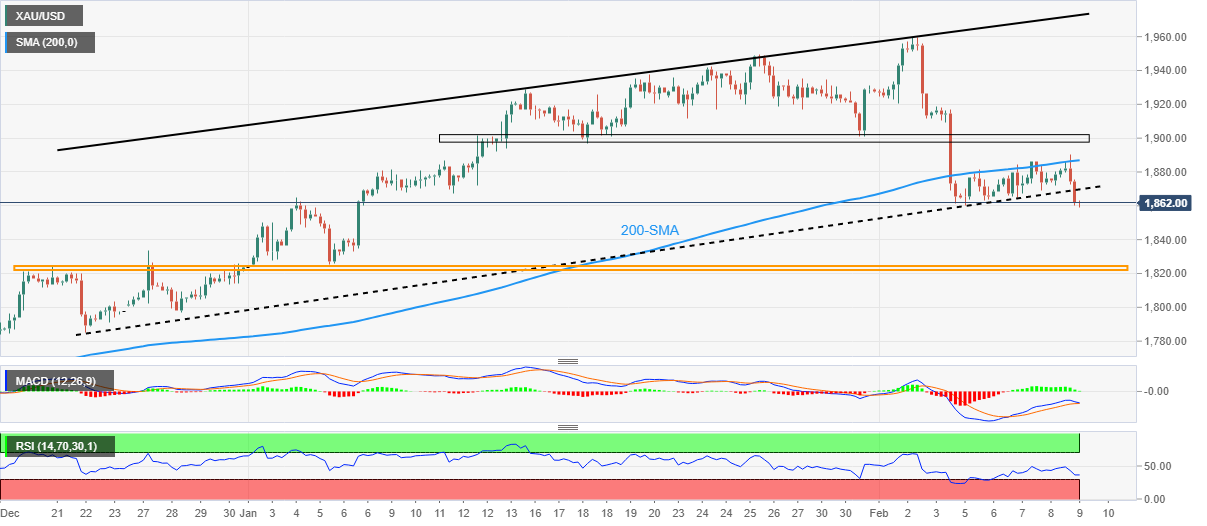
Trend: Further upside expected
- AUD/JPY is still subdued around the crowded 91.00 area, with the 20/50/100 and 200/day EMAs meandering the area.
- AUD/JPY Price Analysis: To remain sideways amid the lack of a catalyst.
The AUD/JPY seesaws as Friday’s Asian session begins, trapped within the boundaries of the 20/50/200-day Exponential Moving Averages (EMAs), amidst the lack of a catalyst. Therefore, further sideways action is expected in the AUD/JPY, which exchanges hands at 91.15, above the 20-day Exponential Moving Average (EMA).
AUD/JPY Price Analysis: Technical outlook
The AUD/JPY daily chart portrays price action contained within a 30 to 50-pip range. The AUD/JPY key resistance levels are the 50-day EMA at 91.25, followed by the 200-day EMA at 91.51, ahead of the 100-day EMA, which is the farthest one, around 91.82. On the other hand, the AUD/JPY key support levels are the 20-day EMA at 91.09, followed by the 91.00 psychological level.
The Relative Strength Index (RSI) is in bullish territory but flat, meaning the pair has uncertainty. Meanwhile, the Rate of Change (RoC) shows volatility is shrinking, suggesting that neither buyers/sellers are in charge.
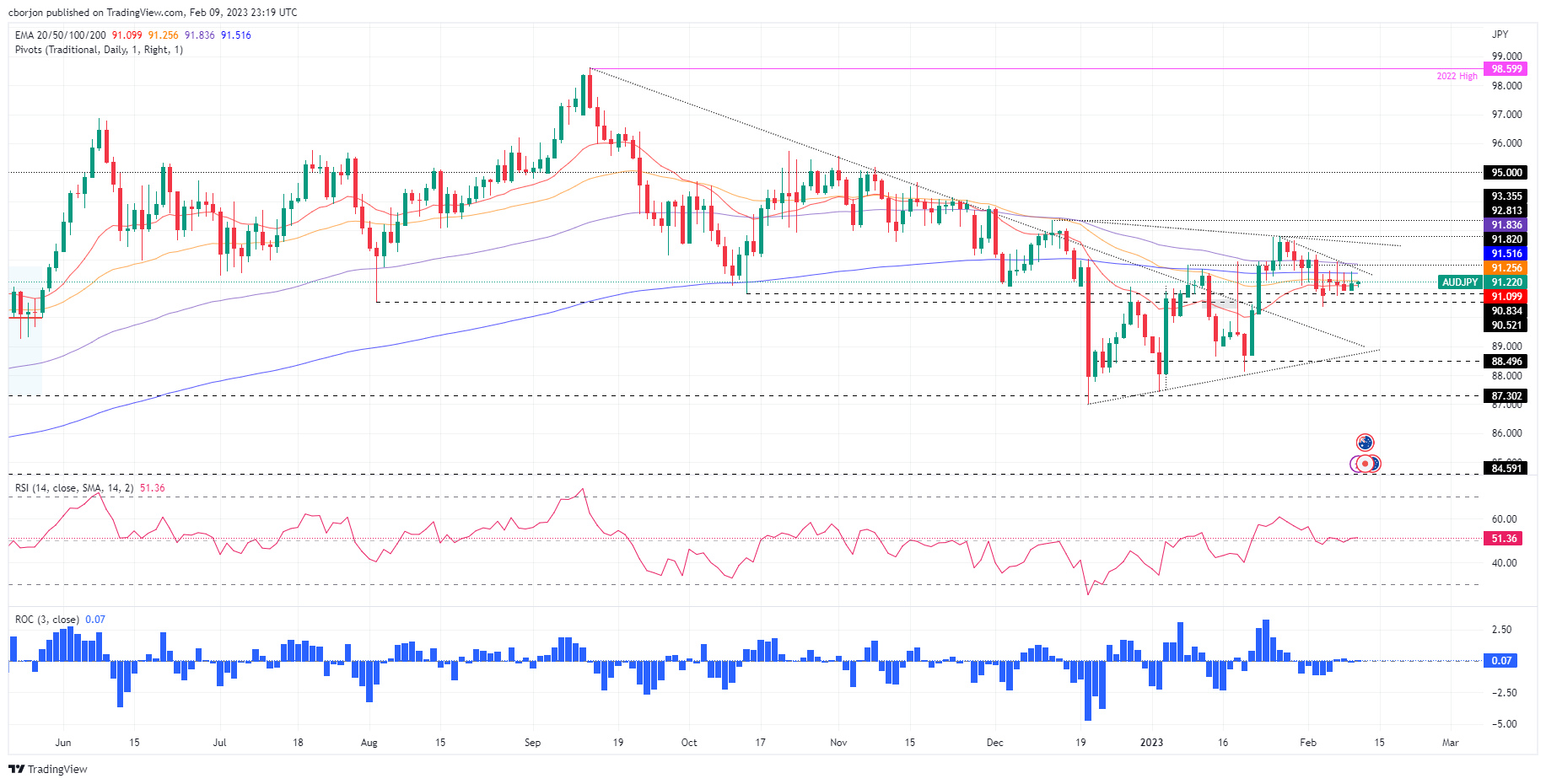
AUD/JPY key technical levels
- EUR/GBP snaps four-day downtrend ahead of the preliminary readings of the UK Q4 GDP.
- Key SMA confluence put a floor under the prices but downbeat oscillators keep sellers hopeful.
- Convergence of weekly descending trend line and monthly horizontal resistance area highlight 0.8890-95 as the key hurdle for bulls.
EUR/GBP picks up bids to pare weekly losses around 0.8865, extending the previous day’s rebound from the one-week low during early Friday. In doing so, the cross-currency pair snaps a four-day downtrend ahead of the preliminary readings of the UK’s fourth quarter (Q4) Gross Domestic Product (GDP) data.
Also read: UK GDP Preview: Growth to stagnate but recession narrowly averted
Other than the pre-data moves, the convergence of the 100-SMA and the 200-SMA, close to 0.8835 by the press time, also challenge the downside bias.
However, bearish MACD signals and a downward trajectory from the last Friday, as portrayed by the short-term descending trend line, tease sellers ahead of the key UK data. Adding strength to the downside bias could be the sluggish RSI (14).
That said, the aforementioned resistance line joins a one-month-old horizontal area to challenge the EUR/GBP bulls around 0.8890-95.
Also acting as an upside filter is the 0.8900 round figure, a break of which could propel prices towards the monthly high surrounding 0.8980 and then to the 0.9000 round figure.
On the flip side, the stated SMA confluence near 0.8835 becomes crucial support for the EUR/GBP bears to watch during the quote’s fresh downside.
Following that, an ascending support line from January 19, near .8820, holds the gate for the EUR/GBP sellers.
EUR/GBP: Four-hour chart

Trend: Limited recovery expected
- GBP/JPY has sensed selling pressure around 159.50 ahead of UK GDP data.
- The settlement of the UK GDP for the fourth quarter in a positive manner will confirm that the UK economy is not in a recession.
- Investors are awaiting the list of nominations for the successor of BoJ Governor Haruhiko Kuroda.
The GBP/JPY pair has dropped below 159.20 after demonstrating a loss in the upside momentum post printing a fresh three-day high at 159.50 in the early Asian session. The cross has corrected marginally as investors are getting anxious ahead of the release of the United Kingdom’s preliminary Gross Domestic Product (GDP) (Q4) data.
The odds of a recession in the UK economy in 2023 are extremely higher as the Bank of England (BoE) has already increased interest rates heavily and more rate hikes are in pipeline. Also, the cost of living pressures is critically expensive due to higher food prices. In addition to that, the UK government is not interested in providing monetary support to the economy as it is already busy containing the pile-up debt mess itself.
Therefore, the GDP data for the fourth quarter of CY2022 carries significant importance. In the past three quarters, the GDP numbers have contracted once and a finish of the fourth quarter in a positive manner will confirm that the UK economy is not in a recession for now.
Meanwhile, commentary from Bank of England (BoE) Governor Andrew Bailey on Thursday kept the Pound Sterling solid. BoE Bailey cited "We expect inflation to come down rapidly this year." He sees the labor market loosening and expects it to show up more in declining vacancies and hours, rather than in higher unemployment."
BoE Chief Economist Huw Pill testifying before the UK Treasury Select Committee cited "There is substantial further monetary policy tightening still to come through as a result of lags in policy transmission."
On the Japanese Yen front, investors are awaiting the list of nominations for the successor Bank of Japan (BoJ) Governor Haruhiko Kuroda. Analysts at Commerzbank believe “The nomination, which is expected to take place next week, is likely to upset the Yen exchange rates quite heavily, regardless of which candidate will emerge as the favorite.”
- USD/CAD is testing horizontal resistance near 1.3450.
- The DXY index W-formation is a bearish reversion pattern which weighs on USD/CAD's outlook.
- On the other hand, should 103.50 give then USD/CAD can enjoy some time higher until next week's US Consumer Price Index.
USD/CAD rallied in the US session following the move back up in the US Dollar. The action occurred in and around the cash open on Wall Street following a combination of half-well-received US data before a risk-off move set in that sent equities off a cliff and high beta currencies packing.
The following illustrates the recent chop the pair has been caught up in and the prospects of a breakout one way or the other.
USD/CAD daily charts
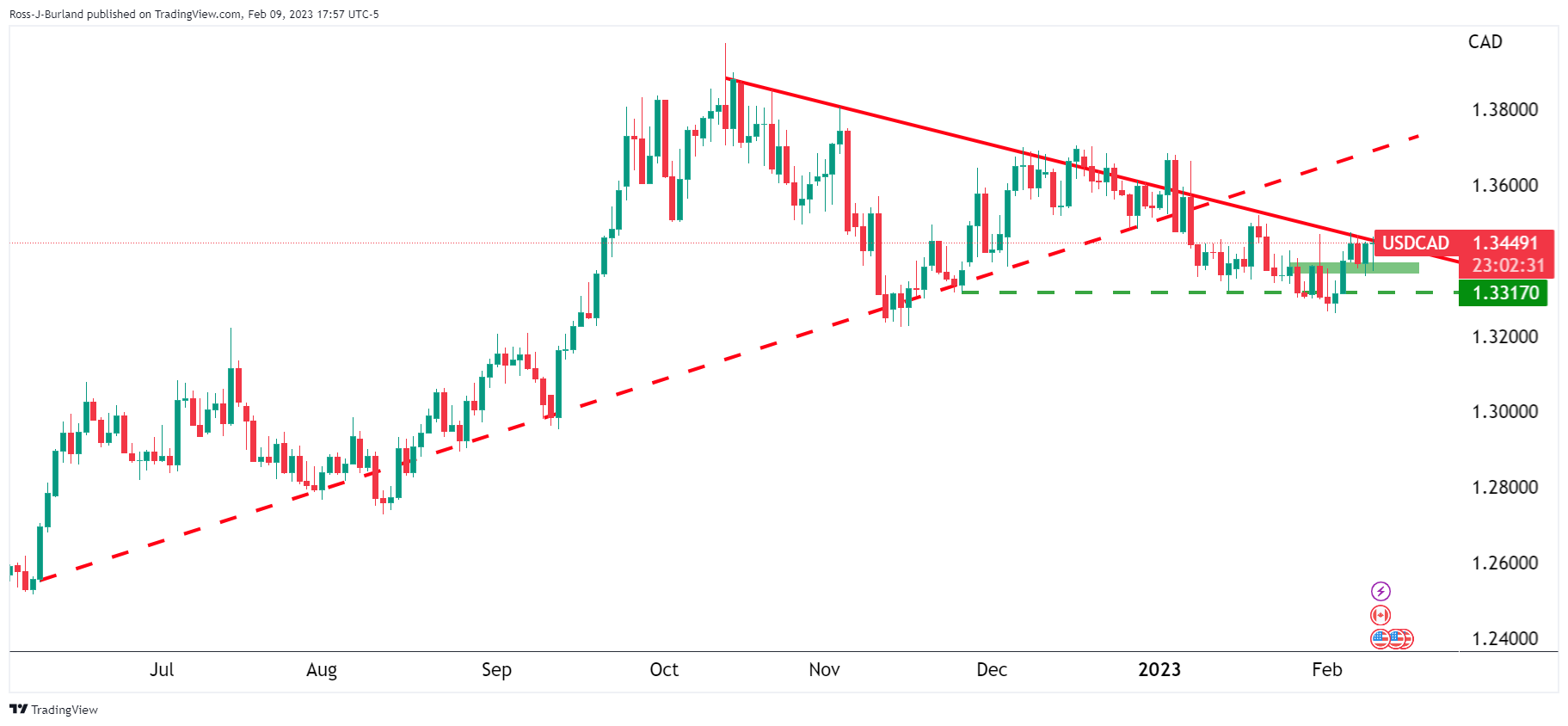
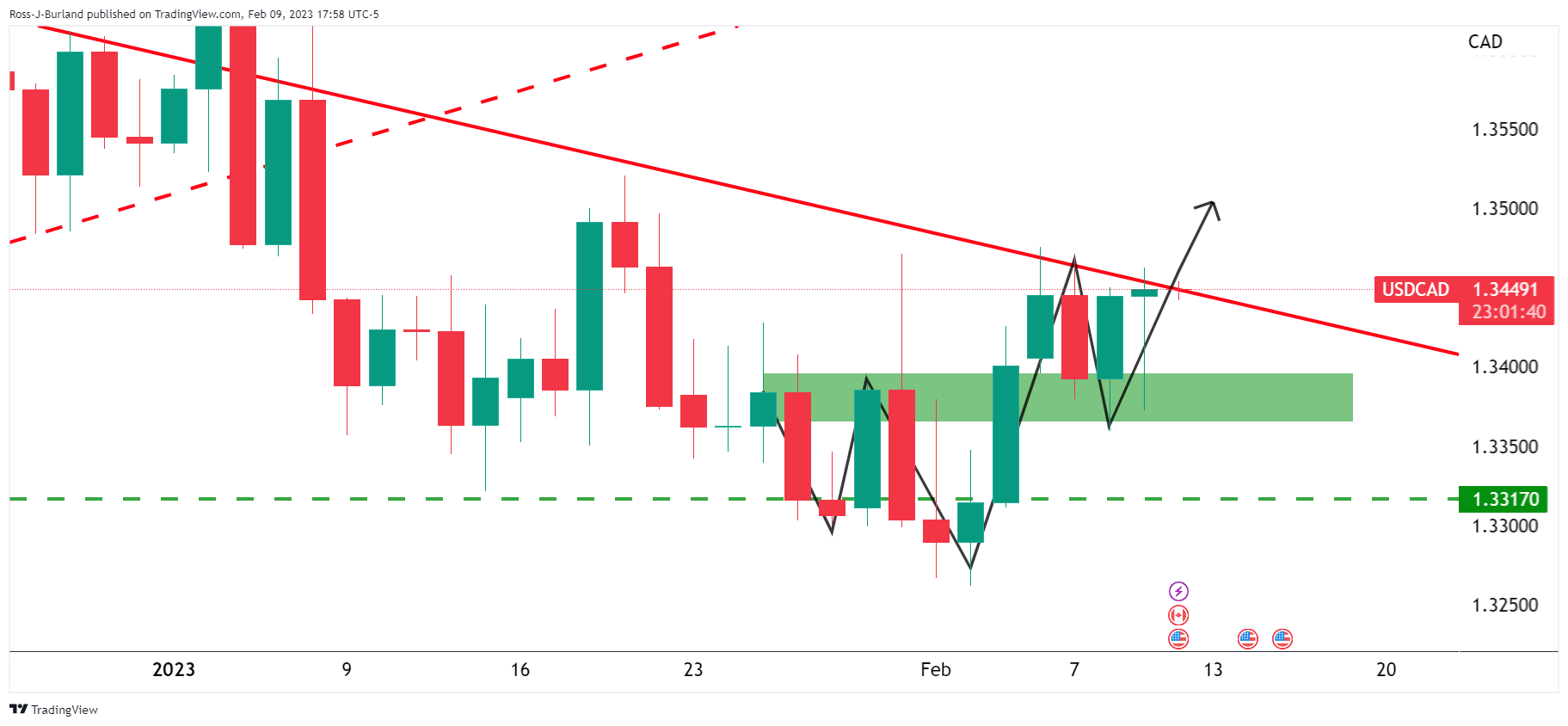
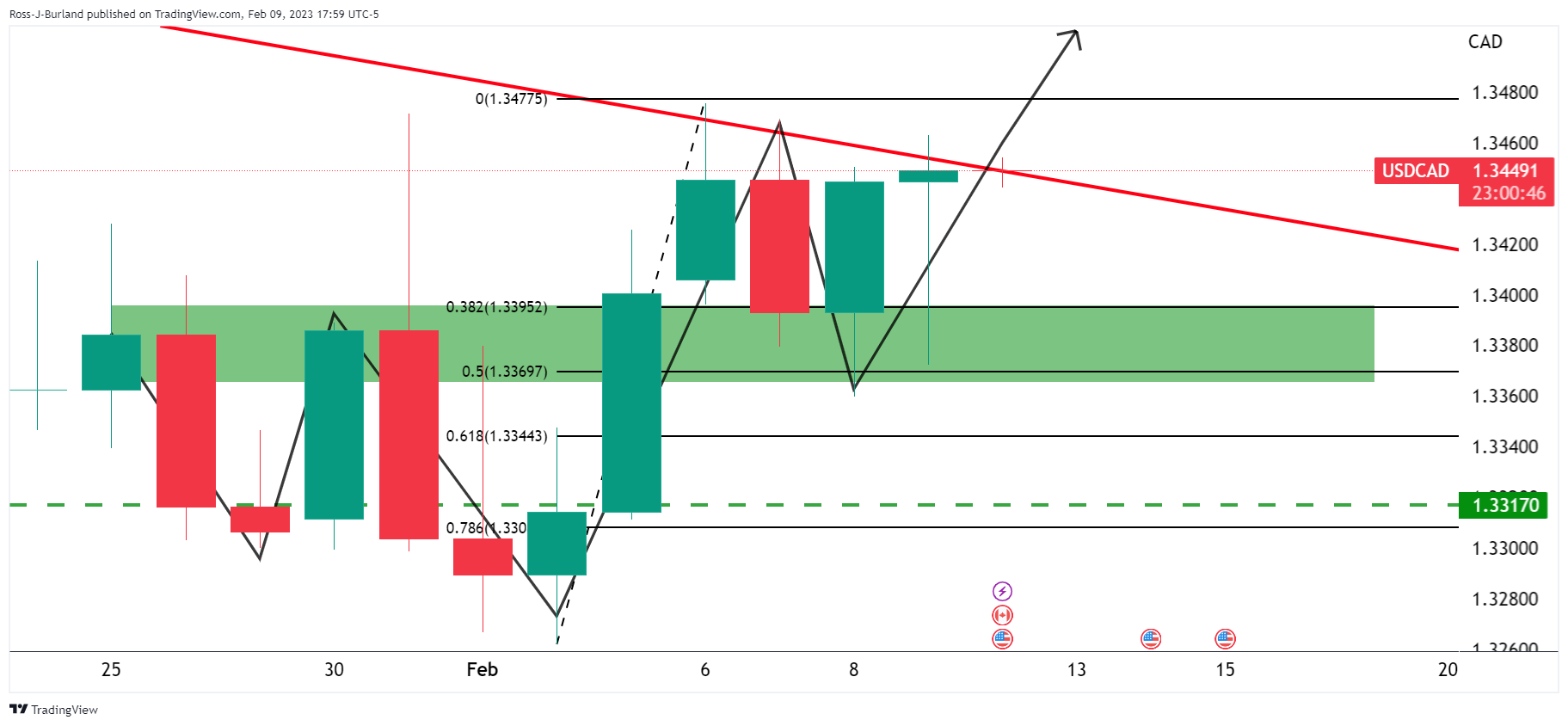
The upside bias, as illustrated above, requires the bulls to commit beyond the trendline resistance in a move that sees the price close above the horizontal resistance near 1.3450 which is currently being tested.
Therefore, the US Dollar's schematic needs to align. However, we are seeing a bearish prospect on DXY as follows:
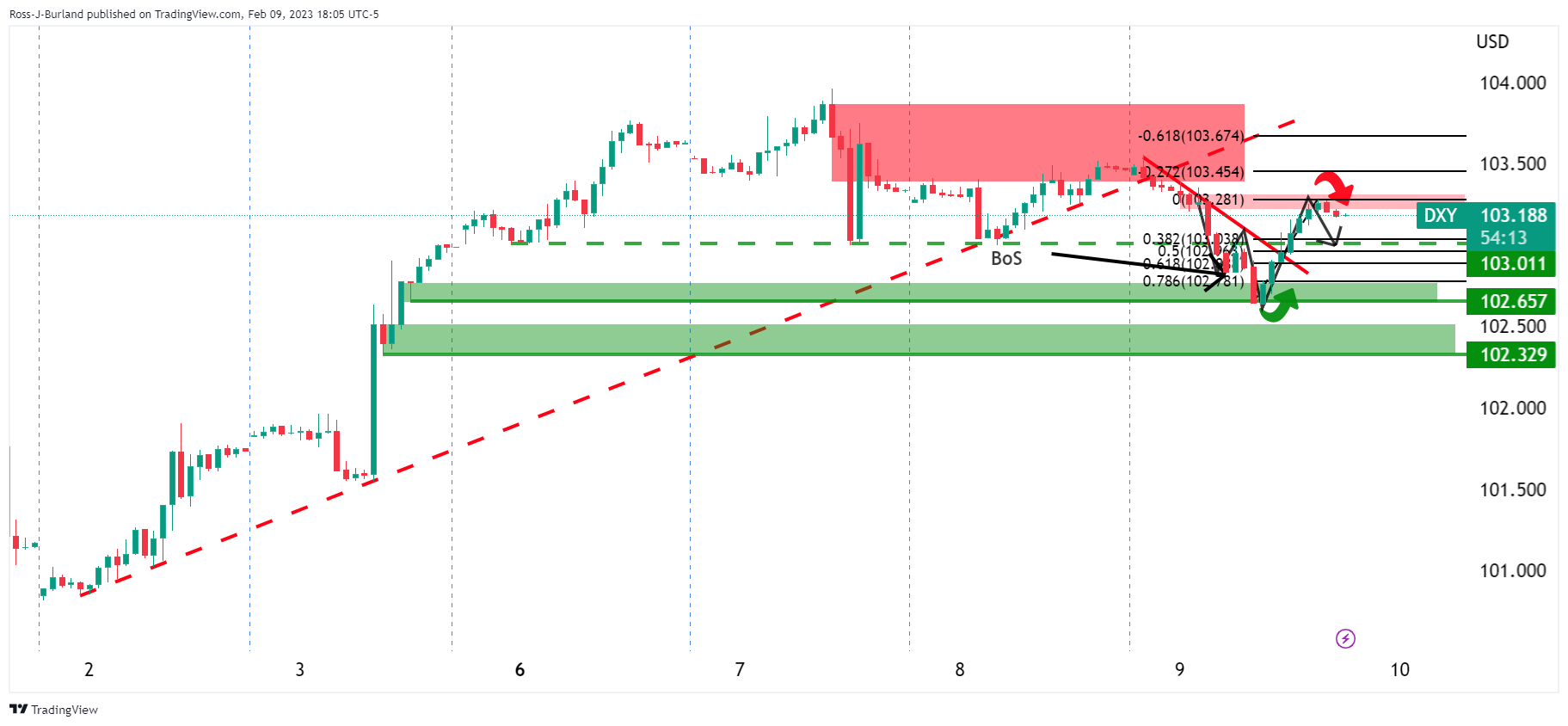
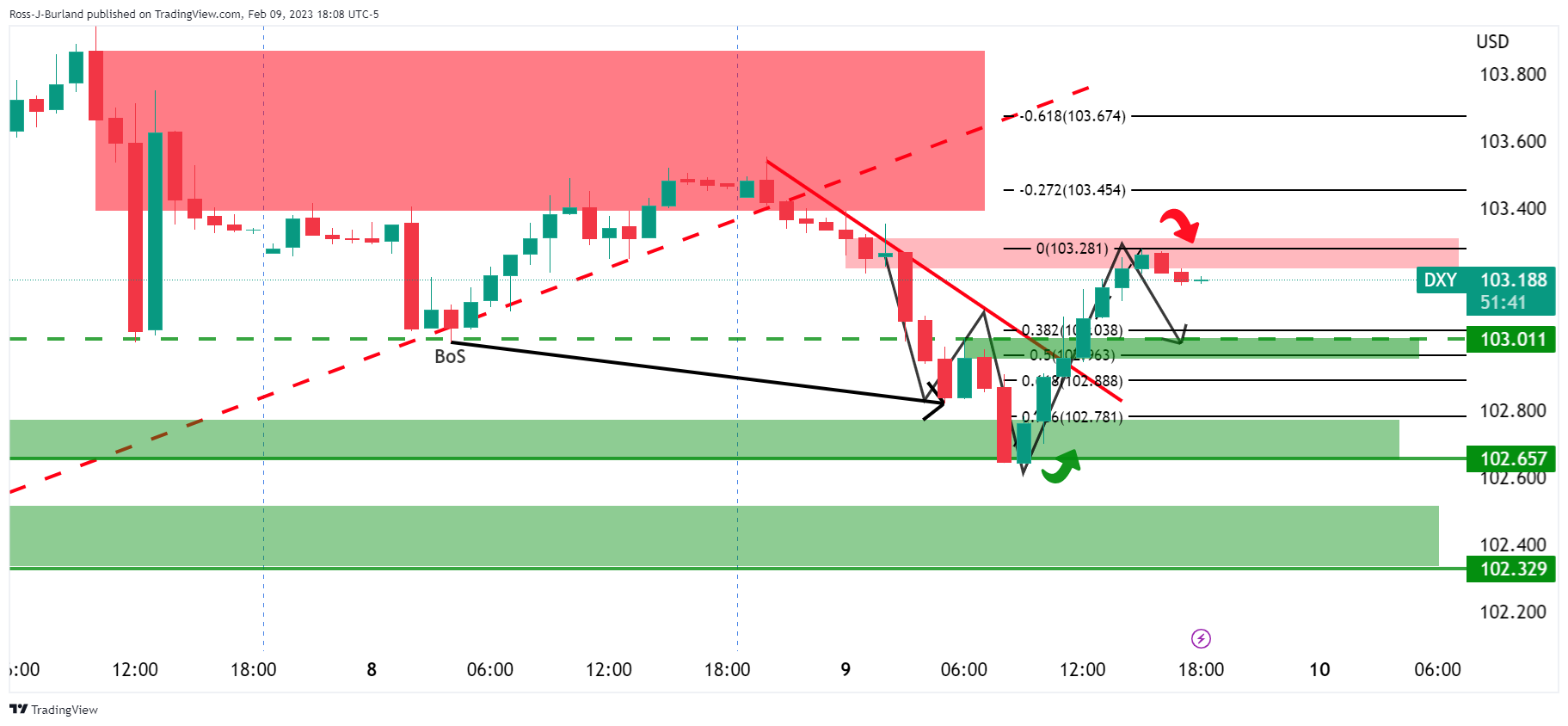
The W-formation is a bearish reversion pattern and the neckline in this case aligns with a 50% mean reversion near 103.00. A break there will see a move lower towards 102.60 and given the prior break of structure, the bias is bearish for a continuation towards 102.30. This is not a good look for USD/CAD.
On the other hand, should 103.50 give then USD/CAD can enjoy some time higher until next week's Consumer Price Index event from the US calendar.
- USD/CHF retreats from recent tops following a stellar bounce off weekly low.
- Fed’s Barkin renewed fears of no more rate hikes from the US central bank, US data adds strength to the concerns.
- Yield curve inversion favored buyers amid a rush to risk safety.
- Preliminary readings of US Michigan Consumer Sentiment Index, 5-year inflation expectations eyed ahead of next week’s US CPI.
USD/CHF bulls take a breather around 0.9220, after posting the biggest daily jump in one week, as traders await the key US data amid mixed feelings. The Swiss Franc (CHF) pair rallied the previous day amid the market’s rush toward the US Dollar amid fears of recession. However, a rethink about the Federal Reserve’s (Fed) next moves join softer US data to probe the pair buyers afterward.
Downbeat prints of the US Weekly Initial Jobless Claims and comments from Richmond Federal Reserve (Fed) President Thomas Barkin seemed to have weighed on the US Dollar during the initial Thursday. Also exerting downside pressure on the greenback was the optimism surrounding China and likely easing in the Sino-American tussles.
That said, the US Weekly Initial Jobless Claims rose to 196K versus 190K expected and 183K prior. “The advance number for seasonally adjusted insured unemployment during the week ending January 28 was 1,688,000, an increase of 38,000 from the previous week's revised level," said the US Department of Labor (DOL) showed on Thursday.
Further, Fed’s Barkin appeared too dovish while suggesting rate cuts as he said that it would make sense for the Fed to steer "more deliberately" from here due to lagged effects of policy. Previously, Fed Chair Jerome Powell hesitated in cheering the upbeat US jobs report and raised fears of no more hawkish moves from the US central bank.
Elsewhere, US President Joe Biden’s taming of fears emanating from the US-China jitters, following the China balloon shooting by the US, joined the hopes of People’s Bank of China’s (PBOC) rate cuts and the restart of the China-based companies’ listing on the US exchanges to favor risk-on mood during early Thursday.
Alternatively, the difference between the 10-year and 2-year Treasury bond yields turned the widest since 1980 as the former prints 3.66% and the latter came in around 4.50%. The same signaled the market’s recession fears and triggered the US Dollar run-up.
Amid these plays, Wall Street closed in the red and the US Dollar Index (DXY) recovered from the weekly low.
Looking ahead, the Swiss calendar is almost empty and hence USD/CHF traders should pay attention to the risk catalysts ahead of the preliminary readings of US consumer-centric numbers for February like the Michigan Consumer Sentiment Index and 5-year Consumer Inflation Expectations. Above all, the market’s preparations for the next week’s US Consumer Price Index (CPI) will be important to watch.
Technical analysis
USD/CHF remains on the bear’s radar unless trading successfully beyond the downward-sloping resistance line from late November 2022, close to 0.9265 by the press time.
- GBP/USD is building a firm cushion around 1.2100 after a sell-off on Thursday.
- An upbeat UK GDP data could avoid recession fears and support the Pound Sterling.
- Fed Barkin warned about the absence of an all-round decline in inflation.
The GBP/USD pair is building a cushion around 1.2110 in the early Tokyo session. The Cable is expected to remain volatile ahead of the release of the United Kingdom's preliminary Gross Domestic Product (GDP) (Q4) data.
The economic data is seen at 0.4% vs. the former release of 1.9% on an annual basis. However, the GDP data could remain flat on a quarterly basis against a contraction of 0.3% disclosed in the third quarter. On a monthly basis, a contraction of 0.3% is expected by the street.
Economists at OCBC Bank cited “UK data dump on Friday is in focus especially after the UK think tank, National Institute of Economic and Social Research (NIESR) predicted that the UK economy is likely to avoid a recession this year. A stronger set of UK data print could validate the think tank's prediction and further unwinding of GBP shorts may well keep GBP supported.”
Apart from that, the commentary from Bank of England (BoE) Governor Andrew Bailey on Thursday kept the Pound Sterling in action. BoE Bailey cited "We expect inflation to come down rapidly this year." He sees the labor market loosening and expects it to show up more in declining vacancies and hours, rather than in higher unemployment."
The market sentiment is quite negative as concerns about further policy tightening by the Federal Reserve (Fed) are still haunting the risk-sensitive currencies. S&P500 futures witnessed downside consecutively for the second day after Richmond Fed President Thomas Barkin raised the question that the inflation slowdown in the United States has been an outcome of a decline in the price of a few goods. An overall decline is yet to be seen, which makes the Consumer Price Index (CPI) heavily stubborn.
Concerns over further interest rate hikes pushed the US Dollar Index (DXY) to near 103.00 after a vertical fall. The yields provided on 10-year US government bonds roared firmly above 3.66%.
For further guidance, investors will keep an eye on the release of the US CPI data, which is scheduled for Tuesday. The economic data is expected to decline amid a continuation of interest rate hikes by the Fed.
- NZD/USD extends late Thursday’s pullback from weekly high inside bearish chart pattern.
- RSI, MACD conditions suggest buyers are running out of steam while pullback from 200-SMA strengthens downside bias.
- Late January’s swing low adds to the upside filters before welcoming Kiwi buyers.
NZD/USD teases sellers inside a bearish formation as it drops to 0.6320 during the early hours of Friday morning in New Zealand. In doing so, the Kiwi pair extends the late Thursday pullback from the one-week high.
In addition to the weekly bear flag chart pattern, the quote’s inability to cross the 200-SMA also teases the sellers. Furthermore, the receding strength of the bullish MACD signals and the sluggish rise in the RSI adds strength to the downside bias.
However, a clear downside break of the stated flag’s lower line, close to 0.6315 by the press time, becomes necessary to trigger a theoretical fall towards the mid-November 2022 low surrounding 0.6065.
That said, monthly lows marked so far during 2023, around 0.6270 and 0.6190, could offer intermediate halts during the anticipated slump between 0.6315 and 0.6065.
Alternatively, the 50% Fibonacci retracement level of the NZD/USD pair’s January-February upside, near 0.6365, could act as an immediate resistance to watch during the recovery.
Following that, the 200-SMA and the stated flag’s top line, respectively near 0.6385 and the 0.6400 threshold, will be crucial to watch as they hold the keys to the NZD/USD bull’s entry.
NZD/USD: Four-hour chart

Trend: Further downside expected
- Silver shifted bearish following Thursday’s daily close below the 200-DMA
- Silver Price Analysis: A downward condition is expected with price action and RSI’s coinciding on its bearish bias.
Silver price slides below a bottom-trend line of a bearish megaphone formation and is testing the 200-day Exponential Moving Average (EMA) at around $21.95. At the time of writing, the XAG/USD exchanges hands at $21.97.
From a daily chart perspective, XAG/USD threatens to crack the 200-day EMA, which, if accomplished, it could pave the way for further losses. In addition, oscillators turned bearish, notably the Relative Strength Index (RSI), while the Rate of Change (RoC) is almost flat, depicting that neither buyers/sellers are in control.
However, XAG/USD’s daily close below the 200-day EMA could send Silver prices diving. The next support area would be the $21.00 psychological price level, followed by the November 28 daily low of $20.87 and the November 21 low of $20.59.
As an alternate scenario, the XAG/USD’s first resistance would be the psychological $22.00 mark. A breach of the latter would expose a support-turned-resistance bottom trendline of the megaphone formation at $22.40, followed by the high of the week at $22.59.
Silver Daily Chart
Silver key technical levels
- AUD/USD picks up bids to reverse late Thursday’s losses from weekly top.
- US Dollar initially fell on downbeat US data, Fed speak before watching yield curve inversion to recover from one-week low.
- Market sentiment remains dicey despite upbeat headlines surrounding China.
- China inflation, RBA Statement of Monetary Policy eyed ahead of US consumer-centric data.
AUD/USD licks its wounds around 0.6930-40, following an 80-pip downturn in the last few hours, as the Aussie pair traders brace for the Reserve Bank of Australia’s (RBA) Statement of Monetary Policy (SoMP) during early Friday. In addition to the RBA’s SoMP, the preliminary readings of US consumer-centric numbers for February like the Michigan Consumer Sentiment Index and 5-year Consumer Inflation Expectations also decorate the calendar and allowed the quote to pare recent losses. Furthermore, China’s headlines Consumer Price Index (CPI) and Producer Price Index (PPI) for January will also be important for immediate directions.
The Aussie pair initially rose to the weekly high on upbeat China-linked headlines and the US Dollar’s downbeat performance due to the softer US data and dovish Fedspeak. However, the market’s fears of recession, backed by the yield-curve inversion and mixed mood ahead of the top-tier data/events seemed to have triggered the AUD/USD downturn ahead of the latest consolidation.
US Weekly Initial Jobless Claims rose to 196K versus 190K expected and 183K prior. “The advance number for seasonally adjusted insured unemployment during the week ending January 28 was 1,688,000, an increase of 38,000 from the previous week's revised level," said the US Department of Labor (DOL) showed on Thursday.
On the other hand, Richmond Federal Reserve (Fed) President Thomas Barkin said on Thursday that it would make sense for the Fed to steer "more deliberately" from here due to lagged effects of policy.
It should be noted that the receding fears of the US-China jitters, following the China balloon shooting by the US, join the hopes of People’s Bank of China’s (PBOC) rate cuts and the restart of the China-based companies’ listing on the US exchanges to favor risk-on mood in the bloc.
That said, the difference between the 10-year and 2-year Treasury bond yields turned the widest since 1980 as the former prints 3.66% and the latter came in around 4.50%. The same signaled the market’s recession fears and triggered the US Dollar run-up.
Moving on, the RBA SoMP will be watched closely to confirm the Aussie central bank’s hawkish bias, as perceived from the latest monetary policy meeting. In a case where the statement lacks details to back the optimism among the policymakers, the AUD/USD could extend the losses.
Following that, China’s CPI and PPI will be observed due to the Aussie-China ties and also because of the latest mixed data from the world’s largest commodity user. Although the forecasts for the yearly inflation numbers for January are impressive, the pair bears could cheer a softer outcome.
Above all, the early signals for the next week’s US inflation data, as well as the first prints of the US consumer confidence, gain major importance due to the Fed policymakers’ indecision and mixed signals from the economics of late.
Technical analysis
Another failure to cross the 21-DMA hurdle, around the 0.7000 round figure, directs AUD/USD towards the 50-DMA, around 0.6870 by the press time.
- EUR/USD is juggling above 1.0730, likely to remain volatile ahead of US Indflation.
- Fed Barkin argued that majority of inflation slowdown is backed by a few goods.
- A decline in the German inflation might not trim the hawkish ECB bets.
The EUR/USD pair is displaying back and forth moves marginally above 1.0730 in the early Asian session. The major currency pair is oscillating at a make or a break level as solid upside action by the Euro on Thursday met with significant offers and dropped with similar pace in the New York session. A further decline in EUR/USD will drag the asset vigorously.
The sell-off move in the shared currency pair triggered as investors shifted their focus towards the release of the United States Consumer Price Index (CPI), which is scheduled for Tuesday. The US Dollar Index (DXY) recovered firmly after dropping to near 102.28. The USD Index is still below 103.00, however, the risk-aversion market theme could result in more gains for the safe-haven assets.
Meanwhile, S&P500 ended Thursday on a weaker note. Opening gains faded and a bearish drive settled Thursday’s session on a negative note as Federal Reserve (Fed)’s higher rate concerns refreshed after commentary from Richmond Fed President Thomas Barkin. The return generated by 10-year US Treasury bonds recovered sharply and scaled above 3.66%.
Fed Barkin argued that it would make sense for the Fed to steer "more deliberately" from here due to lagged effects of policy, as reported by Reuters. He further added that "While average inflation has peaked, the decline has been distorted by a few goods, median has stayed high."
On the Eurozone front, German Harmonized Index of Consumer Prices (HICP) dropped to 9.2% vs. the consensus of 10.0% and the former release of 9.6%. The inflationary pressures have surprisingly slowed, however, the odds of a continuation of bumper interest rate hikes by the European Central Bank (ECB) are still solid. The inflation rate is still hovering at extremely elevated levels, which needs a monetary policy sufficient restrictive to tame inflation.
- Oil installations around Turkey and Syria had reported no or minor damages, which capped WTI’s drop.
- Fed hawkish commentary capped WTI’s rally toward $80.00.
- WTI Price Analysis: To remain downward biased, eyeing $73.00.
WTI creeps lower after testing weekly highs around $78.80 and drops toward the $77.70 area on Thursday amid further hawkish Fed speaking pushing back against Fed Chair Powell’s comments on Tuesday. In addition, speculation of damages to oil infrastructure following an earthquake in Turkey and Syria faded, which remained intact. At the time of writing, WTI exchanges hands at $77.63 per barrel.
Worries about an earthquake that hit Turkey and Syria at the beginning of the week, which has killed more than 19,000 people, was a tailwind for US crude oil prices amidst growing concerns about damaging pipelines and oil infrastructure. Even though spurred a shut off for some days, sources cited by Reuters said “We won’t be losing that supply for as long as we thought.”
An additional factor that undermined oil prices was a stunning jobs report in the United States (US), keeping investors unease amid speculation that the US Federal Reserve would continue to tighten monetary conditions aggressively to an already slowing economy.
Meanwhile, the prospects of solid demand from China, amidst its relaxation of Covid-19 measures, backed WTI prices, as reports showed that Chinese oil consumption would increase crude output by 1 million barrels a day.
That said, WTI’s snapped three days of consecutive gains, peaking around the 50-day EMA at $78.69, exacerbating a fall to the 20-day EMA at $77.71.
WTI Technical analysis
Technically speaking, WTI prices appear to have peaked at around the 50-day EMA during the current week. Even though oil is printing a hanging man, a bearish signal, it’s also in the process of forming a bearish engulfing candle pattern, which would trigger a stronger downward reaction that could lower prices.
Therefore, WTI’s first support would be $77.00 PB. A breach of the latter and oil prices will aim toward the February 7 daily low of $74.40, ahead of the weekly low of $72.30.
- Gold price is tinkering on the edge of a collapse to $1,825.
- United States of America Consumer Price Index next week will be key for the Gold price.
Gold price was falling on Thursday in a US session sell-off that followed a spike leading into the cash open on Wall Street where heightened volatility led to the collapse of the Gold price. The US Dollar, despite the dovish take on the Federal Reserve, rallied which sank all ships on the day.
US Dollar rises despite dovish Federal Reserve comments
The US Dollar was lit up from the lows of 102.50 in the DXY index that measures the US Dollar vs. a basket of currencies. The Gold price tends to weaken in risk-off scenarios that have carried the US Dollar oy of the Federal Reserve sentiment-induced doldrums of late.
Markets are neither here nor there when it comes to a definitive notion around the Federal Reserve's outlook. The jury is still out as to whether there will indeed be a pivot in the second half of the year that has otherwise been borne out of some dovish rhetoric from the Federal Reserve's chairman, Jerome Powell of late.
In view of the strength of the US January Nonfarm Payrolls data, markets were expecting Federal Reserve's Jerome Powell to double down on his hawkish rhetoric. So, when he used the word ‘disinflation’ early on, this was a trigger for a relief rally in stocks and a dip in treasury yields.
However, the US Dollar and Gold price have been volatile on both sides of the sentiment and Powell described ‘disinflation’ as being in the very early stages. He also emphasised that “the base case for me is that…we’ll have to do more rate increases, and then we’ll have to look around and see whether we’ve done enough”. So, there is still the prospect of a higher terminal rate and that is weighing on the Gold price when it rallies.
''The discussions I’ve been having with clients definitely turned towards the possibility and implications of the Fed going well beyond the 5-5.25 peak everyone has been forecasting,'' Kit Juckes, an economist at Societe Generale said in a note.
''Glancing at the Bloomberg economists’ survey there are quite a few banks that think we’ll be at 5 ¼ well into 2024, but no-one has yet put down a 5 1/2 % peak, let alone something higher,'' he explained. ''The obvious answer is that a 5 ½% peak, instead of 5 ¼%, means little, but 6% increases the risk of the cycle ending messily. And that would support for the US Dollar and be bad for risk-sensitive currencies everywhere,'' he added.
Gold price, a case for lower
The Gold price would also be pressured in such a scenario. In fact, analysts at TD Securities are already calling for lower and argue that Gold price may well still be overbought.
Key notes
''Our tracking of positioning for the top traders in Shanghai gold has pointed to notable liquidations over the past weeks, but this cohort's gold length is now at sub-average levels relative to the last year,'' the analysts explained.
''This suggests the pace of Chinese selling could slow, leaving investors as the marginal buyer or seller. At the same time, however, we don't expect any downside flow from CTAs until prices break the $1,840/oz range. And, we argue that notable selling activity from CTAs will likely be elusive above the $1,800/oz mark,'' the analysts added.
''In contrast, the margin of safety against a marginal buying program is razor thin above $1900/oz. Discretionary money manager positioning also appears flat. Overall, this suggests that the slump in precious metals prices could be limited without data corroborating a more hawkish path ahead.''
Gold price, what's in store on the Economic Calendar?
It could be a turbulent week ahead with US Consumer Price Index, CPI, and Retail Sales.
US Consumer Price Index key for Gold price
CPI is expected to show headline inflation for January at 0.5% MoM and core inflation running at 0.3% MoM. ''If these numbers are achieved this would result in an easing of core inflation from 5.7% to 5.4% YoY and headline inflation from 6.6% to 6.2%,'' the analysts at ANZ Bank explained, noting also Retail Sales and manufacturing data er due.
''If we continue to see strength in these data, then it will be very difficult for Federal Reserve policymakers to signal anything other than a further tightening of monetary policy.''
Gold technical analysis
As per the prior Gold price analysis, where it was stated that The Gold price was correcting to a 38.2% Fibonacci retracement level within a 1000 pip box, the downside played out as follows:
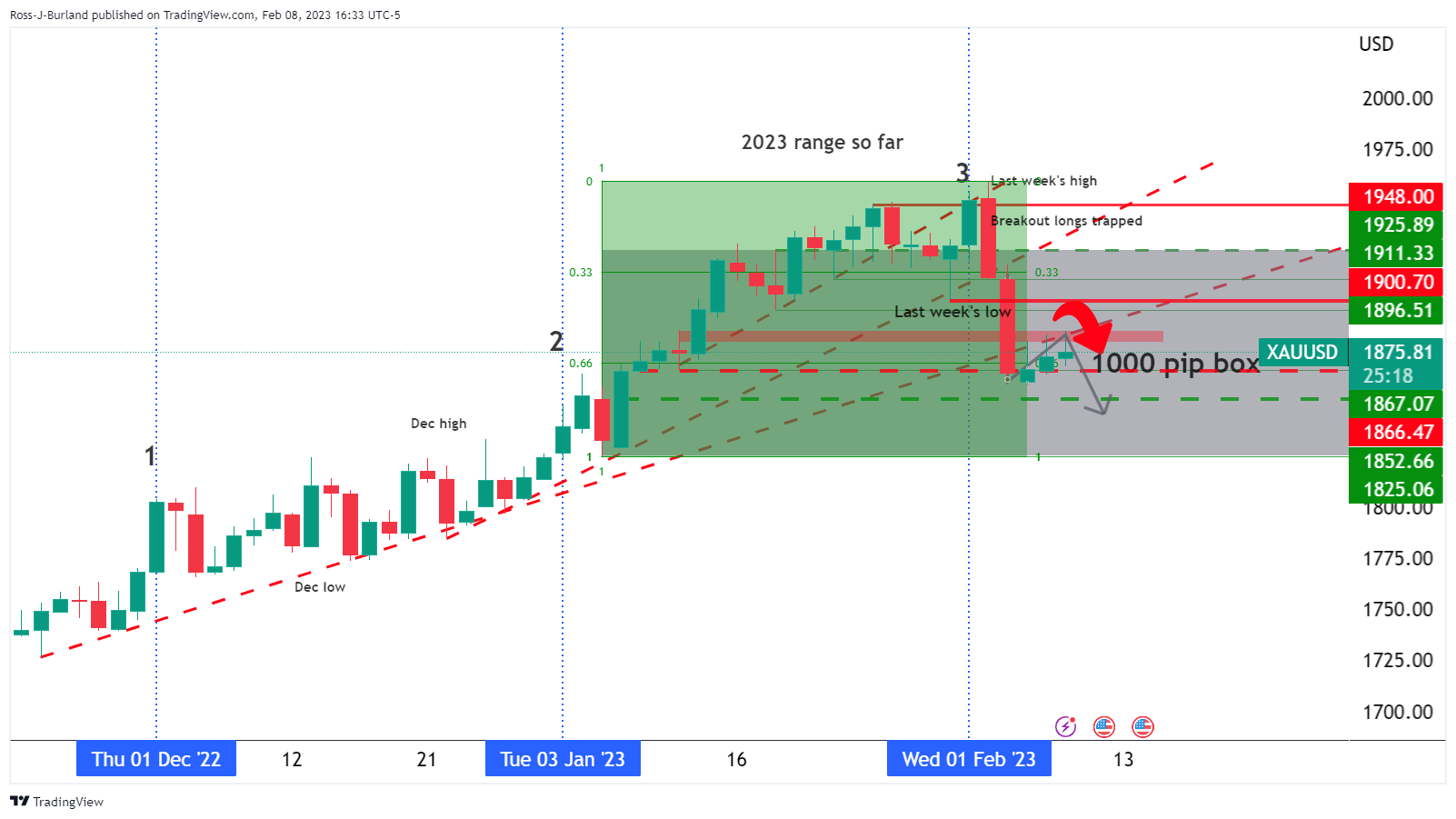
(Before)
After:
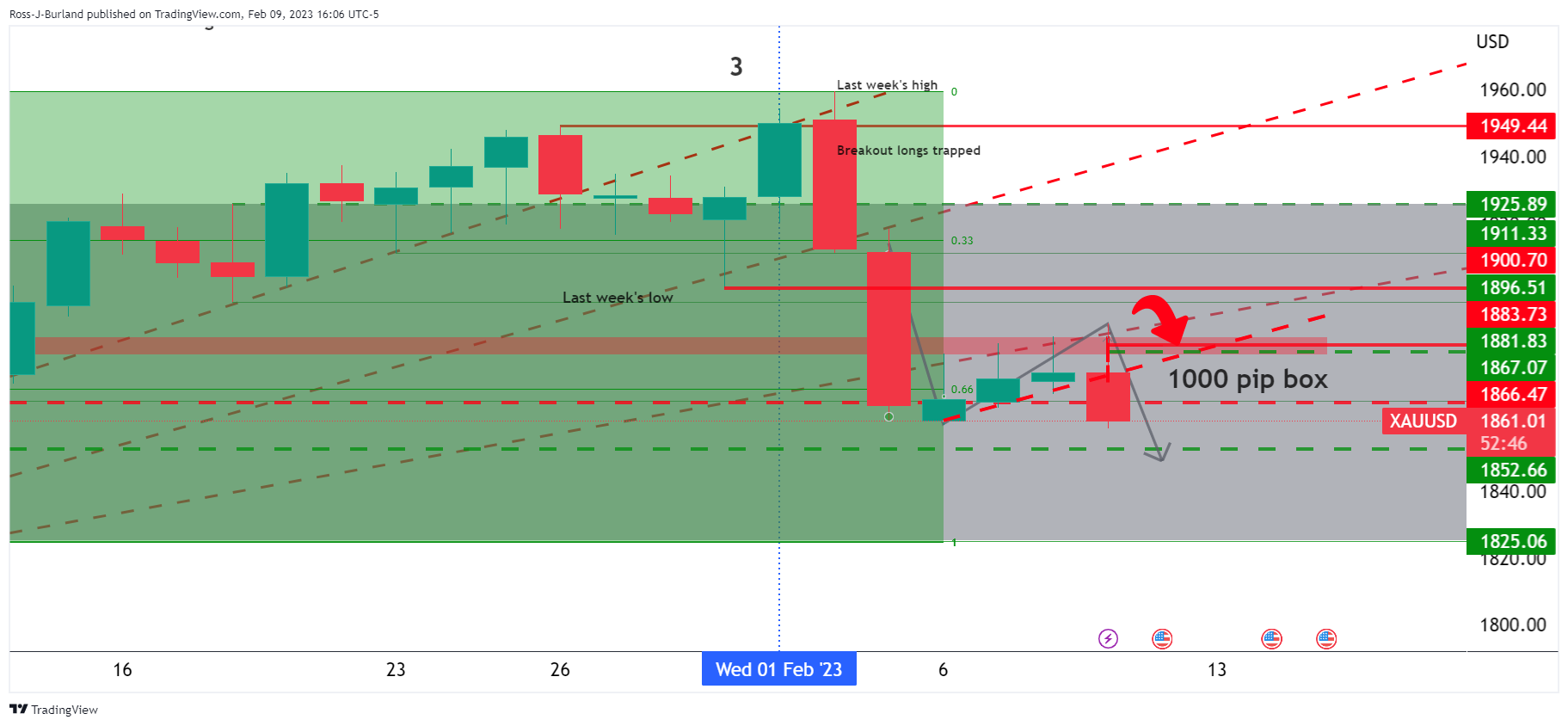
The move this week in Gold price was forecasted at the start of the week's per-open analysis, an article that is produced each Sunday for the week ahead: Gold, the Chart of the Week: XAU/USD breakout traders triggered in, bear traps being laid down
What you need to take care of on Friday, February 10:
The US dollar gained upward traction ahead of Wall Street's opening, accelerating its advance at the end of the day as US indexes plunged ahead of the close. The most notorious decline was XAU/USD, reaching a fresh weekly low of $1,859.72 a troy ounce. It bounced modestly from the level but trades at its lowest in over a month.
The EUR/USD pair approached 1.0800 but faltered ahead of the level and trades at around 1.0740. The German Harmonized Index of Consumer Prices (HICP) unexpectedly rose by 9.2% YoY in January, below the 10% expected and easing from the previous 9.6%.
The US Dollar benefited from higher government bond yields but also from comments from Richmond Federal Reserve President Thomas Barkin, who said that the effects of the Fed's policy tightening has been substantial while adding that macroeconomic data put back the risk of a recession.
At the time being, the yield on the 10-year Treasury note stands at 3.67%, up 4 bps, while the 2-year note offers 4.50%, up 5 bps.
GBP/USD peaked at 1.2191, holding on to gains but currently trading at around 1.2120. The Bank of England (BoE) Monetary Policy Report Hearings provided support to the Pound. Governor Andrew Bailey, Chief Economist Huw Pill and policymaker Jonathan Haskel testified before the UK Treasury Select Committee. Among other things, they said that they expect inflation "to come down rapidly this year." However, policymaker Silvana Tenreyro later in the day noted that, in her view, rates are now too high, and a massive recession would be needed to push inflation down to 2%. She finally added she would consider a rate cut.
Japan's Prime Minister Kishida is expected to name BOJ Governor Kuroda's successor next week. Speculation revolves around whether Kishida will choose a more aggressive leader for the central bank that will end the ultra-loose monetary policy. The Japanese Yen edged lower in America, with USD/JPY trading at around 131.50, after falling to an intraday low of 130.33 at the beginning of the day.
Commodity-linked currencies trimmed early gains vs their American rival. AUD/USD trades at around 0.6940, while USD/CAD stands at 1.3450.
Top 3 Price Prediction Bitcoin, Ethereum, Ripple: Crypto Season coming close to the end
Like this article? Help us with some feedback by answering this survey:
- NZD/USD popped and dropped in the US session.
- All eyes point to the US data next week.
NZD/USD traded in a similar fashion to the Aussie on Thursday, which technicals are shown here. Ahead of the Wall Street close, the Kiwi is trading around 0.3% lower on the day at 0.6328 and has fallen in the New York session within a range of 0.6389 and 0.6302.
NZD/USD and AUD/USD both dropped when the London fix and Wall Street's cash open kicked in, propelling the price below higher timeframe traders' fresh long positions up high on the day. In the case of the Kiwi, bulls chasing the breakout above 0.6370 were put under heat straight away as the price fell sharply towards the 0.6350s.
On the day, the US dollar was being thrown around, initially offered and breaking structure in the case of the DXY index as follows:
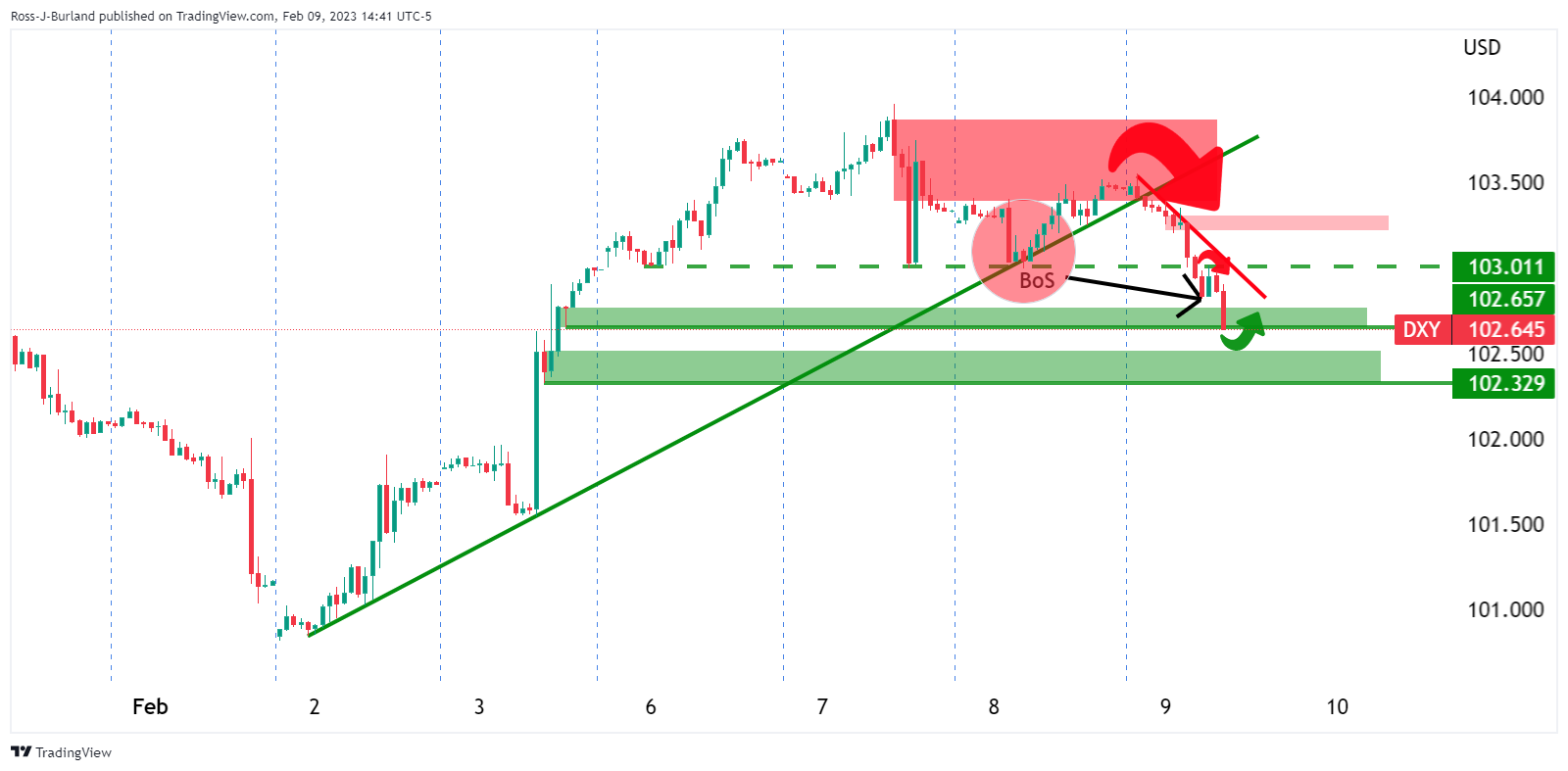
However, the bulls moved in:
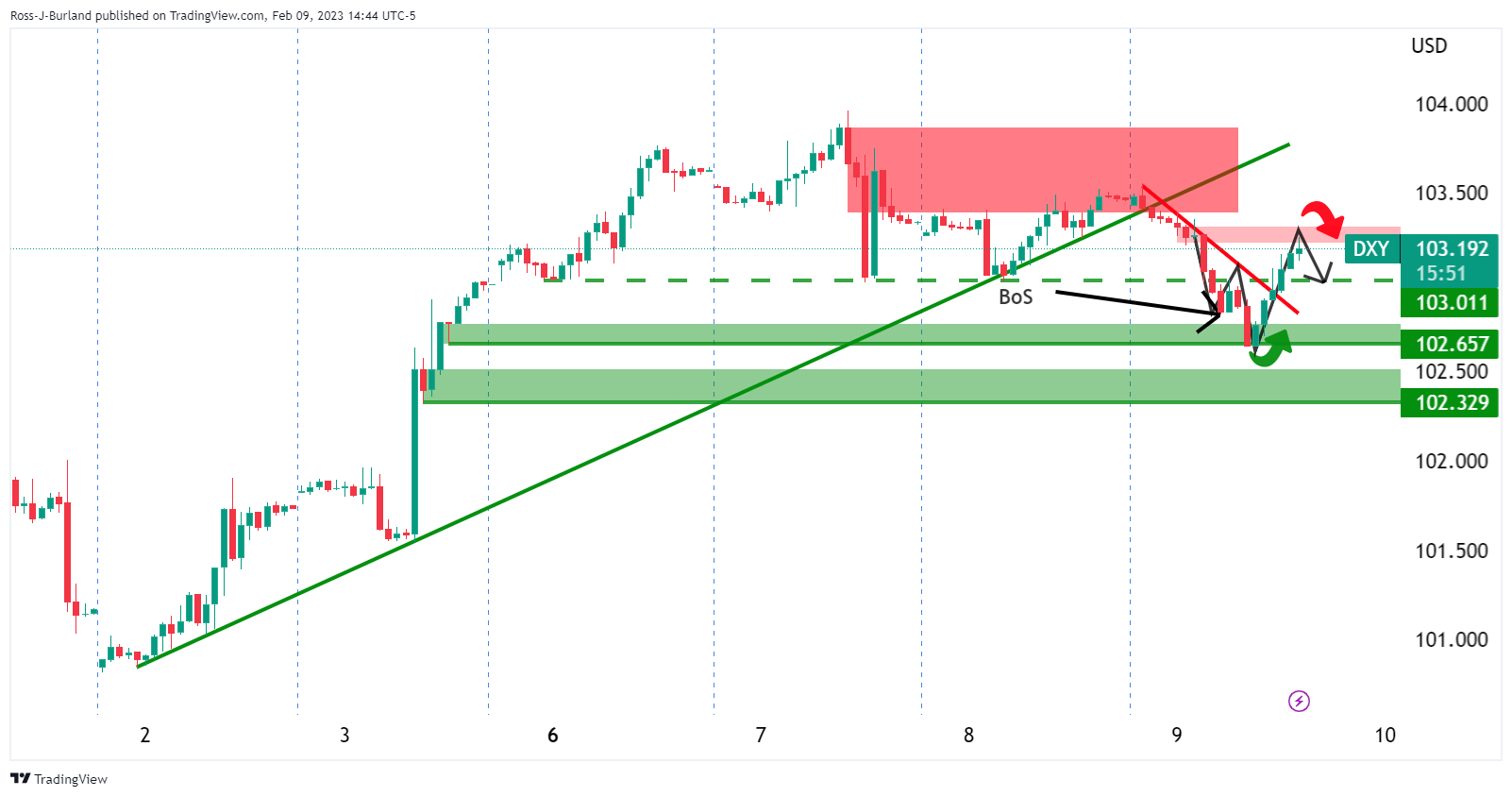
The labour market has not been what the Federal Reserve is hoping for and Thursday's Jobless Claims revealed risks of a tighter for a longer scenario given there was only a small uptick in unemployment numbers. ''Initial Jobless Claims lifted to 196k in the week to February 4, while Continuing Claims also lifted.
''The weekly jobless claims data can bob about so one reading does not indicate a trend. The total number of jobless claims at present is also still quite low,'' analysts at ANZ Bank argued.
Meanwhile, looking ahead to the week, the US inflation Consumer Price Index is due to be released and the data is expected to show headline inflation for January at 0.5% MoM and core inflation running at 0.3% MoM. ''If these numbers are achieved this would result in an easing of core inflation from 5.7% to 5.4% YoY and headline inflation from 6.6% to 6.2%,'' the analysts at ANZ Bank explained, noting also Retail Sales and manufacturing data er due.
''If we continue to see strength in these data, then it will be very difficult for Federal Reserve policymakers to signal anything other than a further tightening of monetary policy.''
- AUD/USD bulls eye a move to 0.6970s in a 61.8% Fibonacci retracement.
- The downside target is near 0.6920/10 which guards 0.69 the figure.
AUD/USD fell in the London fix and around the Wall Street cash open where most of the damage was done given a break of structure with trapped volumes up high chasing the parabolic move.
The higher time frame traders that bought the break of 0.7000 on the hourly chart were caught up high and the price subsequently dropped from the highs of the day at 0.7011 and fell to a New york session low of 0.6942. The following hourly charts illustrate that there are now prospects of a correction higher before the next move lower:
AUD/USD H1 chart

The price corrected to a 50% mean reversion area before plummeting on Thursday to dynamic trendline support. The bulls would now be anticipated to m, make a move encouraged but the M-formation:
Zoomed in:
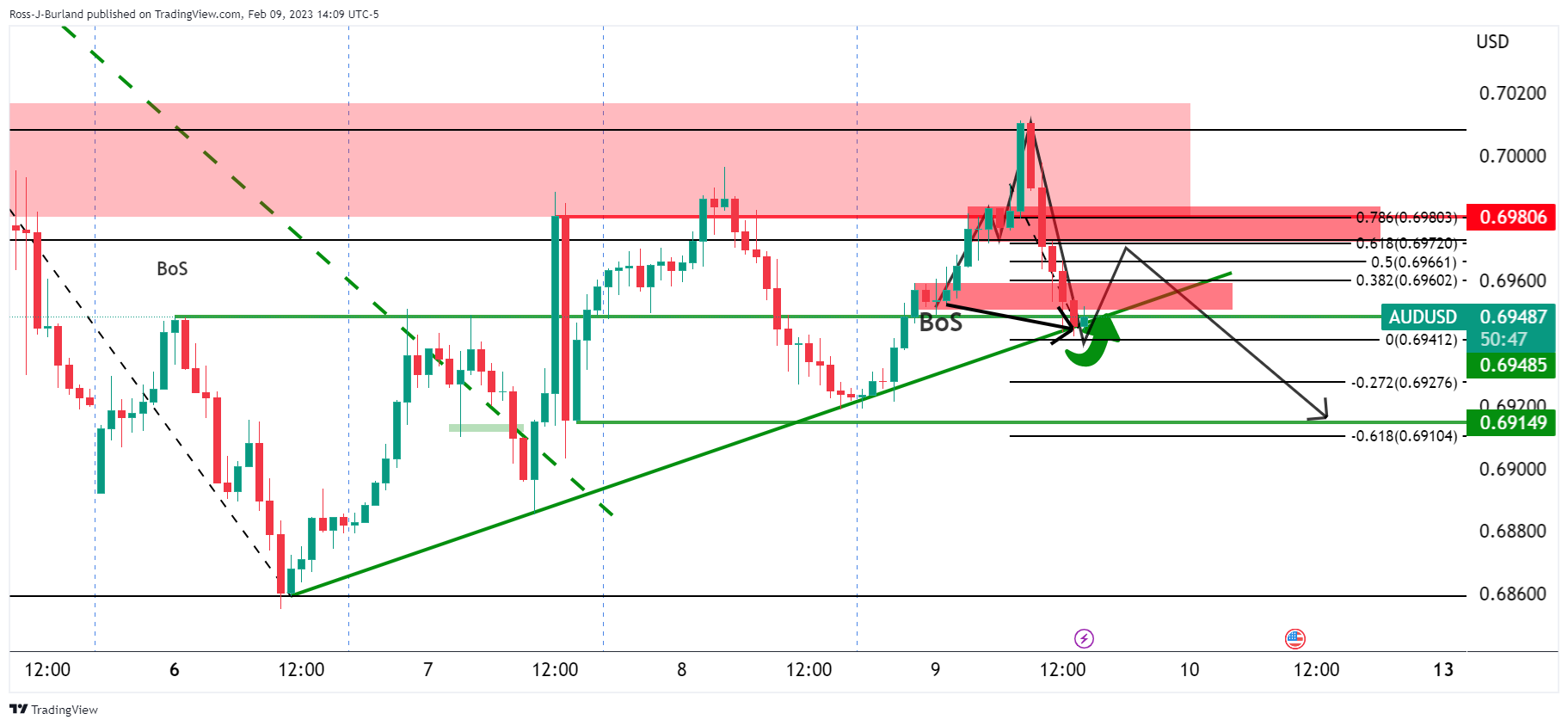
This is a reversion pattern and there are prospects of a move to the 0.6970s in a 61.8% Fibonacci retracement. The downside target is near 0.6920/10 which guards 0.69 the figure.
Mexico's central bank raises benchmark interest rate to 11.00 pct from 10.50 pct.
The Mexican central bank says board considers given monetary policy stance already attained and depending on the evolution of incoming data, for its next policy meeting, the upward adjustment to the reference rate could be of lower magnitude.
USD/MXN is falling like a stone from the 18.94s to a low of 18.7574 so far:
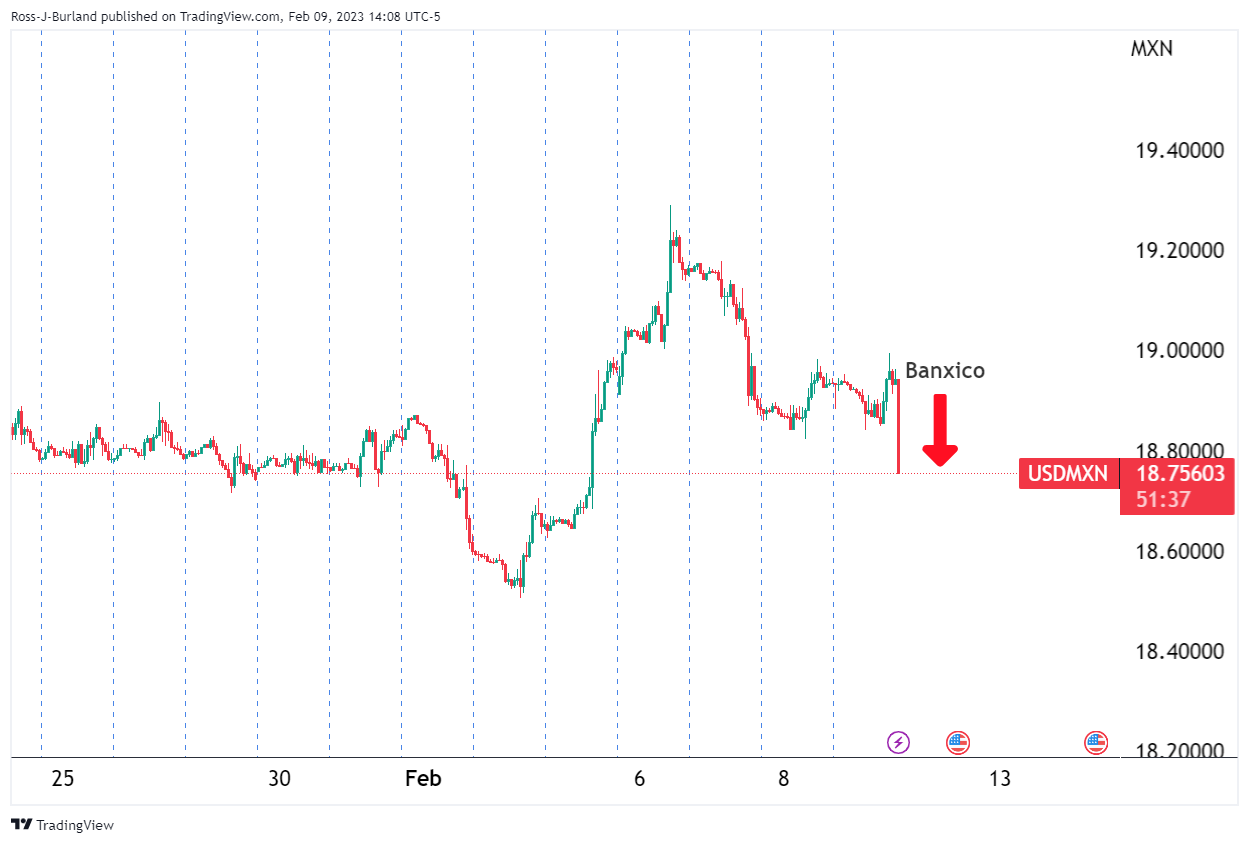
- USD/CAD is trading sideways, though in the short term, it is tilted upwards.
- Near-term, the USD/CAD is upward biased as an ascending triangle emerges.
USD/CAD grinds higher during the North American session, erasing its earlier losses that witnessed the pair dropping to its low of the day at 1.3372. However, a late bounce in the New York session spurred an upward reaction, with the USD/CAD pair almost unchanged. At the time of writing, the USD/CAD exchanges hands at 1.3448.
From a daily chart perspective, the USD/CAD remains neutral to upward biased, though the intersection of several support/resistance trendlines and the presence of the 50/100/20-day Exponential Moving Averages (EMAs) around 1.3402-1.3441 keep the USD/CAD trendless.
Nevertheless, although flat, the Relative Strength Index (RSI) is in bullish territory, keeping buyers hopeful for higher prices. On the other hand, the Rate of Change (RoC) suggests the USD/CAD might consolidate further, as it sits almost flat.
Upwards, the USD/CAD needs to clear the weekly high at 1.3475, which, once cleared, will exacerbate a leg-up toward 1.3500. on the flip side, the USD/CAD needs to break 1.3359, the weekly low, to challenge the psychological 1.3300 figure.
Short term, the USD/CAD one-hour chart suggests the pair as neutral-upwards. An ascendant triangle has formed, which, once cleared, the USD/CAD might rally towards its measured target objective at 1.3560/70.
USD/CAD One-hour chart
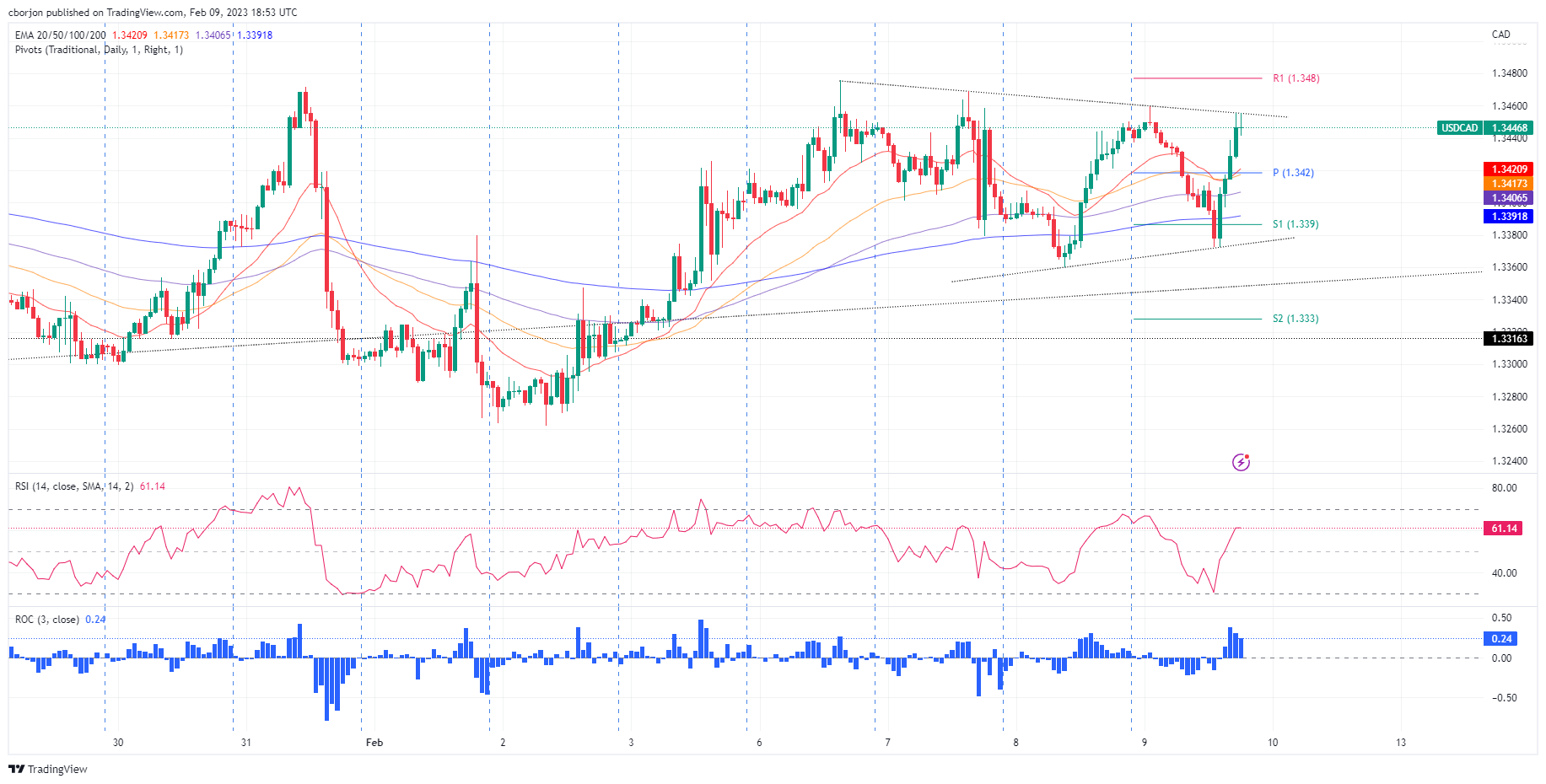
USD/CAD technical levels
- GBP/USD has sold off from a 50% mean reversion of the prior bearish daily impulse.
- We are seeing the following through with 1.20 eyed but the price is meeting some support at this juncture.
- This opens the risk of a correction before the next move to the downside.
GBP/USD rallied in a parabolic fashion on Thursday on the third day of demand for the British Pound. The pair travelled from a low of 1.2056 to a high of 1.2194 before reversing back to test the midpoint of the 1.21 area and recently reaching a sell-off low of 1.2130.
The US Dollar broke structure on the downside in the late Londo session and extended the move into the New York open only to reverse for the session. Risk-off kicked in and sent the USbouyreces packing and cable off a cliff as the following illustrates:
DXY H1 chart
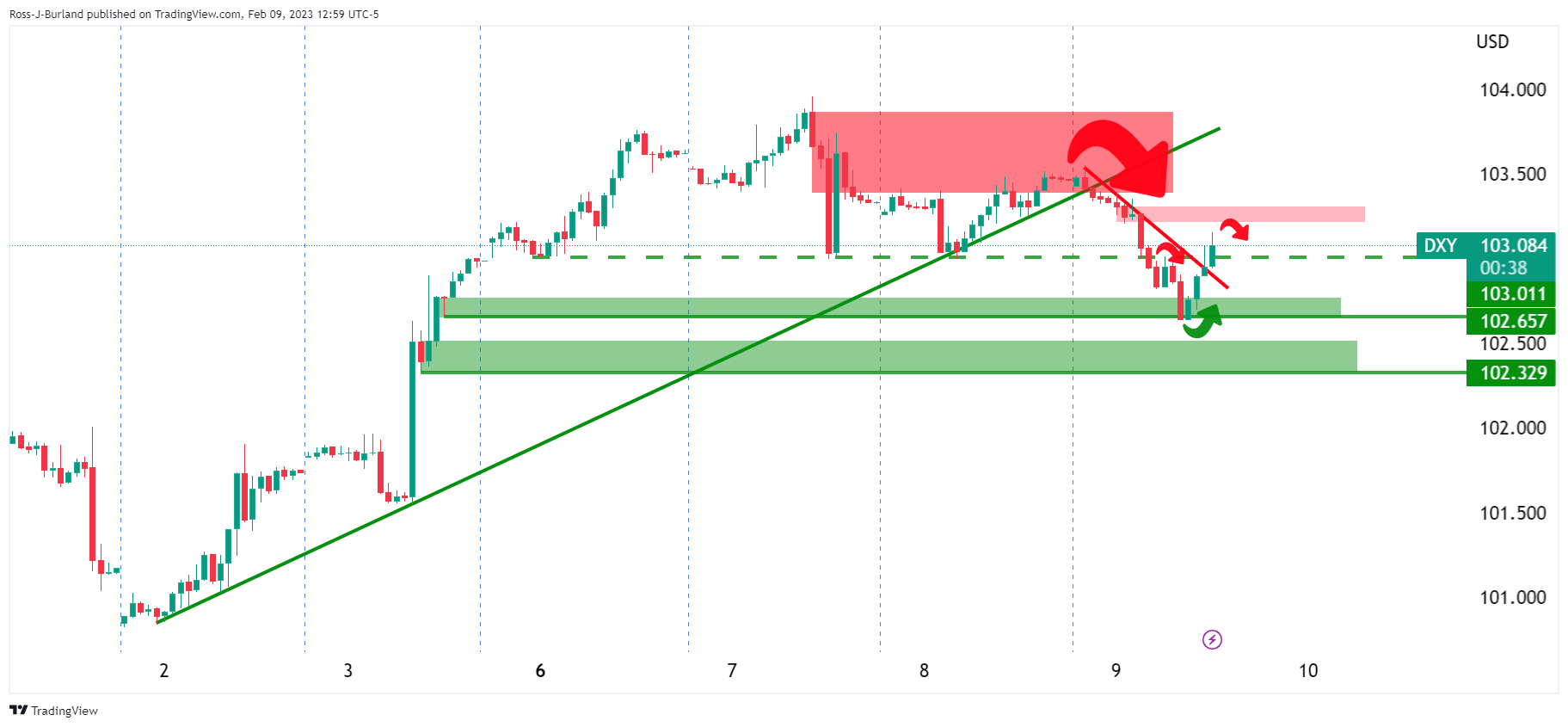
US500 H1 chart
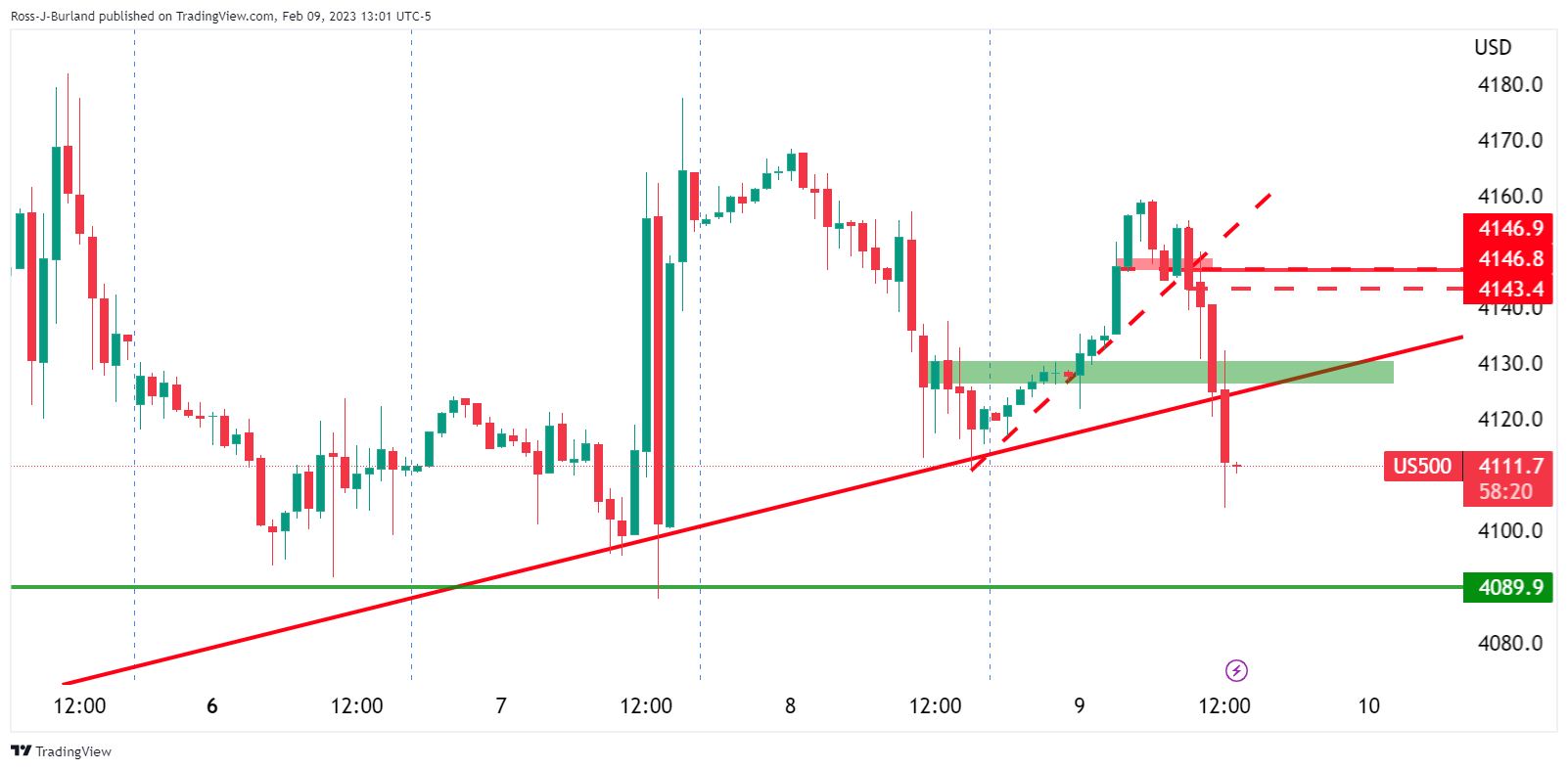
GBP/USD technical analysis
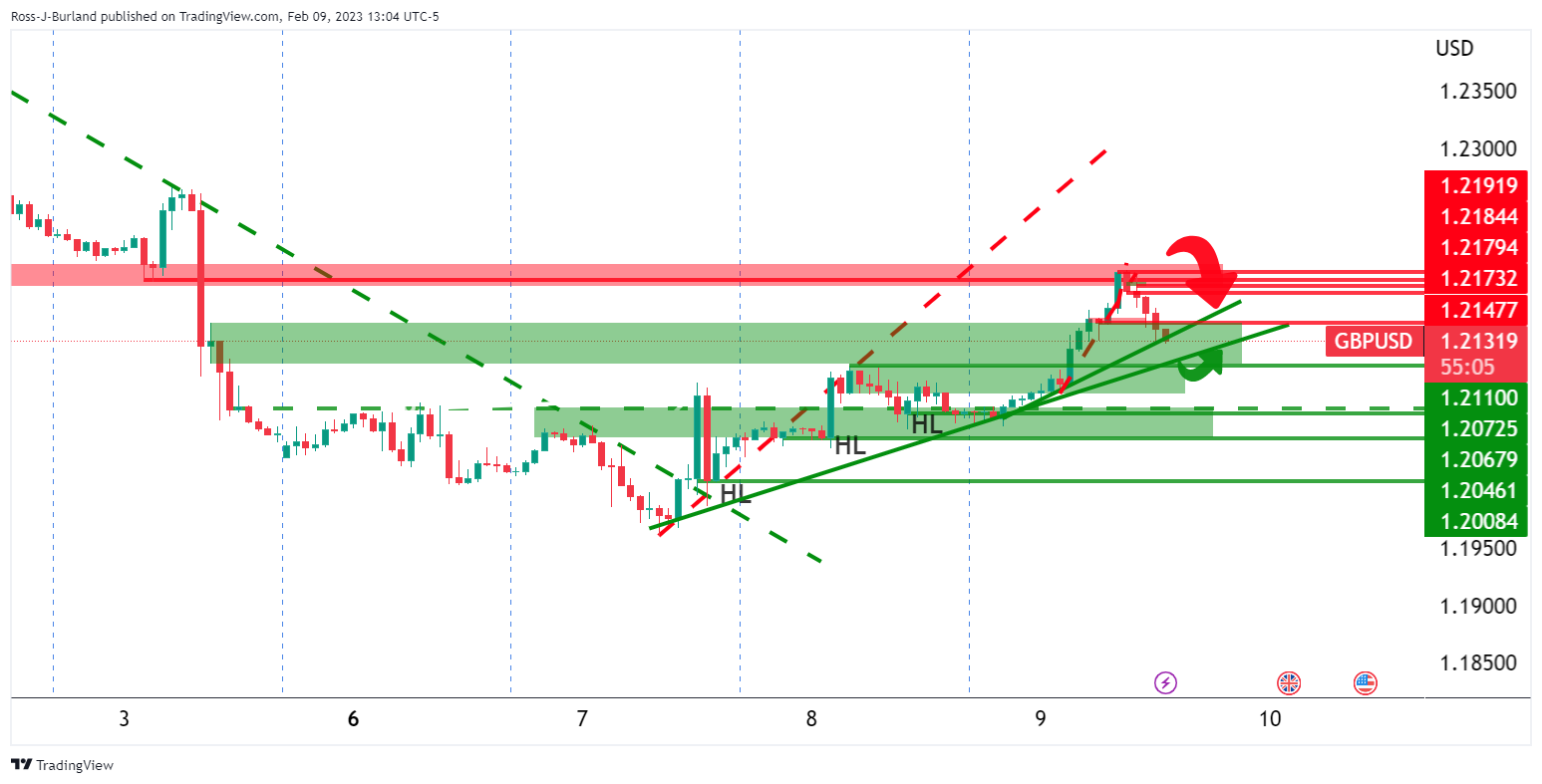
GBP/USD has dropped into the parabolic rally and the length that has been building up into a climax love the course of the week starting Tuesday. We had three levels of rise since the day opened in Asia in a massive pump-up that has concluded in a dump in the New York session in the cash opening hour on Wall Street, 1730 GMT and at the London fix of 1600 GMT. We are seeing the following through with 1.20 eyed but the price is meeting some support at this juncture:
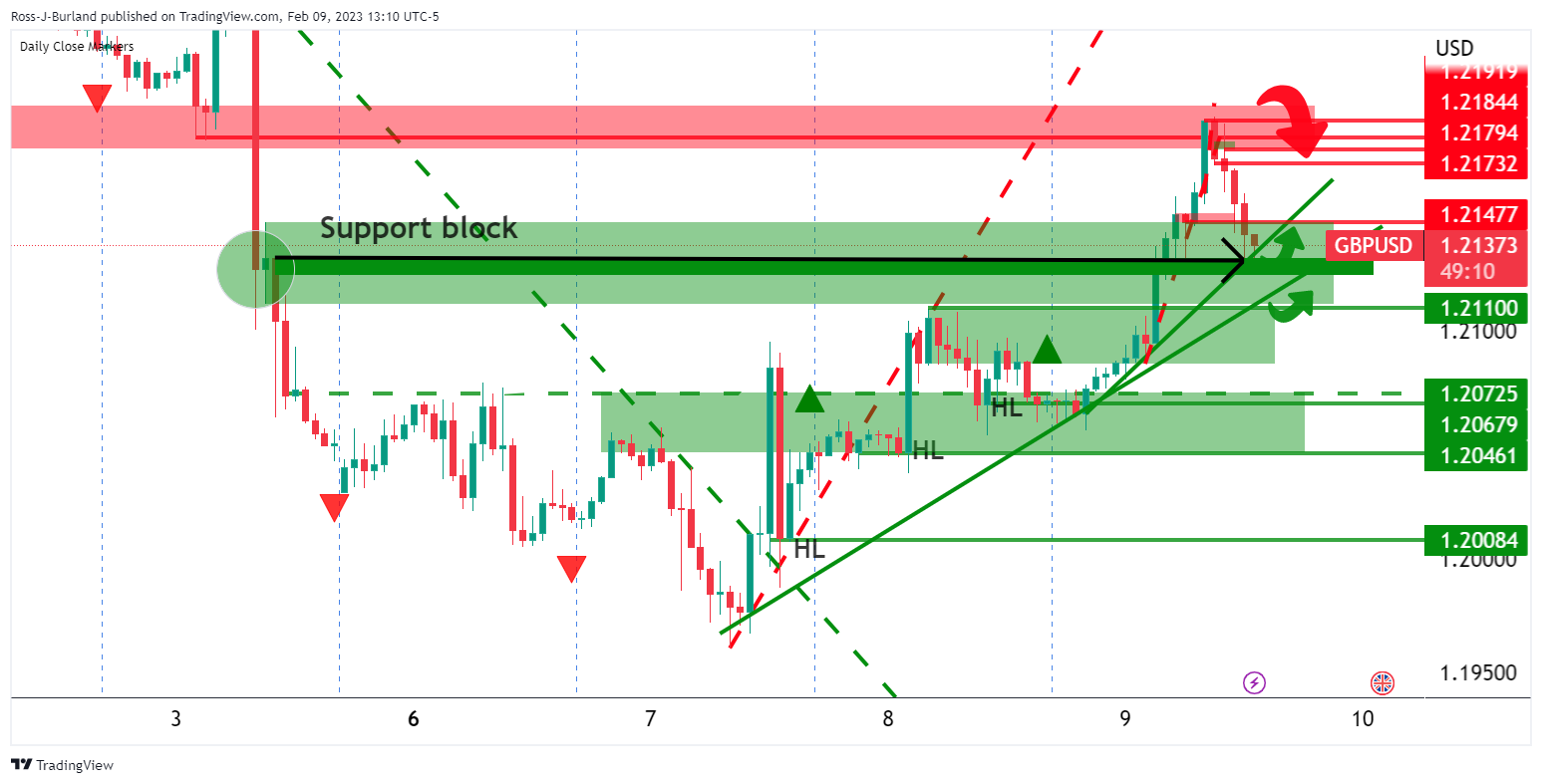
This opens the risk of a correction before the next move to the downside with the ATR of 117 pips for the day already done within the 137 pip range so far:

A bullish close on the day will be giving us three bullish closes in a row and leaves the risk of another sell-off on Friday:
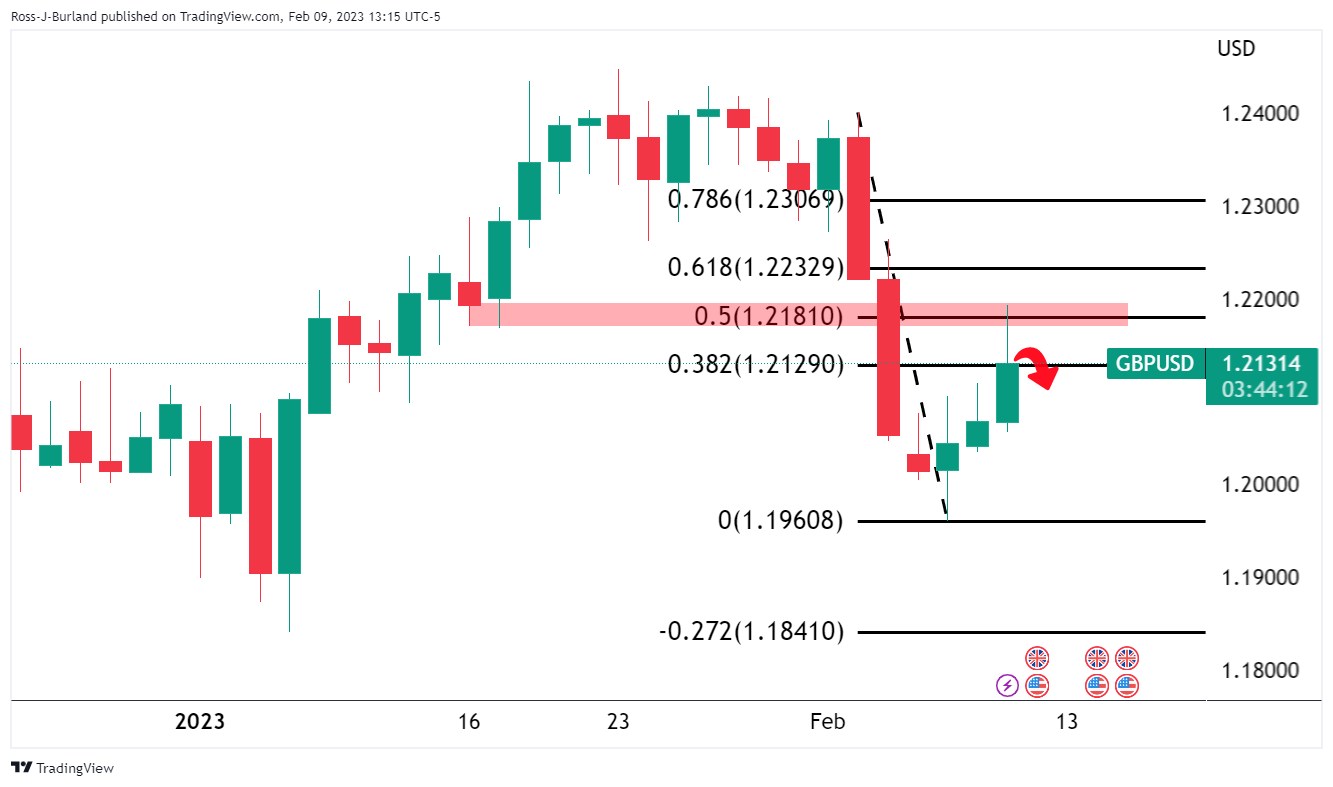
The price has already corrected to a 50% mean reversion of the prior bearish daily impulse.
- Gold price dives and eyes a break to new weekly lows below $1860.44.
- Downbeat economic data in the United States spurred Gold’s jump to its daily high at $1890.21.
- Gold Price Forecast: Short term, is downward biased, and it might test $1850.00.
Gold prices remained downward pressured on Thursday, even though the US Dollar (USD) is printing losses of 0.48%. Meanwhile, US Treasury bond yields extended their losses from around weekly highs at 3.692% to 3.592%, a tailwind for Gold prices. Despite all that, the XAU/USD is trading below its opening price, exchanging hands at 1867.54, a troy ounce.
US Initial Jobless Claims underpinned XAU/USD, though retreated those gains
US equities continue to rise throughout the North American session. XAU/USD has failed to gain traction after hitting a daily high of $1890.21, shy of the 20-day Exponential Moving Average (EMA) at $1893.07.
Economic data from the United States (US) showed that unemployment claims rose above estimates, indicating a slight shift in the US labor market. Initial Jobless Claims for the week ending February 4 increased by 195K, above forecasts of 190K, as reported by the Department of Labor (DoL). Albeit high-tech companies had announced a series of layoffs, the US economy added more than 500K in January, as revealed by the last US Nonfarm Payrolls report.
Federal Reserve officials’ hawkish commentary, a headwind for Gold
Elsewhere, a slew of Federal Reserve officials added that more rate hikes are needed as the US central bank battles to curb high inflation in the United States. The New York Fed President John Williams said, “seems a very reasonable view of what we’ll need to do this year to get the supply and demand imbalances down.”
Echoing some of his comments was Lisa D. Cook. She said that moving in smaller rate increases “is appropriate” as the central bank asses the effects of cumulative tightening. Later, Minnesota’s Fed President Neil Kashkari added that he believes the Federal Funds Rate (FFR) would need to go as high as 5.4%, according to his projections.
In the meantime, the US Dollar Index, a gauge of the buck’s value against a basket of six currencies, edges down by 0.31%, at 103.147, failed to bolster Gold prices. The US 10-year Treasury bond yield stages a recovery after dipping to its daily low of 3.575% and climbing to 3.609%.
Gold Technical Analysis
XAU/USD remains downward pressured, eyeing to extend its losses below Monday’s low of $1860.44, which is also the weekly low. An extension below would set Gold’s to test the 50-day Exponential Moving Average (EMA) around $1856.55. Once broken, XAU/USD’s bearish continuation would extend to the December 27 daily high-turned-support at $1833.29, followed by the 100-day EMA at $1816.20.
As an alternate scenario, XAU/USD’s resistance lies at the 20-day EMA at 1892.41, ahead of the psychological $1900 mark.
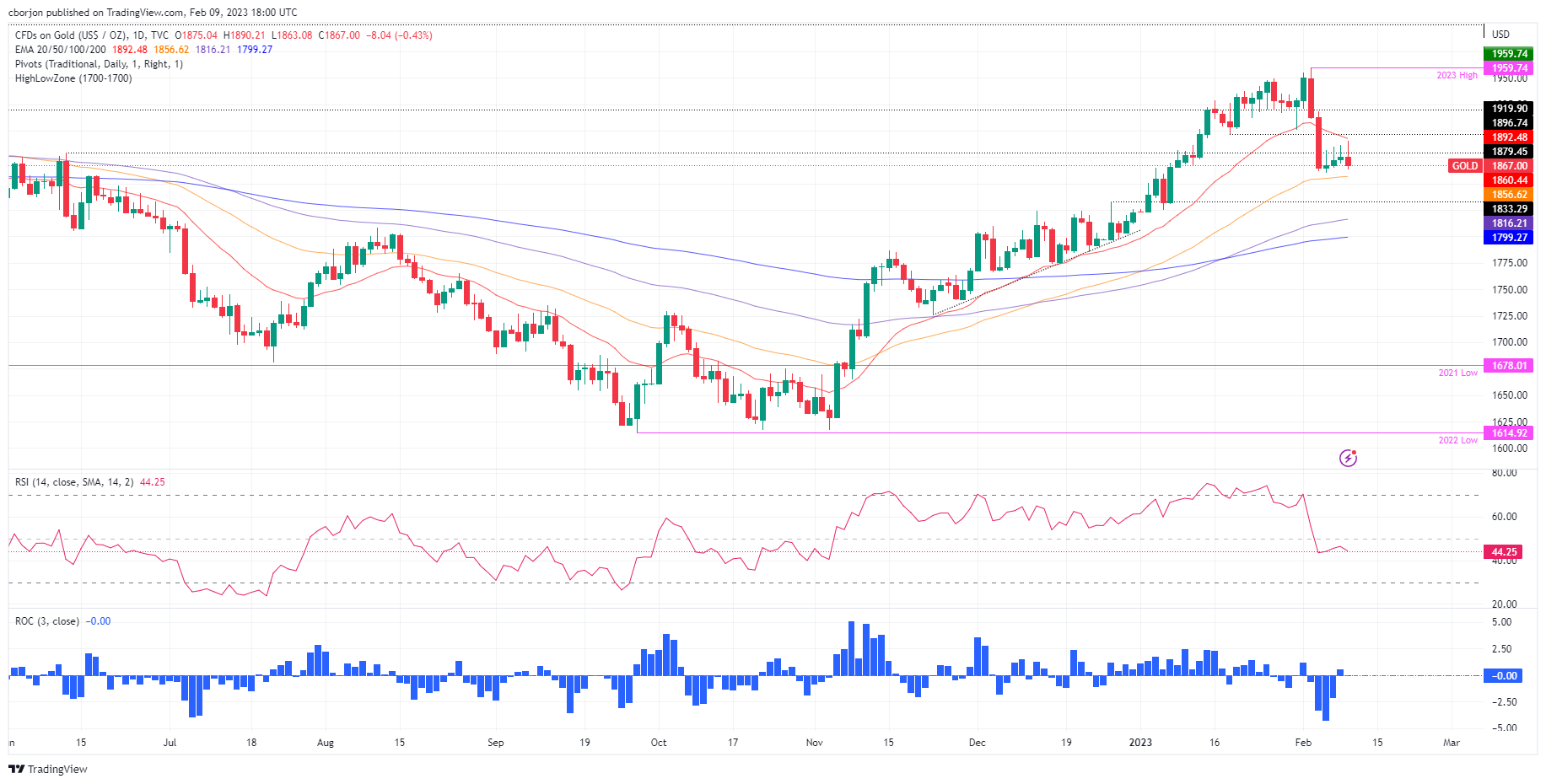
- The USD/JPY 1-hour chart portrays the formation of a bullish continuation chart pattern, keeping bulls hopeful of higher prices.
- USD/JPY Price Analysis: Long-term is still downward biased unless it breaks resistance around 133.00.
The USD/JPY erases Wednesday’s gains and aims toward the lows of the 130.30-132.90 range during the North American session, eyeing a break below the 20-day Exponential Moving Average (EMA) at 130.66. At the time of writing, the USD/JPY exchanges hands at 131.11, below its opening price by 0.18%.
From a daily chart perspective, the USD/JPY remains downward biased, though it has been tracking the 20-day EMA during the last three days, unable to breach the 130.00 mark. Oscillators like the Relative Strength Index (RSI) and the Rate of Change (RoC) suggest a bearish continuation. But the Bank of Japan’s (BoJ) dovish stance kept market participants from committing to short positions.
In the near term, the USD/JPY one-hour chart portrays the formation of a falling wedge, suggesting a bullish continuation, which could lift prices towards 131.60 and the January 11 high at 132.87. Albeit the Relative Strength Index (RSI) aims upward, it remains in bearish territory, with its slope shifting flat, but the Rate of Change (RoC) depicts buyers gathering momentum. Hence, mixed signals suggest caution is warranted.
USD/JPY buyers need to reclaim 131.82, Thursday’s high. Once done, that would pave the way towards 132.00, 132.87, and the psychological 133.00 barrier. As an alternate scenario, the bearish continuation would resume if the falling wedge breaks downwards. Therefore, the USD/JPY first support would be 130.34, February 9 low. The break below will expose the S2 and S3 daily pivot points, each at 130.21 and 129.83.
USD/JPY One-hour chart
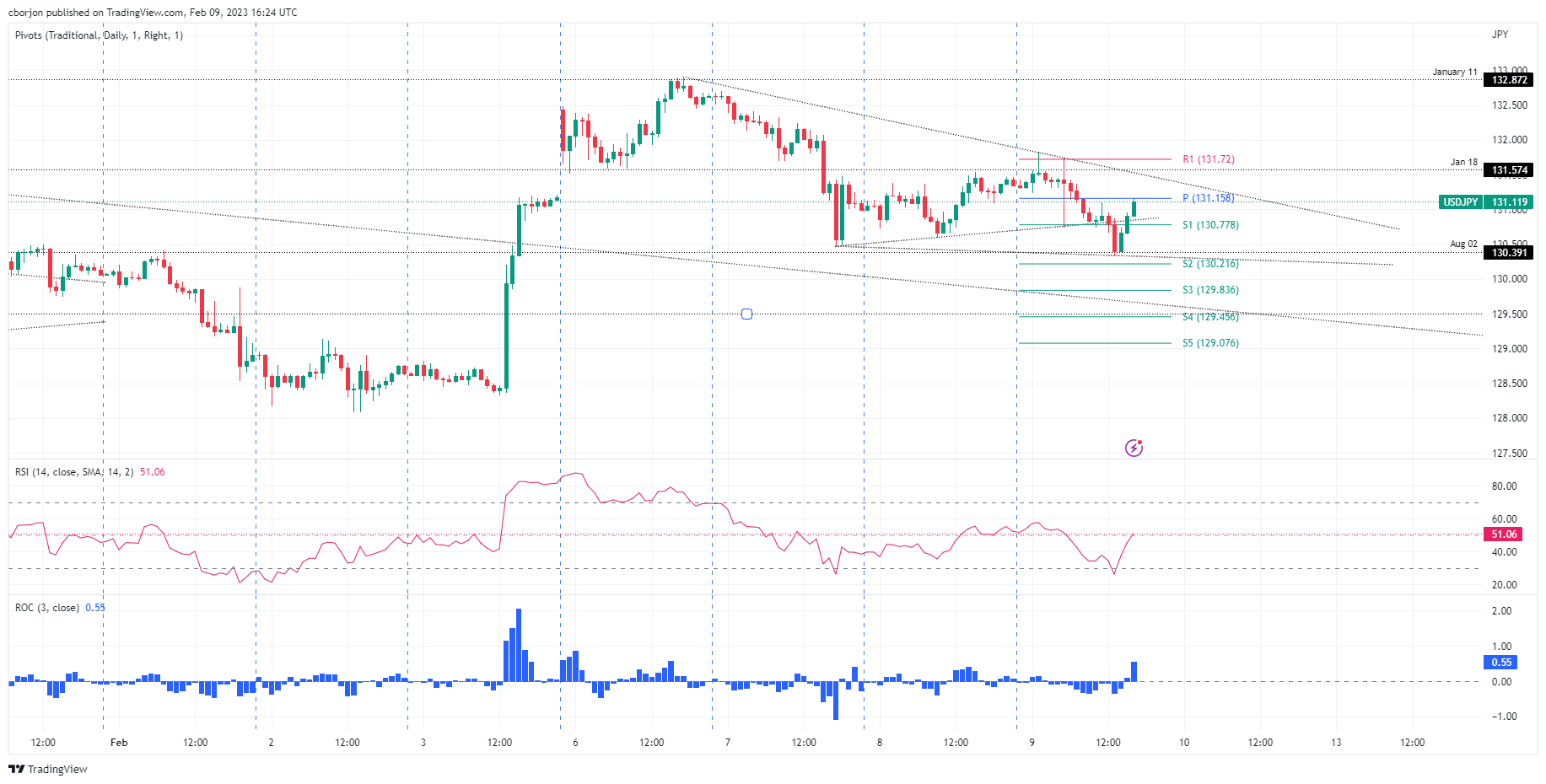
USD/JPY key technical levels
Gold is seeing a minor setback but remains above the 55-Day Moving Average (DMA) at $1,844, which should act as the bottom of a short-term range for now, according to strategists at Credit Suisse
Crucial support aligns at $1,776
“Gold has stalled in the short-term, in line with our view from last week that the market could see a lengthier pause below this level. However, the market has managed to remain above the 55-DMA, currently seen at $1,844, which should act as the bottom of a short-term range for now.”
“From a more medium-term perspective, only above the $2,070/72 record highs of 2020 and 2022 would suggest we are seeing a significant and meaningful long-term break higher, with resistance levels then seen at $2,300, then $2,500. This is not our base case for now though.”
“Support is seen at $1,844 initially, where the 55-DMA is hovering, before the crucial 200-DMA, currently seen at $1,776.”
UK growth is set to stagnate but recession narrowly averted. Regarding the EUR/GBP, Kit Juckes, Chief Global FX Strategist at Société Générale, expects the pair to correct lower toward 0.8750.
Series of EUR/GBP higher highs being followed by largish corrections continues
“Tomorrow we’ll get UK Q4 GDP data, with a consensus at zero which dodges recession but doesn’t feel great. That sums up the UK.”
“Sterling has had a lift and the series of EUR/GBP higher highs being followed by largish corrections, continues. Maybe we correct to 0.88 or even 0.8750 before the uptrend resumes.”
The Swiss National Bank is no doubt one of the central banks that surprised rather on the hawkish side over the past year. Esther Reichelt, FX Analyst at Commerzbank, expects the SNB to remain committed in its fight against inflation, capping EUR/CHF upside.
The Swiss Franc is standing up well.
“Despite a generally cautious rise in inflation to ‘only’ 3.5% the SNB hiked interest rates decisively and signalled further rates hikes. A further rate hike in March seems certain. The Franc was able to benefit from this determination over the past days.”
“In view of the upside risks for US interest rates the market seems to be speculating on the SNB not wanting to fall behind a monetary policy remaining tighter for longer on a global basis.”
“SNB is likely to remain alarmed for now, which makes the upper end in EUR/CHF less attractive due to the risk of FX market interventions.”
EUR/USD is rebounding from key support at 1.0681/76, which reinforces the case for a range to develop over the next few weeks, with key resistance at 1.1000/35, analysts at Credit Suisse report.
Break below 1.0681/69 would open up another leg lower
“EUR/USD has held key support at 1.0681/69. This reinforces our base case scenario of a lengthy period of ranging, with this level expected to define the bottom end of a new range.”
“The potential for a rangebound phase is also reinforced by the recent false breakout above key resistance at the 50% retracement of the 2021/2022 fall at 1.0944, with the sharp fall likely cleansing positioning significantly.”
“1.1000/35 is now expected to act as the top of the range. In contrast, a break below 1.0681/69 would open up another leg lower, with a lack of meaningful support until 1.0483/0463, where we would again look for a floor if reached.”
- USD/MXN seesaws at around 18.8900 ahead of Banxico’s decision.
- US Initial Jobless Claims exceeded estimates, signaling that the US labor market could begin to deteriorate.
- USD/MXN Price Analysis: Range-bound, but it could test the 19.0000 figure.
The Mexican Peso (MXM) continues to strengthen against the US Dollar (USD) in the North American session due to a softer greenback, and traders are awaiting Banxico’s monetary policy decision, with the Mexican central bank estimated to raise rates by 25 bps. Therefore, the USD/MXN meanders at around 18.8660s, below its opening price, after hitting a daily high of 18.9537.
Banxico's 25 bps rate hike, could undermine the Mexican peso
Wall Street is set to open in the green, while the United States (US) labor market appears to ease on a Bureau of Labor Statistics (BLS) report. Initial Jobless Claims for the week ending on February 4 rose by 196,000, more than the 190,000 expected by market analysts. Even though it’s a small step toward easier labor market conditions, last Friday’s astonishing US Nonfarm Payrolls report might deter the US Federal Reserve (Fed) from pausing. Instead, they would need to keep hiking rates.
Aside from this, the Mexican economic calendar revealed that inflation rose by 7.91% YoY in January, according to the national statistics agency, higher than 7.89% expectations. Meanwhile, core inflation, which excludes volatile items, increased by 0.71% MoM, above estimates of 0.69%, keeping Banxico’s, the Mexican central bank, pressured as they prepare to deliver its monetary policy decision at around 19:00 GMT.
Delving into Banxico’s decision, most analysts estimate a 25 bps hike, lifting rates at around 10.75%, aligned with the US Federal Reserve’s (Fed) policy. Nevertheless, money market futures had priced in 50 bps of increases for 2023.
Analysts at TD Securities commented that this could be the last increase by Banxico though recent inflation data, which could suggest further aggression is warranted. They added, “we expect that Banxico will test its credibility by calling for a halt in its hiking cycle. We think the decision will be backed by the expected effects of tight monetary conditions, which may be about to appear on prices, and its conviction that such conditions will be consistent with inflation traveling back towards target in the following quarters. In spite of the latter, we expect Banxico to maintain a margin for maneuvering and avoid signaling a sharp and definitive end to the tightening effort.”
USD/MXN technical analysis
From a daily chart perspective, the USD/MXN remains downward biased, exchanging hands below long-term daily Moving Averages (MAs). Nevertheless, the break above a falling wedge suggests that buyers are gathering momentum. Also, the top-trend line of the former is capping the USD/MXN fall to test the YTD lows of around $18.50.
Upwards, the USD/MXN’s next resistance would be the psychological 19.000 figure. The break above will expose the 50-day Exponential Moving Average (EMA) at 19.1208, followed by the February 6 daily and weekly high of 19.2905, ahead of the YTD high at 19.5345.
As an alternate scenario, a fall toward the YTD low of 18.5071 is likely to happen, followed by August 7, 2018, low at 18.4047, and April 17, 2018, low at 17.9388.
By and large, this week in FX markets is an exercise in unwinding some of the post-NFP Dollar strength. What happens to the Dollar if US rates peak at 6%? Kit Juckes, Chief Global FX Strategist at Société Générale, thinks that would support the greenback.
A change of conversation
“The discussions I’ve been having with clients definitely turned towards the possibility and implications of the Fed going well beyond the 5-5.25% peak everyone has been forecasting.”
“What would 6% do? Glancing at the Bloomberg economists’ survey there are quite a few banks that think we’ll be at 5.25% well into 2024, but no one has yet put down a 5.5% peak, let alone something higher. The obvious answer is that a 5.5% peak, instead of 5.25%, means little, but 6% increases the risk of the cycle ending messily. And that would support the Dollar and be bad for risk-sensitive currencies everywhere.”
The corrective pullback in GBP/USD appears to have run its course. If the UK GDP confirms the British economy can avoid recession, the Pound could remain resilient, economists at OCBC Bank report.
Eyes on data dump tomorrow
“UK data dump on Friday is in focus especially after the UK think tank, National Institute of Economic and Social Research (NIESR) predicted that UK is likely to avoid a recession this year. A stronger set of UK data print could validate the think tank's prediction and further unwinding of GBP shorts may well keep GBP supported.”
“Support here at 1.2040/50 (50% fibo) before 1.1950 (200 DMA) and 1.1820 (100 DMA).” “Resistance at 1.2190 (50 DMA), 1.2230 (21 DMA) and 1.2450 levels (double top).”
Who is going to sell Gold? Strategists at TD Securities believe that the yellow metal has limited downside potential barring a more hawkish path ahead.
The pace of Chinese selling could slow
“Our tracking of positioning for the top traders in Shanghai gold has pointed to notable liquidations over the past weeks, but this cohort's Gold length is now at sub-average levels relative to the last year. This suggests the pace of Chinese selling could slow, leaving investors as the marginal buyer or seller.”
“We don't expect any downside flow from CTAs until prices break the $1,840 range. And, we argue that notable selling activity from CTAs will likely be elusive above the $1,800 mark. In contrast, the margin of safety against a marginal buying program is razor thin above $1,900.”
“Discretionary money manager positioning also appears flat.”
“The slump in precious metals prices could be limited without data corroborating a more hawkish path ahead.”
- EUR/USD reverses part of the recent sell-off on Thursday.
- Extra gains are likely once 1.0800 is cleared.
EUR/USD finally picks up some convincing upside traction and approaches the key resistance area near 1.0800 the figure on Thursday.
If the pair surpasses the 3-month resistance line near 1.0800, it could then extend further the march north with the immediate target at the 2023 peak at 1.1032 (February 2).
In the longer run, the constructive view remains unchanged while above the 200-day SMA, today at 1.0320.
EUR/USD daily chart

Market participants are now eagerly awaiting the release of the next US Consumer Price Index (CPI) report on Tuesday, February 14, for a fresh catalyst for US Dollar direction. Economists at MUFG expect the greenback to be underpinned by a strong inflation report.
Headline and Core inflation to increase by 0.5% and 0.4% respectively in January
“US economists are looking for a stronger US CPI report for January bringing an end to the run of three softer reports at the end of last year.”
“One of the key drivers for the expected pick-up inflation in January has been the rise in used car prices at the start of this year. Bloomberg reported yesterday that average used-vehicle prices rose 2.5% in January according to data from Manheim. The current Bloomberg consensus forecast is for headline and core inflation to increase by 0.5% and 0.4% respectively in January.”
“A stronger inflation report would make it harder for the US Dollar to resume its downward trend in the near-term even if it is driven more by one-off factors.”
S&P 500 closed last week above 4101 – which suggests further short-term strength up to 4311/25, analysts at Credit Suisse report.
Cross higher into positive territory in weekly MACD momentum
“Last week’s close above the downtrend from the beginning of 2022 and break above ‘last resort’ resistance at the key December ‘reversal week’ high at 4101 is likely to trigger further short-term strength, especially as weekly MACD is now positive, as key moving averages have seen a bullish cross higher and crucially as consensus short positioning from the start of this year is unwound.”
“Next key resistances are seen at 4195/4203, then 4311/25, which should prove a tough barrier.”
“Key support is first seen at the 4101/4088 breakout point, then the key cluster of moving averages and potential uptrend from the 2022 low at 3956/30, with a break below here needed to reassert a bearish tone.”
- GBP/USD gains strong positive traction for the third straight day and refreshes weekly high.
- A sustained strength beyond the 1.2100 mark and the 38.2% Fibo, prompt technical buying.
- Mixed oscillators on hourly/daily charts warrant caution before placing fresh bullish bets.
The GBP/USD pair builds on this week's rebound from the vicinity of the very important 200-day SMA, or a one-month low around the 1.1960 area and scales higher for the third straight day on Thursday. The positive momentum remains uninterrupted through the early North American session and pushes spot prices to a fresh weekly high, around the 1.2175 region in the last hour.
A sustained move beyond the 1.2100 mark was seen as a key trigger for bullish traders amid broad-based US Dollar weakness. A subsequent break through the 38.2% Fibonacci retracement level of the recent pullback from a multi-month high touched in January might have already set the stage for additional gains. The positive outlook is reinforced by the fact that technical indicators on the 4-hourly chart have been gaining positive traction.
That said, the Relatively Strength Index (RSI) on the 1-hour chart is already flashing overbought conditions. Adding to this, oscillators on the daily chart - though have been recovering from the bearish territory - are yet to confirm the positive bias. Hence, any subsequent positive move is likely to remain capped near the 1.2190-1.2200 confluence hurdle, comprising technically significant (50-period and 200-period SMAs on the 4-hour chart) and the 50% Fibo. level.
Bulls might wait for some follow-through buying beyond the aforementioned barrier before placing fresh bets amid expectations that the Bank of England's rate-hiking cycle is nearing the end. The GBP/USD pair might then accelerate the momentum towards the 61.8% Fibo. level, around the 1.2255-1.2260 area en route to the 1.2300 round-figure mark
On the flip side, the 38.2% Fibo. level, around the 1.2145 zone, now seems to protect the immediate downside. Any further pullback might now be seen as a buying opportunity near the 1.2100 mark, which should act as a pivotal point. This is followed by 23.6% Fibo. level support near the 1.2075 area, which if broken decisively will suggest that the corrective bounce has run its course and make the GBP/USD pair vulnerable to resume its downtrend.
GBP/USD 4-hour chart
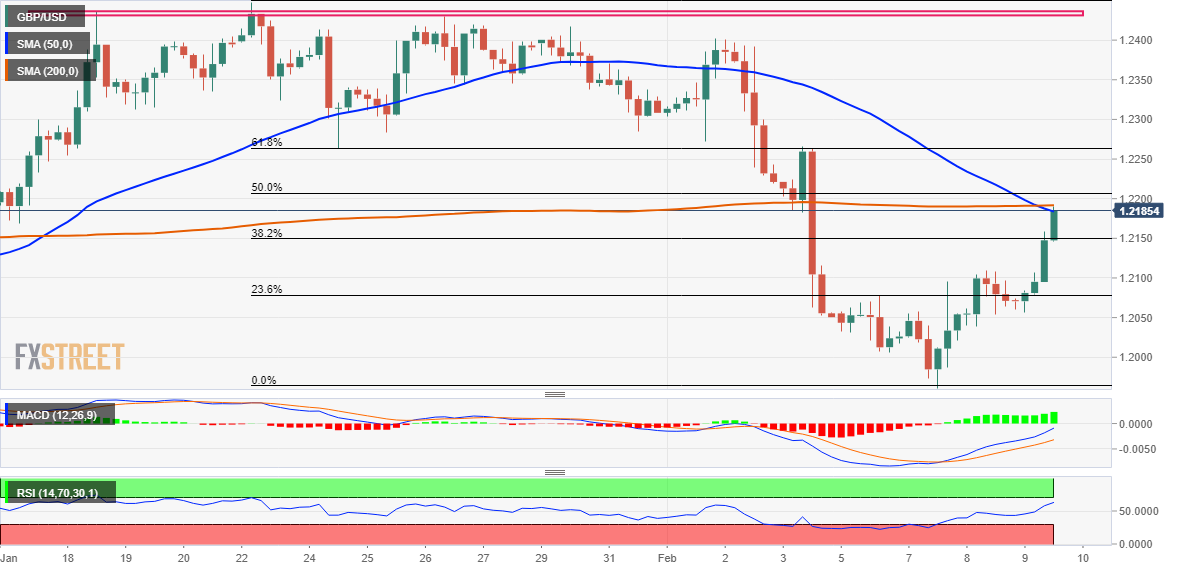
Key levels to watch
Richmond Fed President Thomas Barkin said on Thursday that the effects of the Federal Reserve's policy tightening has been substantial, as reported by Reuters. Barkin further argued that it would make sense for the Fed to steer "more deliberately" from here due to lagged effects of policy.
Additional takeaways
"Inflation is likely past its peak but still elevated, will take longer for pullback in demand to further slow the pace of price increase."
"Confident that Fed has its foot unequivocally on the brake."
"While average inflation has peaked, the decline has been distorted by a few goods, median has stayed high."
"Data continue to push back recession risks."
"Core question for 2023 is whether inflation is really calming."
Market reaction
The US Dollar continues to weaken against its rivals following these comments and the US Dollar Index was last seen losing 0.72% on the day at 102.72.
- The index loses the grip and drops to weekly lows near 102.80.
- Next on the downside emerges the 3-month line near 101.60.
DXY accelerates losses and breaks below the key support at 102.00 the figure on Thursday.
The continuation of the downtrend could put the 3-month support line near 101.60 to the test in the near term. Below this line, the dollar is expected to face extra weakness and could open the door to a potential move to the 2023 low around 100.80 (February 2).
In the longer run, while below the 200-day SMA at 106.45, the outlook for the index remains negative.
DXY daily chart
- Initial Jobless Claims in the US increased by 13,000 in the week ending February 4.
- US Dollar Index stays deep in negative territory below 103.00.
There were 196,000 initial jobless claims in the week ending February 4, the weekly data published by the US Department of Labor (DOL) showed on Thursday. This print followed the previous week's print of 183,000 and came in slightly worse than the market expectation of 190,000.
Further details of the publication revealed that the advance seasonally adjusted insured unemployment rate was 1.2% and the 4-week moving average was 189,250, a decrease of 2,500 from the previous week's unrevised average.
"The advance number for seasonally adjusted insured unemployment during the week ending January 28 was 1,688,000, an increase of 38,000 from the previous week's revised level," the DOL noted.
Market reaction
US Dollar struggles to find demand after this data and the US Dollar Index was last seen losing 0.65% on the day at 102.80.
- Gold price edges higher for the fourth successive day amid heavy US Dollar selling.
- The prospects for further policy tightening by Federal Reserve act as a headwind.
- The risk-on impulse further contributes to cap gains for the safe-haven XAU/USD.
Gold price trades with a positive bias for the fourth successive day and is currently placed around the $1,880 level, just below the weekly high touched earlier this Thursday. The intraday uptick, however, lacks bullish conviction, warranting some caution before positioning for an extension of the recent bounce from the $1,860 area, or a one-month low touched on Monday.
Renewed US Dollar selling benefits Gold price
The US Dollar retreats sharply from a one-month high amid the uncertainty over the Federal Reserve's (Fed) rate-hike path. This, in turn, is seen as a key factor driving flows towards the US Dollar-denominated Gold price. In fact, Fed Chair Jerome Powell struck a balanced tone on inflation and reiterated on Tuesday that the process of disinflation was underway. The comments fueled speculations that interest rates may not rise much further, which triggers a fresh leg down in the US Treasury bond yields and weighs heavily on the Greenback.
Hawkish comments by Federal Reserve officials act as a headwind
Powell, however, acknowledged that rates might still need to move higher than expected if the economy remained strong. Furthermore, a slew of FOMC members echoed Powell's view that additional rate hikes were likely warranted to fully gain control of inflation. Fed Governor Christopher Waller noted that it could require higher rates for longer than some are currently expecting to get inflation down to the target. Separately, New York Fed president John Williams said that the Fed funds rate to a range of 5% to 5.25% still seems very reasonable.
Risk-on impulse contributes to capping safe-haven Gold price
Furthermore, Minneapolis Fed President Neel Kashkari said that explosive job growth is evidence that the central bank has more work to do to tame inflation. The hawkish remarks support prospects for a further policy-tightening by the US central bank and act as a headwind for the non-yielding Gold price. Apart from this, a recovery in the global risk sentiment contributes to capping the safe-haven XAU/USD. Hence, it will be prudent to wait for some follow-through buying before confirming that the recent pullback from a multi-month top has run its course.
Gold price technical outlook
From a technical perspective, any subsequent move up is likely to confront near the $1,900 round-figure mark. A sustained strength beyond the said handle could trigger a short-covering rally and lift the Gold price to the $1,920 horizontal barrier. The momentum could get extended towards the $1,950 region en route to the multi-month peak, around the $1,960 area touched last week.
On the flip side, the one-month low, around the $1,860 region, now seems to act as immediate strong support. Some follow-through selling has the potential to drag Gold price towards the $1,825 horizontal support, below which bears could aim to test the $1,800 mark. This is followed by the $1,775-$1,770 confluence, comprising technically significant 100-day and 200-day Simple Moving Averages. A convincing break below will be seen as a fresh trigger for bearish traders and pave the way for deeper losses.
Key levels to watch
- EUR/JPY adds to Wednesday’s uptick and regains 141.00 and above.
- A sustainable move above the 200-day SMA should expose extra gains.
EUR/JPY advances for the second session in a row on Thursday, although the initial bull run to the 141.30 region fizzled out rapidly.
While the cross is expected to maintain the side-lined theme in the short term, the 143.00 area remains a solid barrier for bulls. This key resistance zone also appears reinforced by the 100-day SMA, today at 142.90
If the cross breaks above the 200-day SMA at 141.02 on a sustainable fashion, the outlook is expected to shift to a more constructive one.
EUR/JPY daily chart
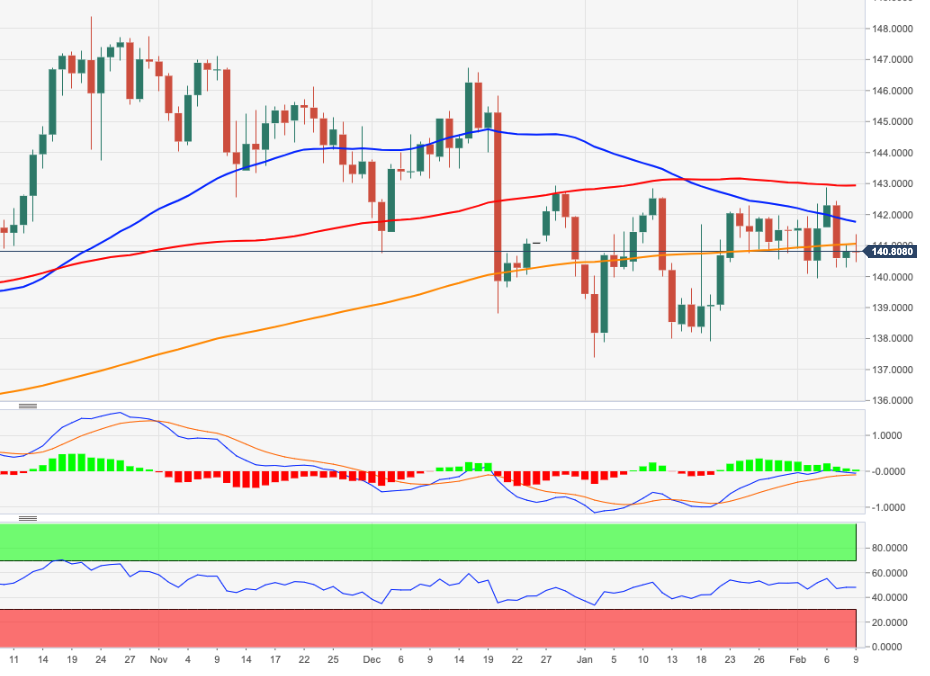
USD/CAD again rejected gains beyond the 1.3450 area for the third time this week. Economists at Scotiabank believe that there is limited scope for declines, though.
Underlying trend oscillators remain bullishly aligned for USD
“Spot’s turn lower suggests a minor peak may have formed, putting the USD on course for a push lower. But USD losses so far are not especially powerful and the underlying trend oscillators remain bullishly aligned for the USD, suggesting limited scope for declines at the moment.”
“Look for firm support on dips to the low/mid 1.33s.”
UOB Group’s Senior Economist Julia Goh and Economist Loke Siew Ting review the latest inflation figures in the Philippines.
Key Takeaways
“The Philippines’ headline inflation accelerated further to 8.7% y/y in Jan (from +8.1% in Dec), defying our expectation and Bloomberg consensus of a slowdown to 7.7% and 7.6% respectively. It marked the highest annual inflation rate since Nov 2008, and posted the strongest m/m gain since Jan 2000 at 1.7% (Dec: +0.3%) after a broad-based sharp increase across all food and non-food subsegments.”
“The unexpected surge in headline inflation and record-high core inflation for Jan have materially lifted the statistical base of our overall inflation projection for this year. A brighter global growth prospect painted by the IMF and an anticipated boost to the Philippines’ tourism sector from China’s reopening could also help to hold up domestic demand at a more sustainable pace than we have previously expected, amid firmer global energy prices at around USD80/bbl. Hence, we raise our full-year inflation forecast for the Philippines to 6.0% (from 4.5% previously, BSP est: 4.5%), and expect it to return to the central bank’s 2.0%-4.0% forecast range only in late 4Q23 (vs. previous forecast of late 3Q23).”
“Both stronger-than-expected Jan inflation and 4Q22 GDP readings have strengthened the case for a more restrictive monetary policy setting when the Monetary Board (MB) meets next Thu (16 Feb). Our revised inflation outlook for 2023 is also suggesting that the MB will have to do more to get inflation back to target in a sustainable manner. This alongside rising concerns of a higher-than-expected terminal Fed Funds Target Rate (FFTR) pose upside risks to our BSP outlook, which we have called for two more 25bps hikes in 1Q23 (Feb and Mar) before taking a pause at 6.00% thereafter.”
Banxico is forecast to raise rates today while the Peso is the second-best performer in LatAm after the CLP. MXN is set to enjoy further gains unless the central bank delivers a dovish surprise, economists at Société Générale report.
Immediate support for USD/MXN runs at 18.50
“Barring a dovish shift by Banxico, a de-rating of risk assets and underwhelming incoming data from China, the Mexican Peso may have more room to run.”
“Last May's low near 19.40 must be overcome to affirm an extension in rebound.”
“In case the pair violates the support zone at 18.50/18.30, there could be a risk of deeper downtrend towards 17.95 and projections of 17.60.”
- AUD/USD catches fresh bids on Thursday and rallies back closer to the weekly high.
- The uncertainty over the Fed’s rate-hike path weighs on the USD and offers support.
- The risk-on mood further undermines the buck and benefits the risk-sensitive Aussie.
The AUD/USD pair regains positive traction on Thursday and maintains its strong bid tone through the mid-European session. The pair is currently trading around the 0.6975-0.6980 region, just a few pips below the weekly high touched on Wednesday.
A combination of factors triggers a sharp US Dollar corrective pullback from a one-month high, which, in turn, is seen acting as a tailwind for the AUD/USD pair. The uncertainty over the Fed's rate-hike path drags the US Treasury bond yields lower. This, along with the risk-on impulse, weighs on the safe-haven buck and benefits the risk-sensitive Aussie.
Investors turned optimistic amid signs of easing inflationary pressures and hopes that the People's Bank of China (PBoC) may cut interest rates further during the second quarter. The Australian Dollar is also underpinned by the Reserve Bank of Australia's hawkish outlook, signalling further rate increases will be needed to ensure that inflation returns to target.
That said, the prospects for further policy tightening by the Fed support prospects for the emergence of some USD dip-buying, which, in turn, could cap the upside for the AUD/USD pair. In fact, a slew of FOMC members on Wednesday echoed Fed Chair Jerome Powell's view that additional rate hikes were likely warranted to fully gain control of inflation.
Furthermore, growing worries about a deeper global economic downturn might keep a lid on any optimism in the markets. This, in turn, could lend some support to the greenback and contribute to keeping a lid on the AUD/USD AUD/USD pair, at least for the time being. Traders now look forward to the release of the Weekly Initial Jobless Claims data from the US.
This, along with the US bond yields, will influence the USD price dynamics and provide some impetus to the AUD/USD pair. Apart from this, the broader risk sentiment might further contribute to producing short-term opportunities ahead of the RBA meeting minutes and the latest Chinese inflation figures, scheduled for release during the Asian session on Friday.
Technical levels to watch
GBP/USD trades back to the mid-1.21 zone. A break past 1.2175/95 would clear the way towards the low/mid-1.22s, economists at Scotiabank report.
Short-term technical undertone is supportive
“A third day of gains (so far) for Cable support the impression of a clear reversal developing earlier this week around the test and rejection (via a bullish outside range reversal) of the 200-Day Moving Average.”
Intraday gains have stalled in the mid-1.21 area but the short-term technical undertone is supportive and suggests support on dips to the 1.2105/10 area intraday.”
“Spot may test 1.2175/85 shortly, with gains through here targeting the low/mid-1.22s.”
Nasdaq 100 maintains its recent decisive break above the 12166 high of December. Economists at Credit Suisse expect the index to enjoy further strength.
Initial support aligns at 12166
“The market is stalling in the short-term below 12740/856, which is the 38.2% retracement of the 2021/22 fall and price high from September 2022, however, we look for a breakout above this level in due course, with next resistance at 13175, then 13603/720.”
“Going forwards, we will be monitoring whether key trend-following indicators start to turn more sustainably higher to assess the durability of the rally.”
“Support is first seen at the recent breakout point at 12166, which we now look to hold. The next level is seen at 11960/853, below which would quickly point to a false breakout.”
GBP/USD is mainly driven by risk sentiment. Economists at HSBC expect the Pound to bounce back higher.
What will actually drive the GBP going forward?
“Risk sentiment (using S&P 500 Index as a proxy), rather than rate differentials, remains the key dominant driver for the GBP. In turn, this means the UK economic outlook is what should matter to the GBP.”
“The BoE now sees a shorter, shallower recession than in its gloomy November forecast, which was based on much higher energy prices. The UK economy is now expected to contract almost 1% over the next five quarters, rather than 2.9% over the next eight quarters.”
“Finally, we think a less hawkish BoE could turn out to be GBP-positive later in the year, because of a potentially less abrupt policy shift.”
Banxico will get January inflation data today – and is likely to continue its rate hikes. Economists at Commerzbank analyze how could these events impact the Peso.
Banxico could surprise with a big rate step
“A small rise in inflation rates is likely to fuel market expectations that Banxico will deliver a small rate step and sounds hawkish, i.e. will leave the door open for further rate hikes. If, however, Banxico delivers less this is likely to cause disappointment and put pressure on the MXN.”
“A significant upside surprise regarding the inflation data might fuel expectations of a larger Banxico rate step with some, which is likely to benefit the Peso. It cannot be excluded that Banxico surprises with a big rate step which is likely to support the MXN.”
“The combination of a moderate rise in inflation, a small step and a hawkish sounding statement in which Banxico signals further interest rate steps seems more likely to us. Since much seems to be priced in already, potential Peso gains should be limited.”
Bank of England (BoE) Chief Economist Huw Pill and policymaker Jonathan Haskel are testifying before the UK Treasury Select Committee alongside Governor Andrew Bailey.
Key takeaways from Pill's remarks
"We have to be prepared to see through policy tightening, to address potential upside risks to inflation."
"There is a danger of over-steering on rates, given lags in transmission."
"But we do need to be alert to inflation persistence, look at price- and wage-setting."
Market reaction
The GBP/USD pair continues to stretch higher during the European trading hours and it was last seen rising nearly 0.7% on the day at 1.2153.
- USD/CAD meets with a fresh supply on Thursday and is pressured by a combination of factors.
- Retreating US bond yields and the risk-on impulse weigh heavily on the safe-haven greenback.
- The recent rally in oil prices underpins the Loonie and also contributes to the intraday decline.
The USD/CAD pair comes under some renewed selling pressure following an early uptick to the 1.3460 area and reverses a part of the previous day's solid bounce of around 100 pips from the weekly low. The pair remains depressed through the first half of the European session and is currently placed near the daily low, with bears awaiting a break below the 1.3400 mark.
A combination of factors triggers a sharp US Dollar retracement slide from a one-month high, which, in turn, is seen exerting downward pressure on the USD/CAD pair. The uncertainty over the Fed's rate-hike path drags the US Treasury bond yields higher. This, along with a goodish recovery in the global risk sentiment - as depicted by a generally positive tone around the equity markets - weighs heavily on the safe-haven greenback.
Meanwhile, crude oil prices hold steady near a one-week top amid optimism over a strong fuel demand recovery in China. This, in turn, underpins the commodity-linked Loonie and further contributes to the offered tone surrounding the USD/CAD pair. That said, worries about a deeper global economic downturn could cap the upside for the black liquid. Apart from this, the divergent Fed-BoC policy outlook should limit losses for the major.
Fed Chair Jerome Powell acknowledged on Tuesday that rates might need to move higher than expected if the economy remains strong. A slew of FOMC members echoed Powell's hawkish view that additional rate hikes were likely warranted to fully gain control of inflation. The Bank of Canada (BoC), on the other hand, is expected to be the first major central bank to pause the policy-tightening cycle following eight rate hikes in the past 11 months.
The aforementioned fundamental backdrop supports prospects for the emergence of some dip-buying around the USD/CAD pair, warranting some caution before positioning for any further losses. Traders now look to the release of the US Weekly Initial Jobless Claims data, which, along with the broader risk sentiment, might influence the USD. Apart from this, oil price dynamics could further contribute to producing short-term opportunities around the pair.
Technical levels to watch
As broadly expected, the Riksbank hiked its policy rate by 50 bps to 3.00%. Hawkish surprise in the form of active QT motivated to strengthen the SEK, economists at Danske Bank report.
U-turn on SEK
“From the last year’s outright neglect, the Riksbank now re-establishes and emphasizes, the inflation-SEK link. The RB explicitly states that a stronger SEK will help push inflation lower. And not only that, it actually surprises with active QT and specifically links that to the SEK. To us, this clearly states that the SEK is much higher on the Board’s priority list than previously, which should lend support for the SEK.”
“The initial reaction, ten figures lower EUR/SEK, makes sense and we can easily see continued selling down toward or short-term 11.10 target.”
“This new, more FX-caring monetary policy could have a chance to stabilise the SEK given the positive signaling effect, but in order to get a follow through it must be bolstered by real flows.”
Bank of England (BoE) Chief Economist Huw Pill and policymaker Jonathan Haskel are testifying before the UK Treasury Select Committee alongside Governor Andrew Bailey.
Key takeaways from Bailey's remarks
"We see signs of labour market loosening, expect it to show up more in declining vacancies and hours, rather than in higher unemployment."
"We need to see more evidence of inflation pressures easing."
"Most of our comments on pay refer to private sector, big wedge between private and public sector pay growth."
"Effect of higher public sector pay on inflation and demand depends on how it's funded."
"Economic impact of higher public-sector pay depends on whether it is funded through taxation or borrowing."
"I would urge that the rapid fall forecast for inflation is taken into account in pay demands."
Market reaction
GBP/USD preserves its bullish momentum during the European trading hours and was last seen rising 0.63% on the day at 1.2147.
Economists at ING point out the possible next moves in the EUR/USD and EUR/GBP.
EUR/GBP could test 0.8800 in the near term
“EUR/USD may struggle to climb back to the 1.0800 handle just yet.”
“Weakness in the Euro is endorsing the recent drop in EUR/GBP, and 0.8800 might be tested in the near term. Still, we don’t see the pair’s depreciation as sustainable given the grim economic outlook for the UK and no clear policy divergence.”
See – EUR/USD: 1.07 is clearly not a hard floor – Commerzbank
Bank of England (BoE) Chief Economist Huw Pill and policymaker Jonathan Haskel are testifying before the UK Treasury Select Committee alongside Governor Andrew Bailey.
Key takeaways from Bailey's remarks
"We expect inflation to come down rapidly this year."
"We have a very tight labour market."
"Current high inflation reflects a very high level of first-round effects, not second-round effects."
"Base effects will put powerful negative trajectory on UK inflation this year."
"We are concerned about inflation persistence, this is why I've voted to raise rates."
Market reaction
Pound Sterling preserves its strength following these comments. As of writing, the GBP/USD pair was trading at 1.2136, gaining 0.55% on a daily basis.
The Reserve Bank of India (RBI) hiked the policy rate by 25 bps as expected. RBI’s hike may not be the last, which could support the Rupee, economists at Commerzbank report.
RBI hiked and is open to more tightening
“RBI hiked the benchmark repo rate by 25 bps as expected to 6.50%.RBI kept the door open for further tightening.
“We see at least another 25 bps hike in the first half this year and possibly even 50 bps particularly if domestic demand remains firm and core inflation fails to cool. This should provide some support for INR.”
- GBP/USD gains traction for the third straight day and climbs to a fresh weekly high.
- A combination of factors undermines the USD and remains supportive of the move.
- Technical buying above the 1.2100 mark also contributes to the strong intraday rally.
The GBP/USD pair builds in this week's bounce from the vicinity of mid-1.1900s, representing the very important 200-day SMA and gains traction for the third successive day on Thursday. The buying interest picks up pace during the first half of the European session and lifts spot prices to a fresh weekly high, around the 1.2135 region in the last hour.
The US Dollar struggles to capitalize on its post-NFP rally and retreats sharply from a one-month top, which, in turn, pushes the GBP/USD pair higher. The uncertainty over the Fed's rate-hike path exerts some downward pressure on the US Treasury bond yields. This, along with a goodish recovery in the global risk sentiment, is seen undermining the safe-haven buck.
Apart from this, possibilities of some short-term trading stops being triggered above the 1.2100 mark seem to contribute to the GBP/USD pair's intraday positive move. That said, the prospects for further policy tightening by the Fed should help limit the downside for the greenback and keep a lid on any meaningful upside for the GBP/USD pair, at least for the time being.
It is worth recalling that Fed Chair Jerome Powell acknowledged on Tuesday that rates might need to move higher than expected if the economy remains strong. A slew of FOMC members echoed Powell's hawkish view that additional rate hikes were likely warranted to fully gain control of inflation. This, along with looming recession fears, should lend support to the safe-haven USD.
Apart from this, expectations that the Bank of England (BoE) is nearing the end of the current rate-hiking cycle might contribute to capping the GBP/USD pair. In fact, the UK central bank removed the phrase that they would "respond forcefully, as necessary". This suggests that the BoE was becoming increasingly unsure as to whether further policy tightening is warranted.
Hence, it remains to be seen if the GBP/USD pair is able to capitalize on the momentum or meets with a fresh supply at higher levels. Market participants now look to the release of the US Initial Weekly Jobless Claims data for some impetus. This, along with the broader risk sentiment, might influence the USD price dynamics and allow traders to grab short-term opportunities.
Technical levels to watch
Bank of England (BoE) Chief Economist Huw Pill and policymaker Jonathan Haskel are testifying before the UK Treasury Select Committee alongside Governor Andrew Bailey.
Key takeaways from Pill's remarks
"We are now seeing some signs of loosening in the labour market data."
"I would expect some margin of economic slack to emerge that serves to contain inflationary pressures."
"There is substantial further monetary policy tightening still to come through as a result of lags in policy transmission."
"There is no room for complacency."
"MPC continues to be watchful for signs of greater persistence in inflationary pressures."
"I anticipate an extended period of weakness in the UK economic activity."
"Seeing weak outlook for the productive potential of the UK economy."
Meanwhile, BoE policymaker Jonathan Haskel said that he sees considerable upside risks to the inflation forecast and added that the uncertainty around inflation should be met with forceful policy action.
Market reaction
The GBP/USD pair showed no immediate reaction t these comments and was last seen trading at 1.2130, where it was up 0.5% on a daily basis.
- EUR/USD gathers extra pace and reaches 1.0770.
- Flash inflation figures in Germany came at 8.7% YoY in January.
- US Initial Jobless Claims next on tap across the pond.
The European currency picks up extra impulse and lifts EUR/USD to the area of 3-day highs around 1.0770 on Thursday.
EUR/USD remains supported around 1.0670
EUR/USD now sees some light at the end of the tunnel and manages to set aside five consecutive daily pullbacks, retargeting at the same time the 1.0800 neighbourhood amidst the renewed selling interest hovering around the dollar.
In fact, a more positive scenario for the risk-linked galaxy underpins the so far upside bias in the pair, which, however, still struggles to pick up a more convincing upside traction following last week’s monthly lows near 1.0670.
Additional legs for the euro came after advanced inflation figures in Germany showed a small uptick in the headline CPI for the month of January. Indeed, consumer prices are seen rising 8.7% YoY during last month and 1.0% vs. the previous month.
In the US calendar, the usual weekly Initial Claims will take centre stage later in the European afternoon.
What to look for around EUR
EUR/USD seems to have embarked on a decent recovery soon after bottoming out in the 1.0670 region earlier in the week, always in response to the loss of upside traction around the dollar.
In the meantime, price action around the European currency should continue to closely follow dollar dynamics, as well as the potential next moves from the ECB after the central bank delivered a 50 bps at its meeting last week.
Back to the euro area, recession concerns now appear to have dwindled, which at the same time remain an important driver sustaining the ongoing recovery in the single currency as well as the hawkish narrative from the ECB.
Key events in the euro area this week: Germany Flash Inflation Rate (Thursday).
Eminent issues on the back boiler: Continuation of the ECB hiking cycle amidst dwindling bets for a recession in the region and still elevated inflation. Impact of the Russia-Ukraine war on the growth prospects and inflation outlook in the region. Risks of inflation becoming entrenched.
EUR/USD levels to watch
So far, the pair is gaining 0.44% at 1.0757 and is expected to meet the next up barrier at 1.1032 (2023 high February 2) followed by 1.1100 (round level) and finally 1.1184 (weekly high March 31 2022). On the flip side, a drop below 1.0674 (55-day SMA) would target 1.0669 (monthly low February 7) en route to 1.0481 (2023 low January 6).
In January the Swiss Franc weakened versus the Euro from 0.9880 to 0.9968. Economists at ING expect the EUR/CHF pair to remain supported.
Case for nominal CHF appreciation softens
“The case for further nominal CHF appreciation appears to be weakening. Foreign inflation is falling, meaning less nominal CHF appreciation is required to keep the real CHF stable. And CPI in Switzerland is dipping back under 3%.”
“Yet January Swiss CPI could spike higher again and we suspect the SNB will hike another 50 bps again in March (to match some of the ECB tightening).”
“Rate differentials moving in favour of the Euro and the risk rally should help EUR/CHF – but the view is mixed.”
Further gains could still lift USD/CNH to the 6.8500/6.8800 region in the next few weeks, note Economist Lee Sue Ann and Markets Strategist Quek Ser Leang at UOB Group.
Key Quotes
24-hour view: “Our expectations for USD to edge lower did not materialize as it traded in a relatively quiet manner between 6.7743 and 6.8023. The underlying tone has firmed somewhat but while the bias for USD is on the upside, any advance is unlikely to break 6.8150. Support is at 6.7850, followed by 6.7750.”
Next 1-3 weeks: “On Monday (06 Feb, spot at 6.8200), we highlighted that while short-term conditions are deeply overbought, as long as the ‘strong support’ level, currently at 6.7400 is not breached, USD could rise further to 6.8500, as high as 6.8800. We continue to hold the same view.”
- USD/JPY edges lower on Thursday amid the emergence of fresh selling around the USD.
- The uncertainty over the Fed’s rate-hike path weighs on the US bond yields and the buck.
- Expectations for a hawkish shift by the BoJ underpin the JPY and exert some pressure.
- A positive risk tone might cap gains for the safe-haven JPY and limit losses for the major.
The USD/JPY pair attracts some sellers following an early uptick to the 131.80-131.85 region and slide to the lower end of its daily range during the first half of the European session. The pair currently trades just below the 131.00 mark and remains well within the striking distance of the weekly low set on Wednesday.
The US Dollar retreats from a one-month top amid the uncertainty over the Fed's rate-hike path and is seen as a key factor exerting some downward pressure on the USD/JPY pair. Fed Chair Jerome Powell struck a balanced tone on inflation and reiterated on Tuesday that the process of disinflation was underway. This, in turn, fuels speculations that interest rates may not rise much further, which drags the US Treasury bond yields lower and weighs on the greenback.
Powell, however, acknowledged that rates might need to move higher than expected if the economy remains strong. A slew of FOMC members echoed Fed Chair Jerome Powell's hawkish view that additional rate hikes were likely warranted to control inflation. This, in turn, might hold back traders from placing bearish bets around the greenback. Apart from this, a generally positive tone around the equity futures - could undermine the safe-haven JPY and lend support to the USD/JPY pair.
That said, any meaningful recovery still seems elusive amid speculations that high inflation may invite a more hawkish stance from the Bank of Japan (BoJ) later this year. This, in turn, suggests that the path of least resistance for the USD/JPY pair is to the downside. That said, it will still be prudent to wait for some follow-through selling below the 130.50-130.40 strong horizontal resistance breakpoint, now turned support, before positioning for deeper losses.
Traders now look forward to the US economic docket, featuring the release of Weekly Initial Jobless Claims data later during the early North American session. This, along with the US bond yields, might influence the USD price dynamics and provide some impetus to the USD/JPY pair. Apart from this, traders will take cues from the broader risk sentiment to grab short-term opportunities ahead of the release of the Producer Price Index (PPI) from Japan on Friday.
Technical levels to watch
EUR/USD is settling at levels just above 1.07. But what now? Esther Reichelt, FX Analyst at Commerzbank, points out key data to determine the pair’s next moves.
Arguments supporting a weaker USD medium-term remain in place
“If we obviously haven’t got any idea what is currently happening on the labor market how much more uncertain is the economic outlook likely to be in that case? For now, I expect a much more volatile reaction of the Dollar to data releases.”
“The question of whether continued imbalances will also be reflected in price data such as tomorrow’s University of Michigan inflation expectations or in particular the consumer price data for January next week is to be at the centre of attention. In that case, it should be easy for the Fed hawks to pull the market onto their side. The 1.07 in EUR/USD is clearly not a hard floor.”
“As long as the inflation rate continues to tend downwards, however, the arguments supporting a weaker Dollar medium-term remain in place.”
- EUR/SEK accelerates losses to the 11.2000 region.
- The Riksbank hiked the policy rate by 50 bps, as expected.
- Further rate raises are likely during the spring, said the bank.
The Swedish krona sees its buying interest picking up pace and drags EUR/SEK to fresh multi-session lows near 11.2000 on Thursday.
EUR/SEK weak after hawkish Riskbank
EUR/SEK intensifies the weekly leg lower and trades closer to the key 11.0000 support after the Riksbank raised the policy rate by half percentage point at its meeting on Thursday, broadly in line with market expectations.
The Scandinavian central bank justified the rate hike on the still elevated inflation in Sweden, at the time when the statement suggested further rate hikes at some point in the spring.
Additionally, the Riksbank announced it will sell government bonds to reduce its asset holdings from April.
Updated projections from the central bank now sees the headline CPI at 8.6% in 2023 (from 9.3%) and 3.6% in 2024 (from 3.0%), while the GDP is forecast to expand 5.5% this year (from 5.7%) and 1.9% in 2024 (from 1.5%).
EUR/SEK levels to consider
So far, the cross is retreating 0.70% at 11.2654 and a breakdown of 11.2334 (monthly low February 9) would expose 11.1101 (55-day SMA) and then 11.0767 (2023 low January 24). On the other hand, the next up barrier comes at 11.4426 (2023 high February 6) followed by 11.7885 (all-time high March 6 2009).
US Dollar struggles to benefit from hawkish Fed commentary. Economists at ING believe that a more patient trading environment could return.
May be too early to jump back on short-Dollar bets
“Markets are seeing this moment as the peak in the Fed’s hawkish communication and are now eyeing opportunities to re-enter short-USD pro-cyclical positions at more attractive levels. However, there is still some room for USD rates to absorb further hawkish repricing in rates expectations, and the rebound in risk currencies may be premature.”
“We think that a more patient trading environment could return after this morning’s risk-on mood and last until Tuesday’s pivotal US inflation report.”
“In FX, it appears too early for the Dollar to re-enter a sustained downtrend: local stories may instead take centre stage.”
- EUR/GBP remains depressed for the fourth straight day and drops to over a one-week low.
- Softer-than-expected German inflation figures undermine the Euro and exert some pressure.
- Expectations the BoE is nearing the end of its rate-hiking cycle should help limit the downside.
The EUR/GBP cross turns lower for the fourth successive day on Thursday and drops to over a one-week low, around the 0.8860 region during the early part of the European session.
The shared currency's relative underperformance against its British counterpart could be attributed to the softer German consumer inflation figures. In fact, the German statistical office, Destatis reported that the Harmonised Index of Consumer Prices (HICP) dropped to 9.2% on a yearly basis in January from 9.6% in December. On a monthly basis, the HICP rose 0.5% in the first month of the year against the 1.4% expected and -1.2% prior. This, in turn, is seen as a key factor exerting some downward pressure on the EUR/GBP cross.
That said, the prospects for additional jumbo rate hikes from the European Central Bank (ECB), along with the emergence of fresh US Dollar selling, should limit losses for the Euro. In fact, the ECB policymaker Klaas Knot said on Wednesday that the central bank may extend its streak of large interest hikes into May if core inflation doesn't ease by then. Apart from this, expectations that the Bank of England rate-hiking cycle is nearing the end should lend some support to the EUR/GBP cross, warranting some caution for bearish traders.
It is worth recalling that the UK central bank removed the phrase that they would "respond forcefully, as necessary". Furthermore, BoE Governor Andrew Bailey said that inflation will fall more rapidly during the second half of 2023. This suggested that the BoE was becoming increasingly unsure as to whether further policy tightening is warranted. Hence, investors now look to the BoE's monetary policy report hearing for clues about future rate hikes, which will influence the Sterling Pound and provide a fresh impetus to the EUR/GBP cross.
Technical levels to watch
USD/JPY briefly broke out to the downside early Thursday as investors anxiously await nominations for the next Bank of Japan Governor.
There is only one subject for the Yen at the moment
“Moves in USD/JPY underlines the nervousness regarding the obviously imminent nomination of a successor for the departing governor of the BoJ Haruhiko Kuroda. This was caused by reports of possible disagreements amongst members of the governing party should the hawk Hirohide Yamaguchi be elected.”
“Prime Minister Fumio Kishida underlined yesterday that he was aware of the significance of communicating the nomination of a successor to the market. Today’s reaction illustrates that he can only loose.”
“The nomination, which is expected to take place next week, is likely to upset the Yen exchange rates quite heavily, regardless of which candidate will emerge as the favourite.”
Economist Lee Sue Ann and Markets Strategist Quek Ser Leang at UOB Group note that the likelihood of USD/JPY advancing beyond the 133.00 hurdle now seems to have lost some momentum.
Key Quotes
24-hour view: “We expected USD to trade between 130.20 and 132.20 yesterday. We did not anticipate the sharp decrease in volatility as USD traded within a relatively narrow range of 130.59/131.53. The underlying tone has firmed but while USD is likely to edge higher, a break of 132.20 is unlikely. Support is at 131.00, followed by 130.65.”
Next 1-3 weeks: “There is not much to add to our update from yesterday (08 Feb, spot at 130.90). As highlighted, while the outlook for USD is still positive, the prospect of it rising to 133.35 has decreased. Overall, only a breach of 130.20 (no change in ‘strong support’ level) would indicate that USD is not advancing further.”
FX option expiries for Feb 9 NY cut at 10:00 Eastern Time, via DTCC, can be found below.
- EUR/USD: EUR amounts
- 1.0950 457m
- USD/JPY: USD amounts
- 128.00 490m
- AUD/USD: AUD amounts
- 0.6400 750m
- 0.7235 484m
- USD/CAD: USD amounts
- 1.3395 360m
- 1.3475 295m
- 1.3635 780m
Open interest in natural gas futures markets extended the uptrend and rose by around 5.7K contracts on Wednesday according to preliminary readings from CME Group. On the other hand, volume went down by around 75.6K contracts, partially offsetting the previous sharp daily build.
Natural Gas: A test of $2.00 looms closer
Thursday’s marked retracement in prices of the natural gas was accompanied by increasing open interest and leaves unchanged the prospects for further decline in the very near term. That said, the next target of note remains at the $2.00 mark per MMBtu.
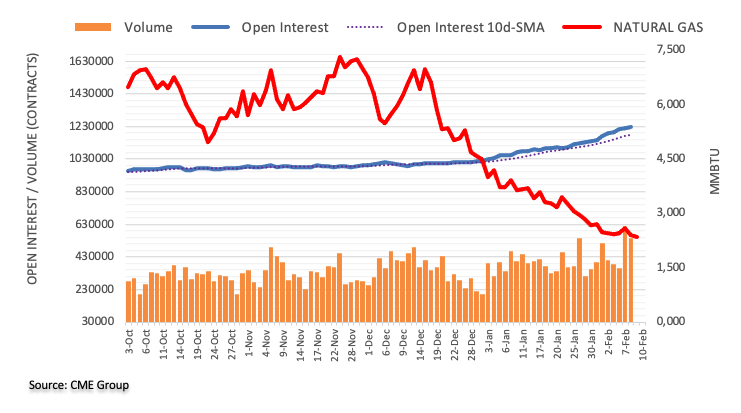
In the opinion of Economist Lee Sue Ann and Markets Strategist Quek Ser Leang at UOB Group, further downside could drag NZD/USD to the 0.6260 region in the next weeks.
Key Quotes
24-hour view: “We highlighted yesterday that NZD ‘is still consolidating’ and we expected it to ‘trade within a range of 0.6285/0.6360’. Our view for consolidation was not wrong even though NZD traded within a narrower range than expected (0.6298/0.6348). The price actions offer no fresh clues and NZD is likely to consolidate further. Expected range for today, 0.6290/0.6360.”
Next 1-3 weeks: “On Monday (06 Feb, spot at 0.6315), we highlighted that the risk for NZD has shifted to the downside to 0.6260. We added, ‘Further decline is possible but at this stage, the chance of a break of 0.6195 is not high’. There is no change in our view but oversold short-term conditions could lead to a couple of days of consolidation first. Overall, only a breach of 0.6400 (no change in ‘strong resistance’ level) would indicate that NZD is not weakening further.”
The Riksbank should hike by 50 bps today, in line with expectations. Economists at ING think it is necessary to sound hawkish to help restore confidence in the Krona.
A big day for the Riksbank
“We expect, in line with consensus, a 50 bps rate hike today. This outcome is fully priced in, but more uncertainty lies around the forward-looking tone and rate projections. Rate projections from November see a peak below 3%: we think today’s revision will take it to at least the 3.25-3.50% region.”
“We think a hawkish 50 bps hike by the Riksbank can prevent another leg higher in EUR/SEK: a primary goal is to create a cushion for the pair to the all-time March-2009 11.68 highs.”
“SEK is not lacking room for recovery (our base case is still for a drop below 11.00 in EUR/SEK by the summer). We doubt this will happen in the near term though, and despite a convincing hawkish message by the Riksbank today, restoring confidence in the Krona will require help from data.”
“EUR/SEK may trade around 11.20-11.40 in the coming weeks, and that should already be a welcome development for the Riksbank.”
See – Riksbank Preview: Forecasts from seven major banks, 50 bps, but the peak is not far off
CME Group’s flash data for crude oil futures markets noted traders added around 4.3K contracts to their open interest positions on Wednesday, reversing the previous daily drop and resuming the uptrend at the same time. Volume, instead, kept the erratic performance and shrank by around 201.1K contracts.
WTI: A retest of the 2023 low appears likely
Prices of the barrel of the WTI rose further north of the $78.00 mark on Wednesday. The move was supported by rising open interest, which leaves the door open for the continuation of this uptrend in the very near term. The marked drop in volume, however, prompts some caution and could spark a corrective decline with the next target at the YTD low near $72.00 (February 6).
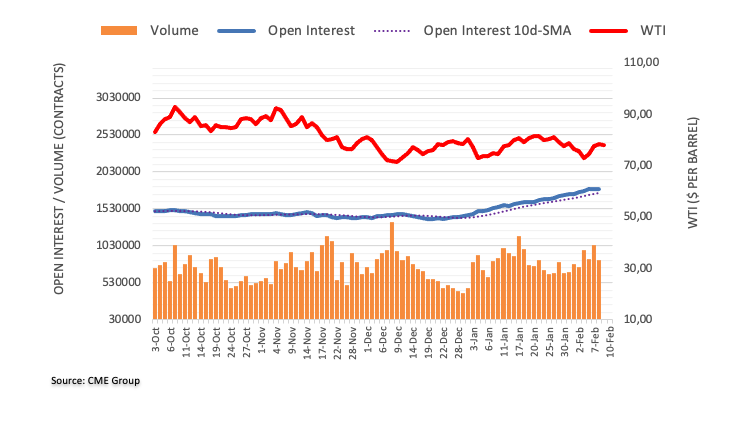
Riksbank is expected to lift the policy rate by 50 bps to 3.00%. Krona’s poor start of 2023 could be exacerbated if the central bank is unlikely to convince markets in its fight against inflation, Antje Praefcke, FX Analyst at Commerzbank, reports.
Only a hawkish Riksbank will be able to support SEK
“I can imagine that the Riksbank will hike its key rate by 50 bps today but then does not commit firmly to further rate hikes but, due to a high degree of uncertainty, makes its future approach dependent on the data, thus keeping all doors open in the end.”
“I do not think that in view of current inflation levels the Riksbank will already signal the first rate cuts at the very end of the forecasting horizon.”
“The Krona has already suffered as a result of weaker economic data, if concerns were to arise that Riksbank was not decisive enough in its fight against inflation that would be fatal for the Krona.”
“Only a hawkish Riksbank, determined to fight inflation despite a more depressed economic outlook, will be able to support SEK today.”
See – Riksbank Preview: Forecasts from seven major banks, 50 bps, but the peak is not far off
- NZD/USD gains strong positive traction on Thursday and rallies to the top end of the weekly range.
- A positive risk tone undermines the safe-haven USD and seems to benefit the risk-sensitive Kiwi.
- The prospects for additional rate hikes by the Fed could limit the USD losses and cap the major.
The NZD/USD pair attracts some meaningful buying on Thursday and extends its steady intraday ascent through the early European session. The pair is currently placed around the 0.6350 region, just a few pips below the weekly high touched on Tuesday and is supported by a modest US Dollar weakness.
The uncertainty over the Fed's rate-hike path fails to assist the USD to build on its post-NFP rally to a one-month high, which, in turn, acts as a tailwind for the NZD/USD pair. Apart from this, a recovery in the global risk sentiment - as depicted by a generally positive tone around the US equity futures - weighs on the safe-haven buck and benefits the risk-sensitive Kiwi.
The downside for the USD, however, seems limited amid diminishing odds for an imminent pause in the Fed's policy-tightening cycle. In fact, a slew of FOMC members echoed Fed Chair Jerome Powell's hawkish view on Tuesday that additional rate hikes were likely warranted to control inflation. This, in turn, might hold back bulls from placing aggressive bets around the NZD/USD pair.
Moreover, looming recession risks should keep a lid on any optimistic move in the markets, which should drive some haven flows towards the buck and contribute to capping the NZD/USD pair. Investors remain concerned about economic headwinds stemming from rising borrowing costs and the COVID-19 outbreak. This, along with fears about worsening US-China relations, could weigh on the sentiment.
The aforementioned fundamental backdrop makes it prudent to wait for some follow-through buying before confirming that the NZD/USD pair's recent pullback from the highest level since June 2022 has run its course. Market participants now look forward to the US Weekly Initial Jobless Claims data, which, along with the broader risk sentiment, might provide some impetus to the major.
Technical levels to watch
- Silver gains positive traction for the second straight day, though lacks follow-through.
- The technical setup favours bearish traders and supports prospects for further losses.
- A sustained weakness below the $22.00 mark is needed to confirm a bearish break.
Silver edges higher for the second successive day on Thursday and sticks to its modest gains through the early European session. The white metal, however, lacks bullish conviction and remains below the mid-$22.00s, well within a familiar trading range held since the beginning of the week.
The XAG/USD, meanwhile, manages to hold the 38.2% Fibonacci retracement level of the recent rally from October 2022 and above a two-month low touched on Monday. Furthermore, the subsequent bounce warrants caution before positioning for a further near-term depreciating move. That said, oscillators on the daily chart are holding deep in the negative territory and are still far from being in the oversold zone. This, in turn, favours bearish traders.
A convincing break below the $22.00 mark will reaffirm the negative outlook and drag the XAG/USD to the next relevant support near the 100-day SMA, around the $21.80-$21.75 region. This is followed by 50% Fibo. level, around the $21.35 area, below which the metal could fall to the $21.00 level en route to the 61.8% Fibo. level, around the $20.60-$20.55 zone. The descending trend could get extended towards testing the $20.00 psychological mark.
On the flip side, any subsequent move-up is likely to attract fresh sellers near the $22.70 region and remain capped near the $23.00 confluence support breakpoint. The said handle comprised 23.6% Fibo. level and the lower end of a nearly two-month-old trading range and should act as a tough nut to crack for the XAG/USD bulls. That said, a sustained move beyond might offset the negative outlook and shift the near-term bias in favour of bullish traders.
The XAG/USD might then surpass the $24.00 round-figure mark and climb back to the $24.55-$24.60 supply zone, or a multi-month top touched last week. The momentum could get extended towards reclaiming the $25.00 psychological mark for the first time since April 2022, above which bulls might aim to test the next relevant hurdle near the $25.35 region.
Silver daily chart
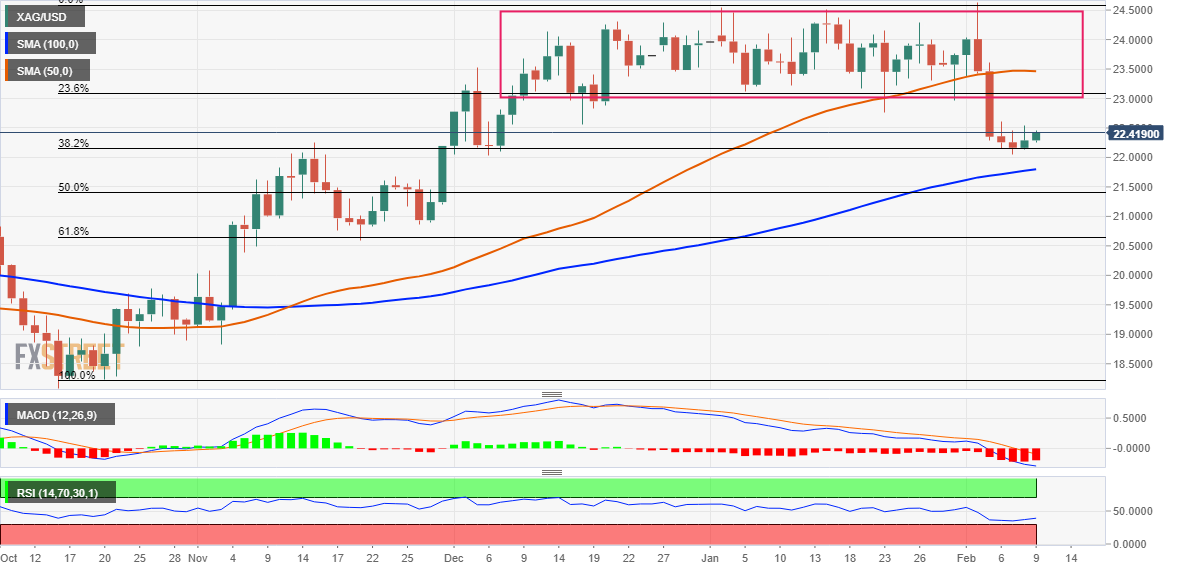
Key levels to watch
The Korean Won has gained the most ground of all APAC currencies over the last three months. Economists at ING expect the USD/KRW pair to break below the 1200 level.
KRW to strengthen despite chip slump
“China’s reopening and a possible policy change by the BoJ could encourage further KRW appreciation.”
“However, Korea’s chipmakers are experiencing slowing demand and there is a growing possibility that the current account balance may record a deficit during the first quarter of 2023.”
“We expect the Bank of Korea to enter an easing cycle in the second half of the year, echoing our expectations for Federal Reserve rate cuts.”
“We think the KRW will eventually break 1200 and touch 1180 later this year.”
Here is what you need to know on Thursday, February 9:
Despite hawkish comment from Fed officials, the US Dollar struggled to outperform its rivals mid-week amid retreating US Treasury bond yields. Bank of England (BoE) Monetary Policy Hearings will be watched closely by market participants and the European Commission will release its Economic Growth forecasts on Thursday. The US economic docket will feature the weekly Initial Jobless Claims data and investors will stay focused on central bank speak.
Wall Street's main indexes registered large losses on Wednesday led by the Communication Services sector which fell more than 4%. Meanwhile, the benchmark 10-year US Treasury bond yield snapped a three-day winning streak and lost nearly 2%, not allowing the US Dollar to capitalize on the risk-averse market environment. NY Fed President John Williams and Fed Governors Lisa Cook and Christopher Waller all noted that the Fed will need to keep a tight policy stance for some time, citing the uncertainty surrounding the inflation outlook.
Early Thursday, US stock index futures are up between 0.4% and 0.5% early Thursday, pointing to an improving market mood and the 10-year US T-bond yield holds steady at around 3.6%.
EUR/USD gained traction and climbed toward 1.0750 on Thursday after having closed virtually unchanged on Wednesday. The data from Germany revealed that the annual Harmonized Index of Consumer Prices (HICP) declined to 9.2% in January from 9.6% in December. This reading came much lower than the market expectation of 10% and made it difficult for the Euro to gather further strength.
GBP/USD managed to register small gains on Wednesday and climbed a few pips above 1.2100 early Thursday. BoE Governor Andrew Bailey, Chief Economist Huw Pill and MPC members Silvana Tenreyro and Jonathan Haskel will respond to questions from the Treasury Committee on the policy decisions from 0945 GMT.
USD/JPY continues to fluctuate in a relatively narrow channel above 131.00 as investors anxiously await nominations for the next Bank of Japan Governor.
Gold price took advantage of falling US yields on Wednesday and closed the third straight day marginally higher. Early Thursday, XAU/USD trades slightly higher on the day at around $1,880.
Bitcoin closed below $23,000 on Wednesday and touched its lowest level in two weeks at $22,360 early Thursday. At the time of press, BTC/USD was down more than 1% on the day at $22,650. Following Tuesday's rally, Ethereum reversed its direction and lost more than 1% on Wednesday. ETH/USD stays on the back foot in the European morning and declines toward $1,600.
GBP/USD could still slip back to the 1.1845 level while below 1.2150 in the near term, suggest Economist Lee Sue Ann and Markets Strategist Quek Ser Leang at UOB Group.
Key Quotes
24-hour view: “We expected GBP to consolidate and trade between 1.2000 and 1.2110 yesterday. In line with our expectations, GBP consolidated, albeit within a narrower range than expected (1.2037/1.2109). Most momentum indicators are flat and further consolidation appears likely. Expected range for today, 1.2025/1.2115.”
Next 1-3 weeks: “Our most recent narrative from Monday (February 6th, spot at 1.2050), stated, ‘further increase in downward momentum suggests more GBP weakness, but it remains to be seen if the significant support at 1.1845 will come into view’. GBP subsequently dropped to 1.1962 but it has not been able to make further headway on the downside. From here, as long as 1.2150 (no change in ‘strong resistance’ level) is not breached, there is still a chance, albeit a small one, for GBP to drop to 1.1845. A breach of 1.2150 would indicate that the weakness in GBP that started late last week has run its course.”
- The index gives away some gains in the low-103.00s.
- The dollar appears stuck within the weekly range.
- Usual weekly Initial Claims will be the salient event later in the session.
The USD Index (DXY), which tracks the greenback vs. a bundle of its main rival currencies, trades on the defensive in the 103.20 region on Thursday.
USD Index remains side-lined above 103.00
The index so far fades Wednesday’s decent uptick amidst the better tone in the risk complex. The index, however, maintains the range bound theme in the upper end of the weekly range, which appears at the same time capped by the vicinity of 104.00.
In the meantime, the dollar’s price action continues to look at the persistent debate between the relentless hawkish narrative from Fed’s policy makers vs. markets’ expectations of an impasse in the current tightening cycle.
On this, Fed’s Williams, Kashkari and Cook advocated on Wednesday for the continuation of the current hiking cycle beyond the 5% level and stay around those levels for some time.
In the US data space, Initial Jobless Claims will be the sole release of note across the Atlantic on Thursday.
What to look for around USD
The dollar remains within a consolidative phase in the upper end of the weekly range above the 103.00 mark against the backdrop of alternating risk appetite trends.
The idea of a probable pivot/impasse in the Fed’s normalization process now looks mitigated in favour of a tighter-for-longer narrative, which appears almost exclusively underpinned by the recent NFP prints. This view, however, is expected to take centre stage in the upcoming speeches by Fed’s rate setters.
The loss of traction in wage inflation, however, seems to lend some support to the view that the Fed’s tightening cycle have started to impact on the robust US labour markets somewhat.
Key events in the US this week: Initial Jobless Claims (Thursday) – Flash Consumer Sentiment (Friday).
Eminent issues on the back boiler: Rising conviction of a soft landing of the US economy. Slower pace of interest rate hikes by the Federal Reserve vs. shrinking odds for a recession in the next months. Fed’s pivot. Geopolitical effervescence vs. Russia and China. US-China trade conflict.
USD Index relevant levels
Now, the index is retreating 0.14% at 103.32 and the breach of 100.82 (2023 low February 2) would open the door to 100.00 (psychological level) and finally 99.81 (weekly low April 21 2022). On the other hand, the immediate up barrier emerges at 103.96 (monthly high February 7) seconded by 105.63 (2023 high January 6) and then 106.45 (200-day SMA).
- AUD/USD picks up bids to refresh intraday high.
- Risk profile improves on US-China, growth chatters amid a light calendar.
- China inflation, RBA Monetary Policy Statement eyed for clear directions.
AUD/USD renews intraday top near 0.6965 as buyers benefit from the broad US Dollar weakness and the risk-on mood during early Thursday’s sluggish session. In doing so, the Aussie pair seems to prepare for the next day’s heavy data flow comprising China inflation and monetary policy statement from the Reserve Bank of Australia (RBA), not to forget the US consumer-centric data.
For starters, the risk-positive headlines surrounding China occupy the driver’s seat to propel the risk-barometer AUD/USD prices. Important among them are the receding fears of the US-China jitters, following the China balloon shooting by the US, join the hopes of People’s Bank of China’s (PBOC) rate cuts and the restart of the China-based companies’ listing on the US exchanges to favor risk-on mood in the bloc.
On the other hand, the pullback in yields could also be linked to the AUD/USD pair’s run-up, as the same weighs on the US Dollar. That said, yields rely on the market’s reassessment of the hawkish Fed talks as Chairman Jerome Powell hesitated in praising the jobs report but Fed Governor Christopher Waller, New York Federal Reserve President John Williams and Fed Governor Lisa Cook highlight inflation fear to suggest further rate increases from the US central bank. Furthermore, comments from the US diplomats such as Treasury Secretary Janet Yellen and President Joe Biden also amplified inflation concerns, as well as hopes of no recession in the US, which in turn suggests a safe side for the Fed to hike the benchmark rates.
Against this backdrop, US Dollar Index (DXY) traces softer Treasury bond yields to reverse the previous day’s recovery moves, down 0.22% intraday near 103.25 at the latest. That said, the US 10-year Treasury bond yields reversed from a one-month high to snap a three-day uptrend on Wednesday, pressured around 3.62% by the press time. Furthermore, the Asia-Pacific shares grind higher whereas the S&P 500 Futures ignore Wall Street’s losses to print mild gains by the press time.
Looking ahead, the US Weekly Jobless Claims can entertain intraday traders while Friday’s RBA Monetary Policy Statement and China inflation data will be crucial for the AUD/USD pair traders to watch. That said, the RBA’s latest hawkish appearance and Beijing-linked optimism will be at test on Friday.
Technical analysis
AUD/USD run-up appears doubtful unless crossing the 21 and 10-DMA confluence near the 0.7000 psychological magnet.
- The annual HICP in Germany unexpectedly fell in January.
- EUR/USD reverses from daily highs but holds gains above 1.0700.
Inflation in Germany, as measured by the Harmonised Index of Consumer Prices (HICP), dropped to 9.2% on a yearly basis in January from 9.6% in December, the latest data from the German statistical office, Destatis, showed on Thursday. This reading came in lower than the market expectation of 10.0%.
On a monthly basis, the HICP climbed 0.5% in the first month of the year vs. 1.4% expected and -1.2% prior.
It’s worth noting that the HICP is the European Central Bank's (ECB) preferred gauge of inflation.
Meanwhile, the annualized Consumer Price Index (CPI) increased to 8.7% in January vs. 8.9% expected and 8.6% reported in December. Germany’s CPI came in at 1.0% MoM in the reported month when compared to the -0.8% previous reading and the estimates of 0.9%.
Market reaction
The Euro came under mild bearish pressure on the surprise drop in the German headline inflation, with EUR/USD paring gains from daily highs of 1.0745 to currently trade at 1.0732.
Gold price preserves weekly recovery gains. But XAU/USD is at crossroads amid bearish RSI and potential Bull Cross, FXStreet’s Dhwani Mehta reports.
$1,860 will continue to cap the downside
“The 14-day Relative Strength Index (RSI) is extending its gradual recovery but continues to stay below the midline, suggesting that risks remain skewed in favor of sellers. The ongoing higher lows formation combined with an impending bullish crossover, however, is still keeping Gold buyers in the game.”
“The Gold price upturn could gather strength on acceptance above the strong resistance at around $1,885, above which the journey toward the $1,900 threshold will be a smooth one. Further up, the 21-Daily Moving Average (DMA) at $1,912 will be a tough nut to crack.”
“The four-week low of $1,860 will continue to cap the downside, below which the bullish 50DMA at $1,854 will offer further support to Gold bulls. Daily closing below the latter will initiate a fresh downswing toward the January 5 low of $1,825.”
“We should see a peak in french inflation in h1 this year and inflation should then go down,” said European Central Bank (ECB) policymaker Francois Villeroy de Galhau on Thursday per Reuters.
Developing story...
Considering advanced prints from CME Group for gold futures markets, open interest shrank for the fifth consecutive session on Wednesday, this time by just 790 contracts. Volume followed suit and dropped by around 45.7K contracts.
Gold: Another visit to $1860 remains in the pipeline
Gold prices extended the weekly rebound on Wednesday amidst shrinking open interest and volume. Against that, the continuation of the recovery appears threatened and the yellow metal could recede to the area of recent lows around $1860 per ounce troy.
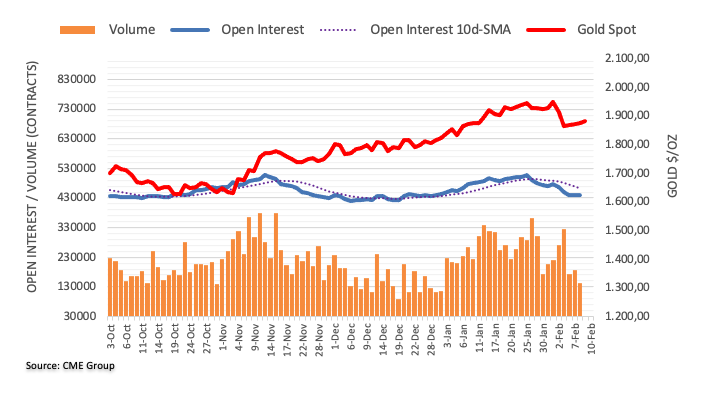
According to Economist Lee Sue Ann and Markets Strategist Quek Ser Leang at UOB Group, EUR/USD risks a potential drop to the 1.0615 level in the next few weeks.
Key Quotes
24-hour view: “Yesterday, we held the view that EUR ‘appears to have entered a consolidation phase and it is likely to trade between 1.0680 and 1.0780’. Our view for consolidation was not wrong but EUR traded within a narrower range than expected (1.0708/1.0760). The underlying tone has softened somewhat. While EUR is likely to edge lower today, it is unlikely to break 1.0665 (minor support is at 1.0690). On the upside, a breach of 1.0760 (minor resistance is at 1.0740) would indicate that the current mild downward pressure has eased.”
Next 1-3 weeks: “Our narrative from two days ago (07 Feb, spot at 1.0725) still stands. As highlighted, further EUR weakness is likely but oversold short-term conditions could slow the pace of any further decline. The next level to monitor is at 1.0615. The downside risk in EUR is intact as long as it does not break above 1.0810 (‘strong resistance’ level was at 1.0850 yesterday).”
- Gold price grinds higher for the fourth consecutive day amid sluggish session.
- Market’s reassessment of hawkish Fed talks, China-inspired risk-on mood favor XAU/USD bulls.
- A light calendar could challenge the Gold price inside a short-term trading range.
Gold price (XAU/USD) remains firmer around $1,880 during the four-day uptrend on early Thursday.
In doing so, the metal buyers take clues from the US Dollar’s pullback, as well as risk-positive headlines surrounding China, amid sluggish trading hours of the day. That said, hawkish concerns surrounding the Federal Reserve (Fed), however, challenge the buyers but technical analysis joins the price-positive catalysts to portray XAU/USD upside.
US Dollar Index (DXY) traces softer Treasury bond yields to reverse the previous day’s recovery moves, down 0.22% intraday near 103.25 at the latest. That said, the US 10-year Treasury bond yields reversed from a one-month high to snap a three-day uptrend on Wednesday, pressured around 3.62% by the press time.
The pullback in yields could be linked to the market’s reassessment of the hawkish Fed talks as Chairman Jerome Powell hesitated in praising the jobs report but Fed Governor Christopher Waller, New York Federal Reserve President John Williams and Fed Governor Lisa Cook highlight inflation fear to suggest further rate increases from the US central bank. Furthermore, comments from the US diplomats such as Treasury Secretary Janet Yellen and President Joe Biden also amplified inflation concerns, as well as hopes of no recession in the US, which in turn suggests a safe side for the Fed to hike the benchmark rates.
On the other hand, risk appetite improves amid the sentiment-positive headlines surrounding China and the US. That said, the receding fears of the US-China jitters, following the China balloon shooting by the US, join hopes of People’s Bank of China’s (PBOC) rate cuts and the restart of the China-based companies’ listing on the US exchanges to favor risk-on mood. Additionally favoring the sentiment could be the receding recession woes surrounding China and the US. On Wednesday, global rating giant Fitch inflated China's growth forecasts while US Treasury Secretary Yellen and President Biden recently cheered hopes of growth in the current year.
While portraying the mood, the Asia-Pacific shares grind higher whereas the S&P 500 Futures ignore Wall Street’s losses to print mild gains by the press time.
Looking ahead, Gold price may have to rely on the risk catalysts amid a light calendar, comprising only the US Weekly Jobless Claims.
Gold price technical analysis
Gold price holds onto the week-start recovery from a five-week-old ascending support line, around $1,865 by the press time. Adding strength to the upside bias are the bullish MACD signals and firmer RSI (14).
However, the 200-SMA and previous support line from December 22, 2022, near $1,885 and $1,890 in that order, cap the metal’s immediate upside.
Hence, the yellow metal is likely to remain firmer between $1,865 and $1,890, despite maintaining the short-term trading range.
In a case where the XAU/USD remains firmer past $1,890, the $1,900 threshold and a three-week-old resistance line, close to $1,977 at the latest, will gain the market’s attention.
Alternatively, a downside break of $1,865 can drag the commodity prices toward the previous monthly low of $1,825.
Gold price: Four-hour chart
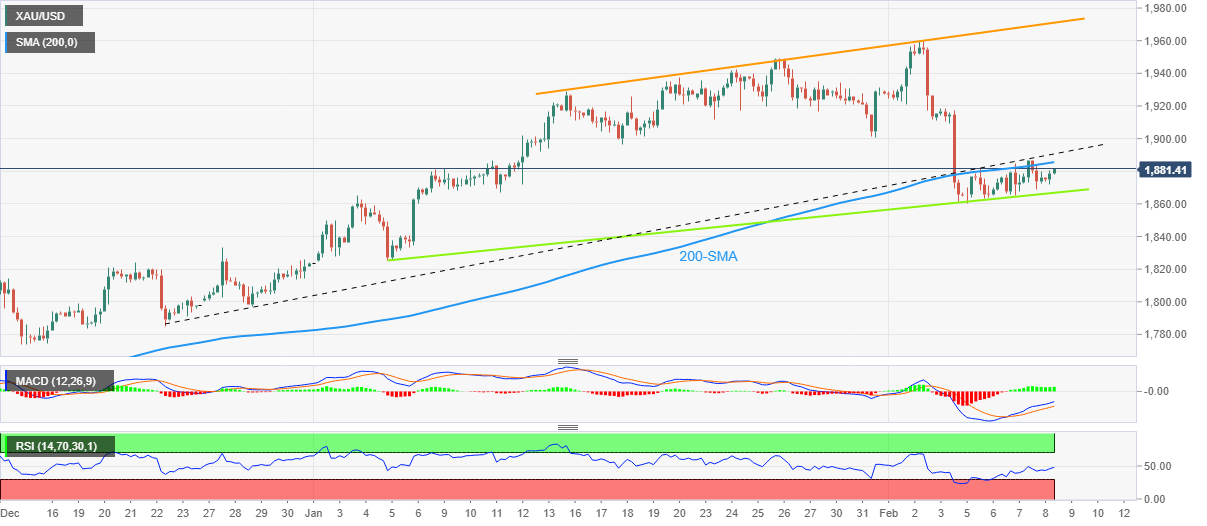
Trend: Limited recovery expected
- EUR/USD is aiming to stretch upside to near 1.0740 ahead of German Inflation data.
- Federal Reserve is expected to hike interest rates further as the upbeat labor market might propel consumer spending.
- Higher German Inflation data will bolster the case of bumper interest rate hikes by the European Central Bank ahead.
- EUR/USD is auctioning in an Ascending Triangle that indicates a volatility contraction.
EUR/USD has delivered a range extension above 1.0730 in the early European session after a recovery move from around 1.0710. The major currency pair has picked strength as the risk aversion theme has faded after investors digest the hawkish guidance from Federal Reserve (Fed) policymakers.
The US Dollar Index (DXY) has faced immense pressure as US Treasury yields have softened after investors rushed for buying US government bonds despite soaring expectations of a higher interest rate peak by the Federal Reserve. The USD Index is attempting to recapture the 103.00 resistance, however, the downside seems favored. Meanwhile, the 10-year US Treasury yields have dropped below 3.62%.
S&P500 futures have recovered firmly in the Asian session after a sell-off on Wednesday as tech stocks melted. Alphabet Inc. was heavily dumped by the market participants after Google Chatbot Brad Artificial Intelligence (AI) delivered an incorrect answer to an online advertisement.
Strong US Labor market to propel consumer spending
The street started expecting a pause in the policy tightening spell by Fed chair Jerome Powell earlier after scrutiny of December’s inflation-associated indicators. Consumer spending was contracted, Producer Price Index (PPI) was trimmed, and the scale of manufacturing economies confirmed a third consecutive contraction. However, fresh Nonfarm Payrolls (NFP) report faded the policy tightening pause expectations after reporting an almost three-fold jump in the number of job additions.
A strong labor market in the United States is expected to propel the employment cost index as the shortage of labor will be augmented by higher employment proposals from firms. This could trigger a rebound in the inflation projections as households with higher earnings in possession can lead to higher consumer spending.
Federal Reserve interest rate to climb above 5%
The latest US job market report has faded the expectations of 'wait and watch' approach for the interest rate policy and cues from analysts and Federal Reserve policymakers. There is no denying the fact that higher consumer spending by individuals due to higher earnings will fuel inflation projections and Fed chair Jerome Powell will be having no other option than to stretch interest rates further.
Jamie Dimon, CEO of JPMorgan Chase & Co., cautioned against declaring victory against inflation too early, warning the Fed could raise interest rates above the 5% mark if higher prices ended up "sticky," reported Reuters. He further added that Federal Reserve must go beyond 5% if inflation doesn’t come down to 3.5-4.00%.
German Inflation data to trigger action ahead
EUR/USD is expected to deliver a power-pack action after the release of the German Harmonized Index of Consumer Prices (HICP) data. The economic calendar has remained light this week, therefore, the impact of the German HICP will be relatively higher. The annual HICP (Jan) is expected to strengthen further to 10.0% from the prior release of 9.6%. The monthly price index is expected to accelerate by 1.4% vs. the contraction by 1.2%.
The double-digit inflation figure might add to troubles for the European Central Bank (ECB), which has already pushed interest rates to 2.50%, and more interest rate hikes are in pipeline.
European Central Bank policymaker Klaas Knot in an interview with MNI Market cited “Headline inflation has peaked now and the ECB will shift its focus to underlying inflation,” as reported by Reuters. European Central Bank policymaker further stated that the sharp decline in energy prices might continue to weigh pressure on headline inflation. The contraction in economic activities in Eurozone will be shallow and after that, a recovery in activities would again provide a cushion to the Consumer Price Index (CPI).
EUR/USD technical outlook
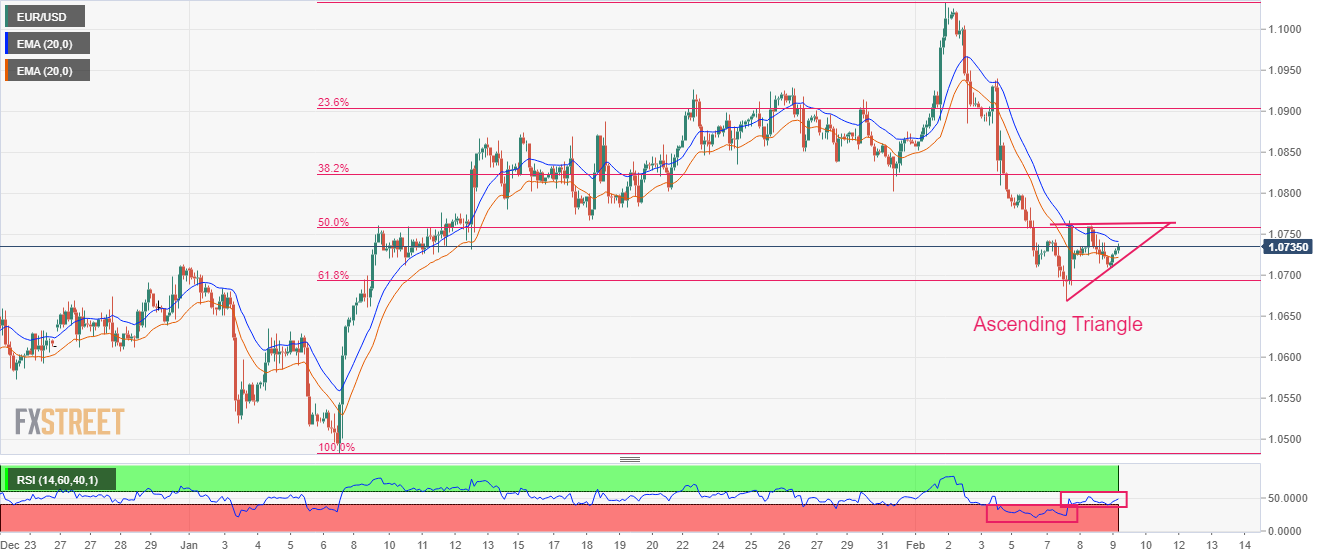
EUR/USD is oscillating between the 50% and 61.8% Fibonacci retracements (placed from January 6 low at 1.0483 to February 1 high at 1.1033) at 1.0760 and 1.0694 respectively. The shared currency pair is auctioning in an Ascending triangle chart pattern, which indicates a squeeze in volatility. The upward-sloping trendline of the chart pattern is placed from February 7 low at 1.0069 while the horizontal resistance is plotted from February 7 high at 1.0766.
The Euro is attempting to surpass the 20-Exponential Moving Average (EMA) (High-Low) band. A break above the same might trigger volatility for the US Dollar bulls.
The Relative Strength Index (RSI) (14) has shifted into the 40.00-60.00 range from the bearish range of 20.00-40.00, which indicates an attempt for a bullish reversal by the shared currency bulls.
- USD/JPY reverses the previous day’s recovery from weekly low, sidelined of late.
- Firmer RSI, sustained break of weekly resistance line keeps Yen buyer hopeful.
- Bulls need validation from 131.70 to keep the reins.
USD/JPY seesaws around 131.50 as buyers struggle to extend the previous day’s rebound amid a sluggish start to Thursday’s trading in Europe.
In doing so, the Yen pair struggles to justify Wednesday’s upside break of a downward-sloping resistance line from Monday, as well as the recovery from the 200-bar Exponential Moving Average (EMA). Adding strength to the bullish bias could be the steady run-up of the RSI (14) line, not overbought.
Even so, multiple hurdles marked since Monday challenges the immediate upside near the 131.60-70 horizontal area.
Following that, the USD/JPY rally toward the monthly high of 132.90 can’t be ruled out.
It’s worth observing that the pair’s successful trading above 132.90 will aim for the previous monthly peak surrounding 134.80.
Alternatively, a convergence of the 200-EMA and the previous resistance line challenges the USD/JPY bears around 130.70.
Following that, the 50% and 61.8% Fibonacci retracement level of the pair’s February 02-06 upside, respectively near the 130.50 and 130.00 round figure, will be in focus.
Should the Yen pair remains bearish past 130.00, the odds of witnessing a slump toward the multi-month low marked in January, around 127.20, can’t be ruled out.
To sum up, USD/JPY remains on the bull’s radar despite the latest inaction.
USD/JPY: Hourly chart
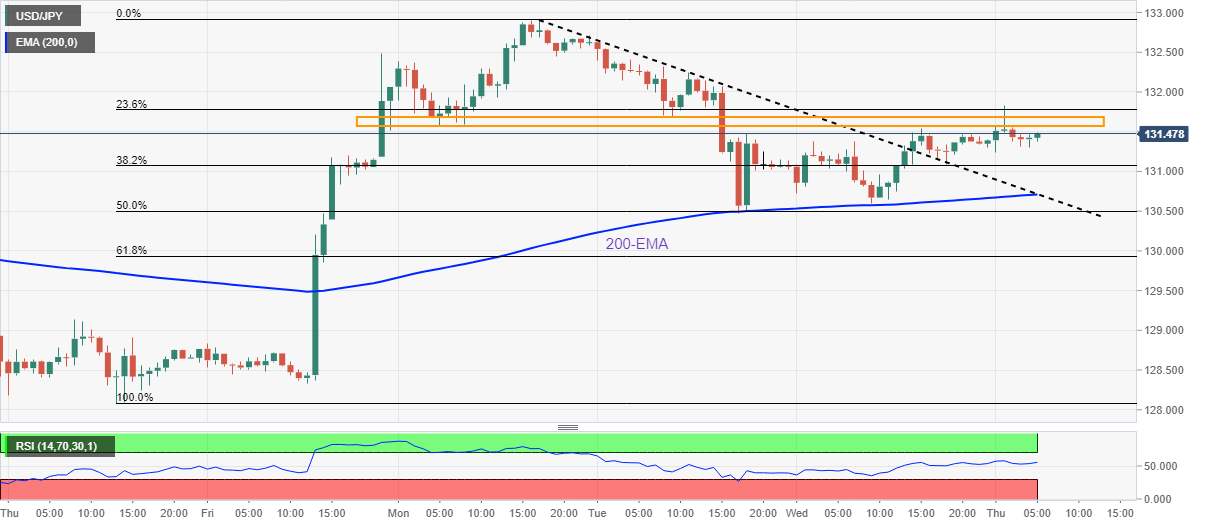
Trend: Further upside expected
- USD/CAD is attempting to deliver a breakout of the Falling Channel for the third time.
- The Loonie asset has reclaimed the 20-EMA, which indicates that the short-term trend is bullish now.
- A break into the bullish range of 60.00-40.00 by the RSI (14) will activate upside momentum.
The USD/CAD pair has dropped firmly to near 1.3435 after failing to recapture a weekly high around 1.3476 in the early European session. The Loonie asset is following the footprints of the US Dollar Index (DXY), which has surrendered the 103.00 cushion amid a sheer recovery in the risk-on impulse.
S&P500 futures have extended their gains firmly as investors’ risk appetite has improved after the market digested the hawkish interest rate guidance from the Federal Reserve (Fed). Meanwhile, the oil price is struggling to stretch its upside move above $78.50. It is worth noting that Canada is a leading exporter of oil to the United States and higher oil prices will support the Canadian Dollar.
USD/CAD is attempting to deliver a breakout of the Falling channel chart pattern on a two-hour scale, for the third time after two failed breaks due to the absence of strength in the US Dollar bulls. The Loonie is testing the strength of the breakout near 1.3432.
The 20-period Exponential Moving Average (EMA) at 1.3423 is acting as major support for the US Dollar bulls.
Meanwhile, the Relative Strength Index (RSI) (14) is struggling to cross 40.00. A break into the bullish range of 60.00-40.00 will activate upside momentum.
A break above February 7 high at 1.3469 will drive the asset toward January 19 high at 1.3521 followed by January 6 low at 1.3538.
On the flip side, a slippage below Wednesday’s low at 1.3360 will drag the asset toward January 3 low at 1.3321 and February 2 low at 1.3262.
USD/CAD two-hour chart
-638115169822130030.png)
- USD/INR remains pressured for the second consecutive day amid broad US Dollar weakness.
- RBI rejects dovish hike concerns even as matching market forecasts of 0.25% rate hike.
- Cautious optimism in Asia, downbeat US Treasury bond yields favor Indian Rupee buyers.
USD/INR fades bounce off intraday low as Indian Rupee buyers cheer cautious optimism in Asia, as well as a softer US Dollar, during early Thursday. In doing so, the pair sellers extend the Reserve Bank of India (RBI) inflicted losses to around 82.60 by the press time.
Market sentiment in Asia improves amid the risk-positive headlines surrounding China. That said, the receding fears of the US-China jitters, following the China balloon shooting by the US, join hopes of People’s Bank of China’s (PBOC) rate cuts and the restart of the China-based companies’ listing on the US exchanges to favor risk-on mood in the bloc.
Additionally favoring the sentiment could be the receding recession woes surrounding China and the US. On Wednesday, global rating giant Fitch inflated China's growth forecasts while US Treasury Secretary Janet Yellen and President Joe Biden recently cheered hopes of growth in the current year.
It should be noted that the RBI’s rejection of the market’s dovish hike expectations, by suggesting high inflation fears, also seems to weigh on the USD/INR prices. Following the RBI’s 0.25% hawkish move, analysts at ING and Citibank expect another 25 bps rate hike.
Alternatively, hawkish Fedspeak, including Fed Governor Christopher Waller, New York Federal Reserve President John Williams and Fed Governor Lisa Cook, highlight inflation fears and defended higher rates, while also pushing back the talks of rate cuts in 2023. On the same line were comments from the US diplomats as Treasury Secretary Janet Yellen mentioned, “While inflation remained elevated, there were encouraging signs that supply-demand mismatches were easing in many sectors of the economy.” Elsewhere, US President Joe Biden said during a PBS interview that there will be no US recession in 2023 or 2024.
Amid these plays, the US 10-year Treasury bond yields which reversed from a one-month high to snap a three-day uptrend on Wednesday, pressured around 3.61% at the latest. The same helped S&P 500 Futures to ignore Wall Street’s downbeat closing and remain mildly bid as of late.
Given the cautious optimism in the market and the US Dollar’s failure to justify hawkish Fed bias, the USD/INR pair may witness recovery if the US Weekly Jobless Claims keep portraying a strong US labor market. Also, fears of more Sino-American tussles and higher Fed rates may allow the Indian Rupee (INR) to pare RBI-inspired gains.
Technical analysis
USD/INR bears need validation from a convergence of the 100-DMA and a two-week-old ascending support line, close to the 82.00 round figure by the press time, to retake control.
- Chinese stocks are aiming higher amid the restart of offshore listings.
- The USD Index has turned sideways after dropping to near 103.00 as investors surrendered the risk-aversion theme.
- Oil prices are struggling to extend gains above $78.50 ahead of China’s inflation data.
Markets in the Asian domain are demonstrating mixed responses as S&P500 witnessed a sell-off on Wednesday, eased the majority of gains earned in Tuesday’s session. Sell-off in the US equities was tickled by weakness in the technology stocks. Alphabet Inc. was heavily dumped by the market participants after Google ChatGPT Artificial Intelligence (AI) delivered an incorrect answer to an online advertisement.
S&P500 futures have shown some decent gains in the Asian session as investors are digesting concerns about further policy tightening by the Federal Reserve (Fed), portraying a risk-on market mood. The US Dollar Index (DXY) has turned sideways after dropping to near 103.00 as investors surrendered the risk-aversion theme.
At the press time, Japan’s Nikkei225 eased 0.33%, ChinaA50 jumped almost 1%, Hang Seng gained 0.40%, and Nifty50 eased 0.40%.
Chinese stocks are escalating ahead of the release of the Consumer Price Index (CPI) data, which will release on Friday. The annual CPI is seen higher at 2.1% while producers are expected to display deflation in the prices of goods and services settled at factory gates.
The expectations of more stimulus by the Chinese administration and the People’s Bank of China (PBOC) to spurt economic growth after dismantling pandemic controls, will escalate inflation ahead, similar to inflationary pressures in the western countries which are battling against stubborn inflation after the pandemic period.
Chinese state media on Thursday cautioned against risks in chasing local ChatGPT-concept stocks, while domestic artificial intelligence (AI) companies urged investors to be rational after their soaring share prices caught regulators' attention, as reported by Reuters.
A revival of offshore listing of Chinese companies as Hesai Technology is going public in the United States will improve the risk appetite of Chinese investors.
Indian stocks are facing pressure after a two-day run-up as the Reserve Bank of India (RBI) has not trimmed inflation projections below 5% in any quarter of CY2023. This has opened doors for further hikes in the repo rate ahead.
On the oil front, oil prices are showing a loss in the upside momentum after reaching to $78.50. The oil price is likely to display a power-pack action after China’s inflation data. A decline in the inflation figures could call for more rate cuts by the PBoC ahead.
- GBP/USD grinds higher around intraday top during three-day uptrend.
- Broad US Dollar weakness, cautious optimism underpin recovery moves despite mixed UK fundamentals.
- British housing market flashes red signals, workers’ strikes are on the top.
- BOE Governor Bailey’s testimony, preliminary readings for UK Q4 GDP eyed amid a light calendar for Thursday.
GBP/USD bulls keep reins for the third consecutive day as the Cable picks up bids to renew its intraday high near 1.2085 heading into Thursday’s London open. In doing so, the quote ignores fears surrounding the UK’s economic and political frontiers amid broad US Dollar weakness. The reason could also be linked to the pre-data consolidation as the British Gross Domestic Product (GDP) for the fourth quarter (Q4) is up for publishing on Friday.
The US Dollar Index (DXY) traces downbeat Treasury bond yields to reverse the previous day’s recovery moves, down 0.11% intraday near 103.35 at the latest. That said, the US 10-year Treasury bond yields reversed from a one-month high to snap a three-day uptrend on Wednesday, pressured around 3.61% by the press time.
Also weighing on the greenback’s gauge versus the six major currencies could be the cautious optimism in the market. That said, the receding fears of the US-China jitters, following the balloon shooting, join hopes of People’s Bank of China’s (PBOC) rate cuts and the restart of the China-based companies listing on the US exchanges seem to favor risk appetite in Asia.
It’s worth observing that hawkish Fedspeak, including Fed Governor Christopher Waller, New York Federal Reserve President John Williams and Fed Governor Lisa Cook, highlight inflation fears and defended higher rates, while also pushing back the talks of rate cuts in 2023. The same should have favored the US Dollar but did not. On the same line were comments from the US diplomats as Treasury Secretary Janet Yellen mentioned, “While inflation remained elevated, there were encouraging signs that supply-demand mismatches were easing in many sectors of the economy.” Elsewhere, US President Joe Biden said during a PBS interview that there will be no US recession in 2023 or 2024.
At home, the UK Royal Institution of Chartered Surveyors (RICS) survey data mentioned earlier in the day that Britain's housing market suffered the most widespread price falls since 2009 last month as the run of interest rate increases over the past year weighed on would-be buyers. Additionally, the ongoing labor strikes in the UK and the resulting economic hardships challenge the upside bias surrounding the GBP/USD pair.
On the positive side, the Brexit developments favor the GBP/USD bulls. “Talks between Britain and the European Union to improve post-Brexit trading relations in Northern Ireland will continue after leading figures discussed the process on Wednesday,” said Reuters.
Against this backdrop, the market witnesses a mild optimism and weighs on the US Dollar. The same could be witnessed in the US 10-year Treasury bond yields which reversed from a one-month high to snap a three-day uptrend on Wednesday, pressured around 3.61% at the latest. The same helped S&P 500 Futures to ignore Wall Street’s downbeat closing and remain mildly bid as of late.
Moving on, the GBP/USD pair traders will keep their eyes on Bank of England (BoE) Governor Andrew Bailey’s Testimony in the UK Parliament for fresh impulse. The reason could be linked to the easing hawkish bias at the “Old Lady”, as the BoE is sometimes known. However, Friday’s UK Q4 GDP and the US consumer-centric data will be crucial for clear directions.
Technical analysis
Although a three-month-old ascending support line restricts GBP/USD downside near the 1.2000 psychological magnet, recovery remains elusive unless the quote stays below 50-DMA hurdle surrounding 1.2190.
- USD/IDR bounces off intraday low during three-day downtrend.
- Indonesia Retail Sales grew 0.7% in December versus 1.3% prior.
- Cautious optimism in Asia, US Dollar retreat keep pair bears hopeful.
- Hawkish Fed concerns, downbeat data can challenge Rupiah buyers.
USD/IDR picks up bids to extend the early-day rebound from intraday low as Indonesia reports downbeat Retail Sales figures on Thursday. Even so, the Indonesia Rupiah (IDR) pair remains weak for the third consecutive day amid broad US Dollar weakness and cautious optimism in the Asia-Pacific region.
Indonesia Retail Sales grew 0.7% YoY in December, compared to 1.3% previous growth. Earlier in the week, Indonesia reported the fourth quarter (Q4) Gross Domestic Product (GDP) data and showed that the economy grew 0.36% QoQ and 5.01% YoY during Q4 versus the 0.33% and 4.84% market forecasts. In doing so, Indonesia's GDP stayed below the 1.81% QoQ and 5.72% YoY previous releases but raced to a nine-year high.
It should be noted that the receding fears of the US-China jitters, due to the balloon shooting, join hopes of People’s Bank of China’s (PBOC) rate cuts and the restart of the China-based companies listing on the US exchanges seem to favor risk appetite in Asia.
Elsewhere, the US Dollar Index (DXY) traces the Treasury bond yields to reverse the previous day’s recovery moves, down 0.11% intraday near 103.35 at the latest. That said, the US 10-year Treasury bond yields reversed from a one-month high to snap a three-day uptrend on Wednesday, pressured around 3.61% by the press time.
The reason for the US Treasury yields’ retreat could be linked to the easing fears of the US recession, backed by comments from US President Joe Biden and Treasury Secretary Janet Yellen.
Alternatively, comments portraying inflation fears and supporting the higher rates at the Federal Reserve (Fed) from the Fed officials, as well as the US diplomats, challenge the USD/IDR bears. Fed Governor Christopher Waller teased a long fight with a 2.0% inflation target by citing expectations of tighter monetary policy for longer than expected. New York Federal Reserve President John Williams was almost on the same line while saying that the labor market is still very strong and noted that they have more work to do on rates, adding data will determine the path of rate hikes. Fed Governor Lisa Cook said that the central bank remains focused on restoring price stability, as inflation is still running too high. She added that they would need a restrictive monetary policy for some time.
That said, US Treasury Secretary Janet Yellen mentioned, “While inflation remained elevated, there were encouraging signs that supply-demand mismatches were easing in many sectors of the economy.” Elsewhere, US President Joe Biden said during a PBS interview that there will be no US recession in 2023 or 2024.
Moving on, risk catalysts could entertain USD/IDR traders amid a light calendar with only US Weekly Initial Jobless Claims will be eyed for fresh impulse.
Technical analysis
USD/IDR remains above the 21-DMA support of $15,065 amid bullish MACD signals and steady RSI, which in turn push back bearish bias unless the quote breaks the immediate DMA support.
- AUD/USD has extended its rebound move to near 0.6960 as investors’ risk appetite has improved.
- The asset has scaled above the 20-EMA, however, the 200-EMA is still above the spot price.
- The lower portion of the Rising Channel has acted as a support for the Australian Dollar.
The AUD/USD pair has recovered firmly from 0.6920 in the Asian session as the US Dollar index (DXY) has lost strength amid an easing risk-off impulse. The Aussie asset has accelerated to near 0.6960 and is expected to continue its upside momentum ahead.
Softer US Treasury yields have weighed on the US Dollar Index (DXY), which is working hard to hold itself above 103.00. Meanwhile, S&P500 futures are displaying significant gains as investors have ignored US President Joe Biden’s proposal of quadrupling taxes on corporate buybacks.
AUD/USD has rebounded firmly from the lower portion of the Rising Channel chart pattern on an hourly scale. The upper portion of the aforementioned chart pattern is placed from February 6 high at 0.6949 while the lower portion is plotted from February 6 low at 0.6855.
The Australian Dollar has pushed the asset above the 20-period Exponential Moving Average (EMA) at 0.6943 but is still below the 200-period EMA at 0.6989, which indicates that the short-term trend has turned bullish. However, the long-trend trend holds a bearish bias.
Meanwhile, the Relative Strength Index (RSI) (14) is oscillating in the 40.00-60.00, which favors a consolidation ahead.
A decisive break above January 23 high at 0.6962 will drive the asset towards the psychological resistance at 0.7000 followed by February 1 low around 0.7042.
In an alternative scenario, a downside break of the chart pattern below Wednesday’s low at 0.6919 will drag the asset toward February 7 low at 0.6885 and February 6 low at 0.6855.
AUD/USD hourly chart
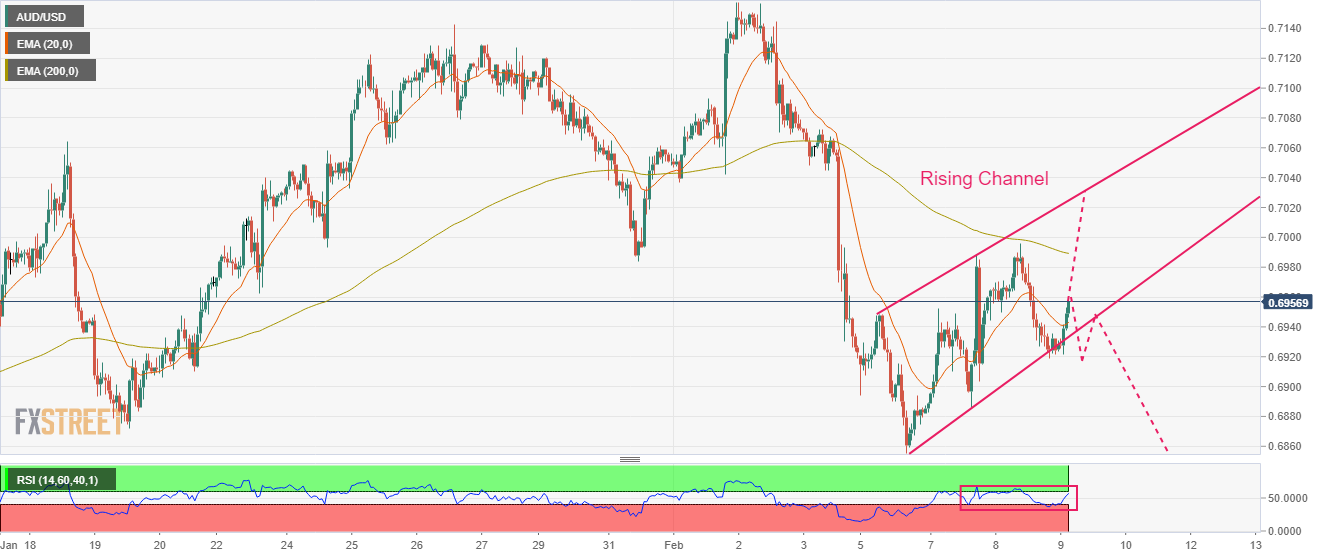
- Gold price has touched $1,880.00 amid a recovery in the risk-on market mood.
- Softer US yields are weighing on the USD Index despite hawkish Fed bets.
- Gold price is auctioning in a re-distribution episode in Wyckoff’s markdown phase.
Gold price (XAU/USD) has refreshed its day’s high above $1,880.00 in the Asian session. The gold price has shown a vertical upside move after rebounding from $1,872.00 as the risk appetite of the market participants has improved. The precious metal is expected to extend its upside move above $1,880.00 confidently as softer US Treasury yields have eased the risk-off impulse.
The yields earned on 10-year US Treasury bonds have dropped to near 3.61%. S&P500 futures have shown a recovery in the Asian session after a sell-off on Wednesday. The context that the Federal Reserve (Fed) won’t be aggressive ahead while hiking interest rates is supporting the 500-US stocks basket.
Meanwhile, the US Dollar Index (DXY) is struggling to sustain above 103.00 despite the street having started anticipating an interest rate peak by the Fed above 5%.
Jamie Dimon, CEO of JPMorgan Chase & Co., cautioned against declaring victory against inflation too early, warning the Fed could raise interest rates above the 5% mark if higher prices ended up "sticky," reported Reuters. He further added that Fed chair Jerome Powell must go beyond 5% if inflation doesn’t come down to 3.5-4.00%.
Gold technical analysis
Gold price is delivering a sideways performance on a broader note amid the Inverted Flag formation, which indicates a Wyckoff’s re-distribution in a Markdown phase. Usually, the re-distribution part of the markdown phase serves as an inventory adjustment in which those participants initiate shorts, which prefer to enter an auction after the establishment of a bearish bias.
The 100-period Exponential Moving Average (EMA) at $1,884.35 will act as a major barricade for the Gold bulls.
Meanwhile, the Relative Strength Index (RSI) (14) is oscillating in a 40.00-60.00 range, which indicates an absence of a potential trigger.
Gold hourly chart
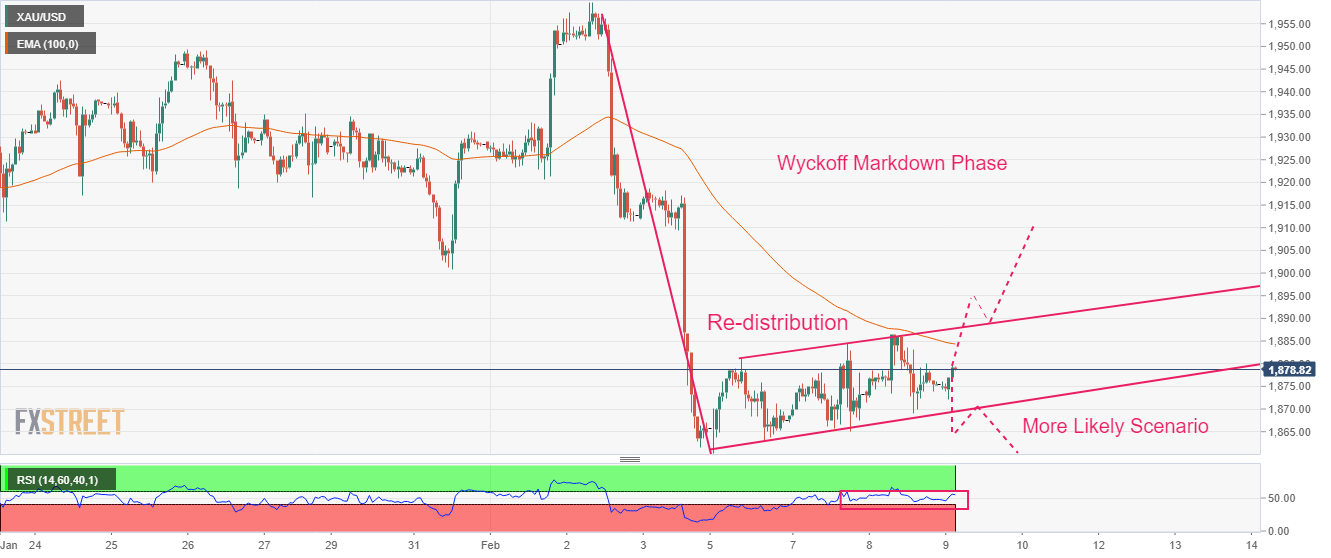
- EUR/USD picks up bids to snap four-day downtrend amid quiet markets.
- Cautious optimism, hawkish ECB comments please buyers ahead of the key data.
- Fed policymakers, US diplomats also defend higher rates and probe EUR/USD bulls.
- Preliminary readings of Germany’s monthly HICP, quarterly EU economic forecast will be crucial for intraday traders.
EUR/USD consolidates weekly moves as it renews its intraday high around 1.0730 during early Thursday morning. In doing so, the major currency pair prints the first daily gains in five while bouncing off the 50-DMA support amid sluggish initial trading hours of the day.
Behind the moves could be the recently hawkish commentary from the European Central Bank (ECB) officials, as well as the cautious optimism in the markets. Adding strength to the rebound are the downbeat US Treasury bond yields and a pullback in the US Dollar.
The latest rebound might also be termed as the preparations for the key data, namely the first readings of Germany’s headlines inflation gauge and European Commission’s (EC) quarterly economic forecasts. Even so, Federal Reserve (Fed) and US diplomats’ defense of the higher interest rates seems to challenge the EUR/USD buyers amid an inactive session.
On Wednesday, ECB monetary policy board member Klaas Knot said that headline inflation appears to have peaked but added that keeping the current pace of hikes into May could well be needed if underlying inflation does not materially abate.
On the other hand, Fed Governor Christopher Waller joined New York Federal Reserve President John Williams and another Fed Governor Lisa Cook to highlight inflation fears and signaled higher rates, while also pushing back the talks of rate cuts in 2023.
Not only the Fed policymakers but US diplomats were also highlighting concerns that defend the higher Fed rates and weighed on the EUR/USD price. Among them, US Treasury Secretary Janet Yellen mentioned, “While inflation remained elevated, there were encouraging signs that supply-demand mismatches were easing in many sectors of the economy.” Elsewhere, US President Joe Biden said during a PBS interview that there will be no US recession in 2023 or 2024.
Elsewhere, easing fears surrounding the US and China tension over the balloon shooting seems to have joined the lack of major negatives from elsewhere to underpin the mildly positive mood and propel the EUR/USD as the Euro traders await crucial data.
Amid these plays, the US 10-year Treasury bond yields reversed from a one-month high to snap a three-day uptrend on Wednesday, pressured around 3.61% at the latest. The same helped S&P 500 Futures to ignore Wall Street’s downbeat closing and remain mildly bid as of late.
Looking forward, the first prints of Germany’s Harmonized Index of Consumer Prices for January, expected 10.0% versus 9.6% prior, will be the first to direct EUR/USD traders. Following that, quarterly readings of the European Commission’s Economic Growth Forecasts and the US Weekly Initial Jobless Claims will be eyed for fresh impulse.
Overall, EUR/USD rebound appears elusive ahead of the key data/events, especially amid hawkish Fed concerns.
Technical analysis
EUR/USD bounces off 50-DMA support surrounding 1.0700 but the recovery needs validation from a three-week-old horizontal resistance area near 1.0765-70.
NZD/USD grinds higher around intraday top near 0.6330 while portraying the market’s cautious optimism, as well as taking upbeat signals from the options market data, during early Thursday.
While doing the same, the Kiwi pair fails to justify the hawkish Federal Reserve (Fed) rhetoric amid easing fears surrounding China.
Also read: NZD/USD bears move in and eye a bearish close for the day
That said, the key options market catalyst, one-month risk reversal (RR), prints a three-day uptrend and rises to the highest level in a week while posting 0.070 figures by the end of Wednesday’s North American trading session.
It’s worth noting that the RR is a ratio of call options versus put options, suggesting buyers’ optimism with positive figures and vice versa.
Not only the daily RR but the weekly one-month RR for the NZD/USD price also keeps the pair buyers hopeful as it snaps the three-week downtrend with the 0.115 figures for the current week.
| Raw materials | Closed | Change, % |
|---|---|---|
| Silver | 22.319 | 0.52 |
| Gold | 1875.74 | 0.15 |
| Palladium | 1649.21 | 0.47 |
- USD/CHF prints three-day downtrend to approach short-term key support line.
- Impending bear cross between 50-HMA and 100-HMA keep sellers hopeful amid mostly steady RSI.
- Bullish MACD signals, one-week-old ascending trend line hold the gate for bear’s entry.
USD/CHF sellers attack the 0.9200 threshold to refresh the intraday low early Thursday. In doing so, the Swiss Franc pair prints a three-day losing streak while justifying the trend-supportive RSI (14), as well as ignoring bullish MACD signals.
Other than the RSI (14) conditions, the 50-Hour Moving Average’s (HMA) piercing of the 100-HMA from above portrays the bear cross and also favors the USD/CHF bears.
However, a one-week-old ascending trend line challenges the USD/CHF sellers around 0.9195, a break of which could give them control.
Following that, a downward trajectory toward the monthly low of 0.9060 can’t be ruled out. During the fall, 0.9125 and 0.9100 levels may act as intermediate halts.
In a case where USD/CHF remains bearish past 0.9060, the August 2022 low near 0.9020 and the 0.9000 psychological magnet may lure the pair sellers.
On the flip side, recovery moves remain elusive unless staying below the convergence of the 50-HMA and the 100-HMA, around .9225.
Even so, an upward-sloping resistance line from January 24, close to 0.9295, will precede the 0.9300 threshold to challenge the USD/CHF bulls.
Overall, USD/CHF is likely to decline further but the sellers await the 0.9195 breakdown.
USD/CHF: Hourly chart

Trend: Further downside expected
In the view of the Goldman Sachs Research Team, the balance of risks is in favor a weaker Japanese Yen over the coming weeks.
Key quotes
"The US nonfarm payrolls report drove US yields higher and equities lower, a negative mix for the Yen particularly in an environment where Japanese yields are fixed. Indeed, JPY underperformed most other major currencies on the day, pushing up USD/JPY towards our 3-month forecast of 132.”
"The combination of our baseline views for 2023 of no recession, higher US yields, and the continuation of YCC in slightly different form argues for a period of renewed Yen weakness, despite the balance of risks looking more favorable for the currency given greater BoJ flexibility.”
- AUD/JPY bulls are in play and we could see an advance on 91.70 in the coming sessions/days ahead.
- The 61.8% Fibonacci near 93.00 is key on the upside.
AUD/JPY is displaying a bullish bias on the daily charts, at least for the meanwhile considering it recently broke to the backside of a prior meanwhile bearish trendline resistance.
The price is now meeting support in a phase of price discovery whereby the bears have been unable to convincingly break out of the bull's defensive lines and it has been a buy-the-dip theme for a number of days.
The following illustrates that should the bulls commit harder, then a break out to the upside could unfold over the comings days ahead:
AUD/JPY monthly and daily charts

As illustrated, while the bearish attempts at a break of 88.00 have resulted in a surge in demand, until the bulls conquer 93.00, a 61.8% Fibo resistance, there will be prospects of a deeper correction to the downside.
Zoomed in ...
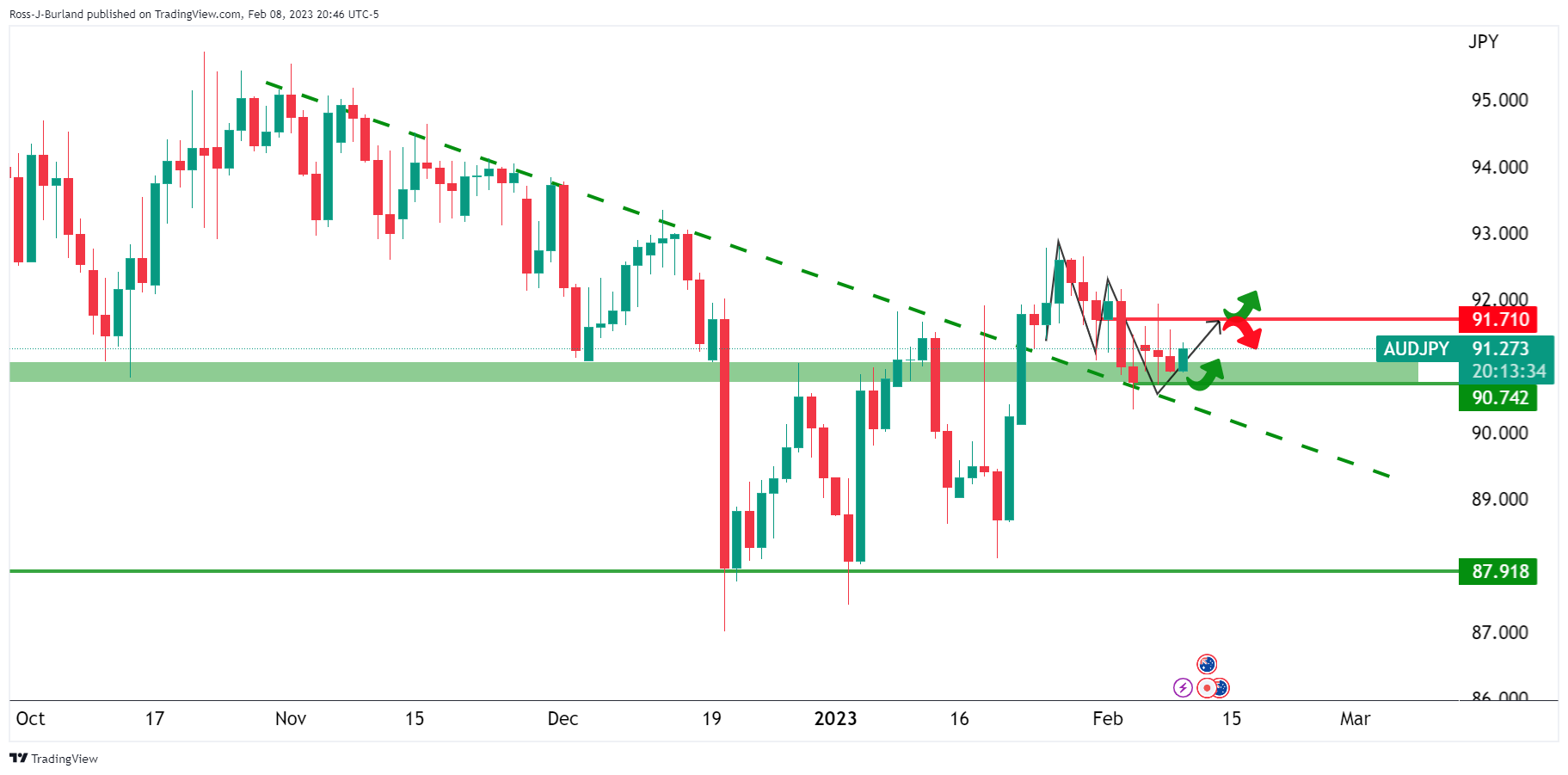
However, the cluster of failed bearish breakouts does keep the bulls in play and we could see an advance on 91.70 in the coming sessions/days ahead. A breakout there will leave the key 93.00 area vulnerable to another test.
- Market sentiment remains mildly positive amid a light calendar and mixed updates.
- Fed policymakers defend higher rates by citing inflation woes.
- US diplomatic stand concerning China tame the geopolitical fears and help build cautious optimism.
Risk profile appears positive during early Thursday, even as the market’s activity remains dismal.
While tracing the main catalysts the hawkish central bankers and contradicting geopolitical updates, as well as hopes of no economic slowdown, gain major attention amid an absence of major data/events during the Asian session.
On Wednesday, policymakers from the European Central Bank (ECB) and the Federal Reserve (Fed) tried defending higher rates and showed readiness for further aggression by citing inflation fears. Among them, comments from Fed Governor Christopher Waller and ECB policymaker Klaas Knot gained major attention. It’s worth noting, however, that the officials from the Bank of Canada (BoC) and Bank of Japan (BoJ) refrained from joining the hawks and confused traders.
Elsewhere, the US diplomats were also highlighting concerns that defend the higher Fed rates and challenge risk-takers. That said, US Treasury Secretary Janet Yellen mentioned, “While inflation remained elevated, there were encouraging signs that supply-demand mismatches were easing in many sectors of the economy.” Elsewhere, US President Joe Biden said during a PBS interview that there will be no US recession in 2023 or 2024.
On a different page, easing fears surrounding the US and China tension over the balloon shooting seems to have joined the lack of major negatives from elsewhere to underpin the mildly positive mood.
Against this backdrop, the US 10-year Treasury bond yields reversed from a one-month high to snap a three-day uptrend on Wednesday, pressured around 3.61% at the latest. The same helped S&P 500 Futures to ignore Wall Street’s downbeat closing and remain mildly bid as of late.
Looking forward, hawkish central bank bias, inflation fears and growth talks could entertain market players amid an absence of major data/events. Also important to watch will be the US Weekly Initial Jobless Claims.
- EUR/GBP has scaled above 0.8880 after a recovery move as bets for further ECB policy tightening is accelerating.
- ECB Knot believes that Eurozone headline inflation has peaked now amid falling energy prices.
- The German HICP is expected to increase to a double-digit figure on an annual basis.
The EUR/GBP pair has extended its rebound move from 0.8865 above the critical resistance of 0.8880 in the Asian session. The Euro bulls sensed a buying interest amid escalating hawkish bets for further interest rate decision by the European Central Bank (ECB).
The detailed explanation from ECB policymaker Klaas Knot in an interview with MNI Market cited “Headline inflation has peaked now and the ECB will shift its focus to underlying inflation,” as reported by Reuters. ECB policymakers further stated that the sharp decline in energy prices might continue to weigh pressure on headline inflation. The contraction in economic activities in Eurozone will be shallow and after that, a recovery in activities would provide a cushion to the Consumer Price Index (CPI).
Meanwhile, Isabel Schnabel, a Member of the European Central Bank (ECB)’s Executive Board, wrote in a press release entitled, 'Monetary policy in times of pandemic and war' that inflation momentum remains ‘quite elevated,‘ but cannot give all clear on inflation yet and that the ECB Intends to raise rates by 50bps in March.
On the economic front, investors will actively focus on the release of the German Inflation data. The annual Harmonized Index of Consumer Price (HICP) is seen at 10.0% higher than the former release of 9.6%.
Meanwhile, Pound Sterling bulls are likely to dance to the tunes of the United Kingdom Gross Domestic Product (GDP) (Q4) data. According to the estimates, the preliminary annual GDP data is expected to expand by 0.4% lower than the former release of 1.9%. While the quarterly data is expected to remain flat against a contraction of 0.3%.
Jamie Dimon, Chief Executive Officer (CEO) of JPMorgan Chase & Co., cautioned against declaring victory against inflation too early, warning the Federal Reserve could raise interest rates above the 5% mark if higher prices ended up "sticky," reported Reuters.
That said, Reuters interviews JP Morgan’s Dimon and published his outlook on multiple issues ranging from the Federal Reserve (Fed) to credit card fees.
Key comments
People should take a deep breath on this one before they declare victory because a month’s number looked good.
It’s perfectly reasonable for the Fed to go to 5% and wait a while but if inflation comes down to 3.5% or 4% and stays there, you may have to go higher than 5% and that could affect short rates, longer rates.
Stricter regulation of credit card fees could prompt lenders to extend less credit.
A default on U.S. debt - a prospect the country faces unless its debt ceiling is raised - would be potentially ‘catastrophic’.
Also read: US Dollar Index eyes three-week uptrend as Fed hawks ride on higher inflation expectations
- USD/CAD picks up bids to refresh intraday high and approach three-week-old resistance line.
- Hawkish Fed concerns underpin US Dollar rebound, weigh on Oil price.
- BoC’s Macklem contrasts with hawkish Fed comments and advocates a pause in rate hike trajectory.
USD/CAD remains on the front foot for the second consecutive day, extending the previous day’s rebound from the weekly low to refresh the intraday top near 1.3455 during early Thursday. In doing so, the Loonie pair justifies the divergence between the monetary policy outlook at the Bank of Canada (BoC) and the US Federal Reserve (Fed). Also fuelling the quote could be the latest weakness in the Oil price, Canada’s key exports, as well as the mixed sentiment.
On Wednesday, the BoC released its monetary policy meeting minutes for the first time and highlighted the growing discussions among the policymakers to pause the rate hikes. On the same line, BoC Governor Tiff Macklemd asked for time to gauge how households and businesses adapt to higher rates before further moves. The policymaker also said, “Rate hikes have hit homeowners hard.”
Elsewhere, Fed Governor Christopher Waller teased a long fight with a 2.0% inflation target by citing expectations of tighter monetary policy for longer than expected. New York Federal Reserve President John Williams was almost on the same line while saying that the labor market is still very strong and noted that they have more work to do on rates, adding data will determine the path of rate hikes. Fed Governor Lisa Cook said that the central bank remains focused on restoring price stability, as inflation is still running too high. She added that they would need a restrictive monetary policy for some time.
It’s worth noting that the US diplomats were also highlighting concerns that defend the higher Fed rates and fuel the USD/CAD price. Among them, US Treasury Secretary Janet Yellen mentioned, “While inflation remained elevated, there were encouraging signs that supply-demand mismatches were easing in many sectors of the economy.” Elsewhere, US President Joe Biden said during a PBS interview that there will be no US recession in 2023 or 2024.
On a different page, easing fears surrounding the US and China joins the firmer US Dollar Index (DXY) to weigh on the Oil prices, down 0.05% around $78.50 by the press time, which in turn allows the USD/CAD buyers to keep the reins.
Moving on, no major data/events are there for publishing on the calendar and hence the central bankers’ comments, as well as other risk catalysts, will be important for the USD/CAD pair traders to watch for clear directions.
Technical analysis
USD/CAD pair’s successful trading beyond the convergence of the 50-SMA and a weekly ascending trend line, near 1.3370, keeps buyers hopeful of overcoming the immediate resistance line stretched from January 19 surrounding 1.3470.
In recent trade today, the People’s Bank of China (PBOC) set the yuan at 6.7905 vs. the estimate at 6.7900 and the last close of 6.7940.
About the fix
China maintains strict control of the yuan’s rate on the mainland.
The onshore yuan (CNY) differs from the offshore one (CNH) in trading restrictions, this last one is not as tightly controlled.
Each morning, the People’s Bank of China (PBOC) sets a so-called daily midpoint fix, based on the yuan’s previous day's closing level and quotations taken from the inter-bank dealer.
- GBPUSD could be headed for a test of a 1.2050s supporting area that has a confluence with the 78.6% Fibonacci.
- Bulls eye a run to a 38.2% Fibonacci as a prospect for the day ahead if bulls emerge again between 1.2050/1.2010.
GBP/USD was a fake breakout scenario on Wednesday in what was a mixed market and during a phase of consolidation following Fridya's blow-off pertaining to the US Nonfarm Payrolls data. Bulls remain under pressure on attempts to move higher due to a resilient US Dollar and it has been a fade on rallies for the best part of the week so far.
The following illustrates the current boundaries and structure and offers neutral bias in so much that the price remains contained between 1.2110 and recent higher lows with failures to convince on the bid.
GBP/USD H1 chart

The schematic is pretty neutral given the phase of consolidation and the fact that the price has slid out of the bullish trendline and is now on the backside of it. A fresh dynamic trendline is being carved out but there are prospects of a move lower given the trapped volume up high and the market's tendency to move away from positions that are under heat in such a scenario due to the failed breakout to the 38.2% Fibonacci on Wednesday.
GBP/USD 78.6% Fibo eyed
Therefore, if we assume that a bull trap has been laid, if only momentarily, then it is safe to presume that the market is headed for a test of a 1.2050s supporting area that has a confluence with the 78.6% Fibonacci as illustrated above. However, while above there, albeit with risks all the way to the price imbalance near 1.2010/20, the 38.2% Fibonacci is still a prospect for the day ahead and we could see bulls emerge again between 1.2050/1.2010.
- USD/JPY has strongly surpassed 131.50 amid fresh concerns about further interest rate hike from the Fed.
- Fed Waller considers the US labor market extremely robust and believes that it could fuel consumer spending ahead.
- Investors are getting anxious ahead of the release of the contenders' list for BoJ Kuroda’s successor.
The USD/JPY pair has accelerated above the critical resistance of 131.80 in the Tokyo session. The asset has displayed significnat gains as investors are getting anxious ahead of the release of the contenders' list for the successor of Bank of Japan (BoJ) Governor Haruhiko Kuroda. BoJ’s Kuroda has been maintaining an ultra-loose monetary policy for a prolonged period and the Japanese administration wants to make plans for an exit from the expansionary policy with the successor.
The statement from US President Joe Biden that the United States will not witness recession in 2023 and 2024 has infused some strength into the risk-sensitive assets. S&P500 futures are demonstrating some gains in the Asian session after a bearish Wednesday, portraying a minor improvement in the risk appetite of investors.
The US Dollar Index (DXY) is struggling to sustain above 103.00 despite Federal Reserve (Fed) chair Jerome Powell and his teammates are stick to the plan of hiking interest rates further and keeping them steady at elevated levels for a longer period.
Commenting on interest rate guidance, Fed Governor Christopher Waller cleared that the central bank will maintain its current plan of action, which has seen eight interest rate hikes since March 2022, as reported by CNBC. Regarding the labor market, the Fed policymaker considers it extremely robust and believes that it could fuel consumer spending ahead.
On the Japanese Yen front, investors are keenly focused on the list of contenders for the novel BoJ Governor. Japanese Prime Minister Fumio Kishida said on Wednesday, “In process of choosing the next Bank of Japan (BoJ) Governor nominee, they are mindful of very strong market attention on the decision.”
Meanwhile, a note from OCBC states “Focus this week will be on the list of BoJ nominees that is likely to be presented to parliament on 10 February though there are reports suggesting a delay to next week. Amamiya’s appointment would be most supportive for the USD/JPY upside while Yamaguchi’s appointment could weigh down the Japanese Yen.
- AUD/USD stays depressed after reversing from weekly high the previous day.
- Fed policymakers, US diplomats highlight inflation fears to justify higher rates.
- Easing US-China fears contrasts with Australia’s drive to remove Chinese cameras from government offices and probe sentiment.
- US Dollar grinds higher even as yields remain pressured.
AUD/USD struggles push back the bearish bias during Thursday’s Asian session, despite the latest inaction around 0.6930-35, as mixed fundamentals join a light calendar. That said, the hawkish concerns surrounding the US Federal Reserve (Fed) keep the US Dollar firmer while mixed headlines about China probe Aussie traders of late.
Strong US employment and activity data allowed the Fed officials, including Chairman Jerome Powell, to recall inflation woes and propel the US Dollar Index (DXY), following the DXY’s week-start retreat from the monthly peak. The same joins an absence of major positives from elsewhere to probe the AUD/USD buyers.
Fed Governor Christopher Waller teased a long fight with a 2.0% inflation target by citing expectations of tighter monetary policy for longer than expected. New York Federal Reserve President John Williams was almost on the same line while saying that the labor market is still very strong and noted that they have more work to do on rates, adding data will determine the path of rate hikes. Fed Governor Lisa Cook said that the central bank remains focused on restoring price stability, as inflation is still running too high. She added that they would need a restrictive monetary policy for some time.
In addition to the Fed officials, US diplomats were also highlighting concerns that defend the higher Fed rates and weigh on AUD/USD. Among them, US Treasury Secretary Janet Yellen mentioned, “While inflation remained elevated, there were encouraging signs that supply-demand mismatches were easing in many sectors of the economy.” Elsewhere, US President Joe Biden said during a PBS interview that there will be no US recession in 2023 or 2024.
Alternatively, easing fears surrounding the US and China defend the AUD/USD buyers. However, the Aussie-China tensions are likely to return to the table and probe the pair’s run-up.
Recently, the ex-Fed Chair Jannet Yellen mentioned that it was important to improve communications with Chinese counterparts on economic issues, which in turn eased the US-China tension which escalated on the weekend news of the US shooting a Chinese balloon and terming it a spy. Further, US President Joe Biden also tried placating the Sino-American tussle as he said, “We intend to compete completely with China but we are not seeking conflict, as that has been the case so far.”
On the other hand, The Guardian mentioned that the federal government has committed to removing Chinese-made security cameras at government buildings across Australia, admitting there is a potential security problem that needs to be addressed.
Against this backdrop, the US 10-year Treasury bond yields reversed from a one-month high to snap a three-day uptrend on Wednesday, pressured around 3.62% at the latest. The same help S&P 500 Futures to ignore Wall Street’s downbeat closing and remain mildly bid as of late.
Looking forward, a light calendar apart from the US Weekly Initial Jobless Claims seems to challenge the AUD/USD momentum traders.
Technical analysis
A convergence of the 21 and 10-DMA restricts short-term AUD/USD upside near the 0.7000 psychological magnet. However, downside remains elusive unless the quote provides a daily closing below the 50-DMA support of 0.6865.
- EUR/USD is displaying volatility contraction on a broader note, which will result in wider ticks and heavy volume after expansion.
- The RSI (14) has slipped into the bearish range again amid an absence of strength in the recovery move by the Euro.
- Going forward, the release of the German Inflation data will be of utmost importance.
The EUR/USD pair has delivered an upside break of the extremely narrow range consolidation placed in a 1.0710-1.0716 zone in the Asian session. The major currency pair has rebounded as the risk appetite of the market participants is improving gradually amid a sheer decline in the US Treasury yields. The return generated on 10-year US Treasury bonds dropped to 3.60%.
S&P500 futures have attempted a recovery move as investors have started digesting recession fears in the United States amid expectations of further interest rate hikes by the Federal Reserve (Fed). For further guidance, investors will keep an eye on the German inflation data.
EUR/USD is demonstrating signs of volatility contraction post commentary from Fed chair Jerome Powell on the interest rate guidance. The shared currency pair is oscillating between the 50% and 61.8% Fibonacci retracements (placed from January 6 low at 1.0483 to February 1 high at 1.1033) at 1.0760 and 1.0694 respectively.
The 20-period Exponential Moving Average (EMA) at 1.0732 is acting as a major barricade for the Euro.
Meanwhile, the Relative Strength Index (RSI) (14) is looking to drift back into the bearish range of 20.00-40.00, indicating an absence of strength in the Euro.
Going forward, a break above Tuesday’s high at 1.0766 will drive the asset toward the round-level resistance at 1.0800 followed by 38.2% Fibo retracement at 1.0823.
On the flip side, a break below Tuesday’s low at 1.0669 will drag the major currency pair toward January 4 high at 1.0635 and December 22 low at 1.0573.
EUR/USD two-hour chart
-638114999977139769.png)
| Index | Change, points | Closed | Change, % |
|---|---|---|---|
| NIKKEI 225 | -79.01 | 27606.46 | -0.29 |
| Hang Seng | -15.18 | 21283.52 | -0.07 |
| KOSPI | 31.93 | 2483.64 | 1.3 |
| ASX 200 | 26 | 7530.1 | 0.35 |
| FTSE 100 | 20.47 | 7885.17 | 0.26 |
| DAX | 91.17 | 15412.05 | 0.6 |
| CAC 40 | -12.52 | 7119.83 | -0.18 |
| Dow Jones | -207.68 | 33949.01 | -0.61 |
| S&P 500 | -46.14 | 4117.86 | -1.11 |
| NASDAQ Composite | -203.27 | 11910.52 | -1.68 |
- Gold price fade the weekly rebound within a bearish chart pattern.
- Federal Reserve officials, United States Treasury Secretary highlight inflation concerns to defend higher rates and weigh on XAU/USD.
- Easing fears of US-China tension over the balloon shooting, light calendar probes XAU/USD traders.
Gold price (XAU/USD) struggles to extend week-start recovery moves as it makes rounds to $1,875 during Thursday’s Asian session, following the three-day uptrend. The lack of buying interest in the yellow metal could be linked to the hawkish Federal Reserve (Fed) comments, as well as statements highlighting inflation fears from the United States diplomats. However, receding woes of the US-China ties and a light calendar probes the XAU/USD bears even as the technical analysis tease the Gold sellers.
Federal Reserve officials probe Gold buyers
Having witnessed upbeat United States employment and activity data, the Federal Reserve (Fed) officials including Chairman Jerome Powell renewed inflation fears and allowed the US Dollar Index (DXY) to regain upside momentum, following the week-start retreat from the monthly peak. The same joins an absence of major positives from elsewhere to probe the Gold price upside.
That said, Fed Governor Christopher Waller teased a long fight with a 2.0% inflation target by citing expectations of tighter monetary policy for longer than expected. New York Federal Reserve President John Williams was almost on the same line while saying that the labor market is still very strong and noted that they have more work to do on rates, adding data will determine the path of rate hikes. Fed Governor Lisa Cook said that the central bank remains focused on restoring price stability, as inflation is still running too high. She added that they would need a restrictive monetary policy for some time.
United States diplomats also challenge XAU/USD rebound
Not only did the Federal Reserve (Fed) officials who flagged inflation fears and probe the Gold price but the United States diplomats were also highlighting concerns that challenge the XAU/USD upside. Among them, US Treasury Secretary Janet Yellen mentioned, “While inflation remained elevated, there were encouraging signs that supply-demand mismatches were easing in many sectors of the economy.” Elsewhere, US President Joe Biden said during a PBS interview that there will be no US recession in 2023 or 2024. The same allows the Fed to defend its hawkish bias amid inflation woes and challenge the recovery in the Gold price.
Sino-American issues entertain Gold traders
While the inflation woes and the United States growth concerns weigh on the Gold price, the easing fears surrounding the fresh tension between the US and China defend the XAU/USD buyers. Recently, the ex-Fed Chair Jannet Yellen mentioned that it was important to improve communications with Chinese counterparts on economic issues, which in turn eased the US-China tension which escalated on the weekend news of the US shooting a Chinese balloon and terming it a spy. Further, US President Joe Biden also tried placating the Sino-American tussle as he said, “We intend to compete completely with China but we are not seeking conflict, as that has been the case so far.”
A light calendar to track
Looking forward, multiple statistics from Europe relating to inflation and growth may entertain the Gold traders on Thursday. The reason could be linked to the European Central Bank (ECB) officials’ hawkish commentary and a lack of support from the data that can weigh on the US Dollar Index, favoring the XAU/USD bulls in turn, in case of strong economics. The same also highlights the US Weekly Initial Jobless Claims.
Gold price technical analysis
Gold price (XAU/USD) remains inside the weekly ascending trend channel while portraying a “Bear flag” bearish chart pattern on the hourly formation.
Adding strength to the bearish bias over the XAU/USD are the downbeat signals from the Moving Average Convergence and Divergence (MACD) indicator, as well as the steady Relative Strength Index (RSI) line placed at 14.
That said, a downside break of $1,870 appears necessary for the Gold sellers’ conviction while the weekly bottom surrounding $1,860 can act as an extra filter towards the south.
Following that, the theoretical target of the stated “Bear flag”, around $1,780, gains the XAU/USD bear’s attention.
Alternatively, the 100-Hour Moving Average (HMA) guards the Gold’s immediate upside near $1,880 before the stated flag’s top line surrounding $1,888.
In a case where the Gold price remains firmer past $1,888, the bearish chart pattern gets rejected and the XAU/USD bulls could aim for the 200-HMA hurdle of $1,905.
Gold price: Hourly chart
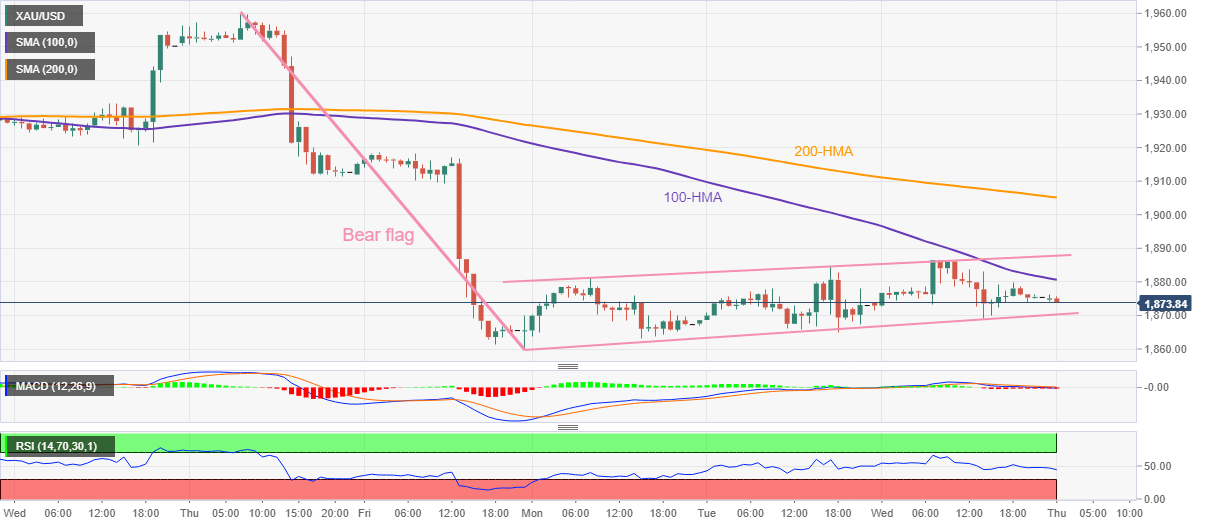
Trend: Downside expected
| Pare | Closed | Change, % |
|---|---|---|
| AUDUSD | 0.69235 | -0.44 |
| EURJPY | 140.85 | 0.25 |
| EURUSD | 1.07151 | -0.07 |
| GBPJPY | 158.659 | 0.57 |
| GBPUSD | 1.20704 | 0.28 |
| NZDUSD | 0.6306 | -0.19 |
| USDCAD | 1.3448 | 0.45 |
| USDCHF | 0.92088 | -0.11 |
| USDJPY | 131.45 | 0.3 |
- USD/CHF is facing pressure in overstepping the immediate resistance of 0.9200.
- The risk-off impulse is losing momentum as investors have shrugged off Fed-inspired recession fears.
- The shortage of labor in the US will be addressed by higher employment proposals from firms.
The USD/CHF pair is facing barricades in overstepping the immediate resistance of 0.9210 in the Asian session. The Swiss franc asset has gradually crossed the round-level resistance of 0.9200 but is struggling to extend gains further as the risk appetite of the market participants is improving again.
S&P500 futures have picked up some demand in the Asian session after a negative Wednesday. A recovery move in the 500-US stocks basket is indicating ease in the risk-off market mood. Also, investors are ignoring the proposal of quadrupling the corporate buyback tax on billionaires. Adding to that, the US Treasury yields have dropped firmly despite hawkish policy stances by various Federal Reserve (Fed) policymakers. The yields generated by the 10-year US government bonds have dropped to near 3.60%.
The US Dollar Index (DXY) is working hard to sustain above the critical resistance of 103.00. The upside in the USD Index seems solid as the Fed is aiming to keep interest rates higher for a longer period than earlier anticipated. Despite confirming the fact that the disinflationary process is active in the United States by Fed chairs Jerome Powell, further hiking in interest rates cannot be ruled out.
A strong labor market in the United States is expected to propel the employment cost index as the shortage of labor will be augmented by higher employment proposals from firms. This could trigger a rebound in the inflation projections as households with higher earnings in possession can lead to higher consumer spending.
On the Swiss franc front, the odds of a continuation of the interest rate hike spell by the Swiss National Bank (SNB) are gathering strength. SNB Chairman Thomas J. Jordan cited that the inflationary pressures are beyond the control of the central bank, which bolsters the case of further policy tightening.
- NZD/USD is coiled and due for a breakout.
- NZD/USD 4-hour schematic is bullish above 0.6320.
NZD/USD is stuck in consolidation between 0.6350 and 0.6270, but a breakout is inevitable and the question is, in what direction? Coiled markets tend to move in an explosive fashion and we are well into the week yet we are yet to move in a meaningful direction ever since the Nonfarm Payrolls blow-off.
The following illustrates the prospects of a deeper correction into at least the 38.25 Fibonacci retracement of the NFP sell-off:
NZD/USD daily charts
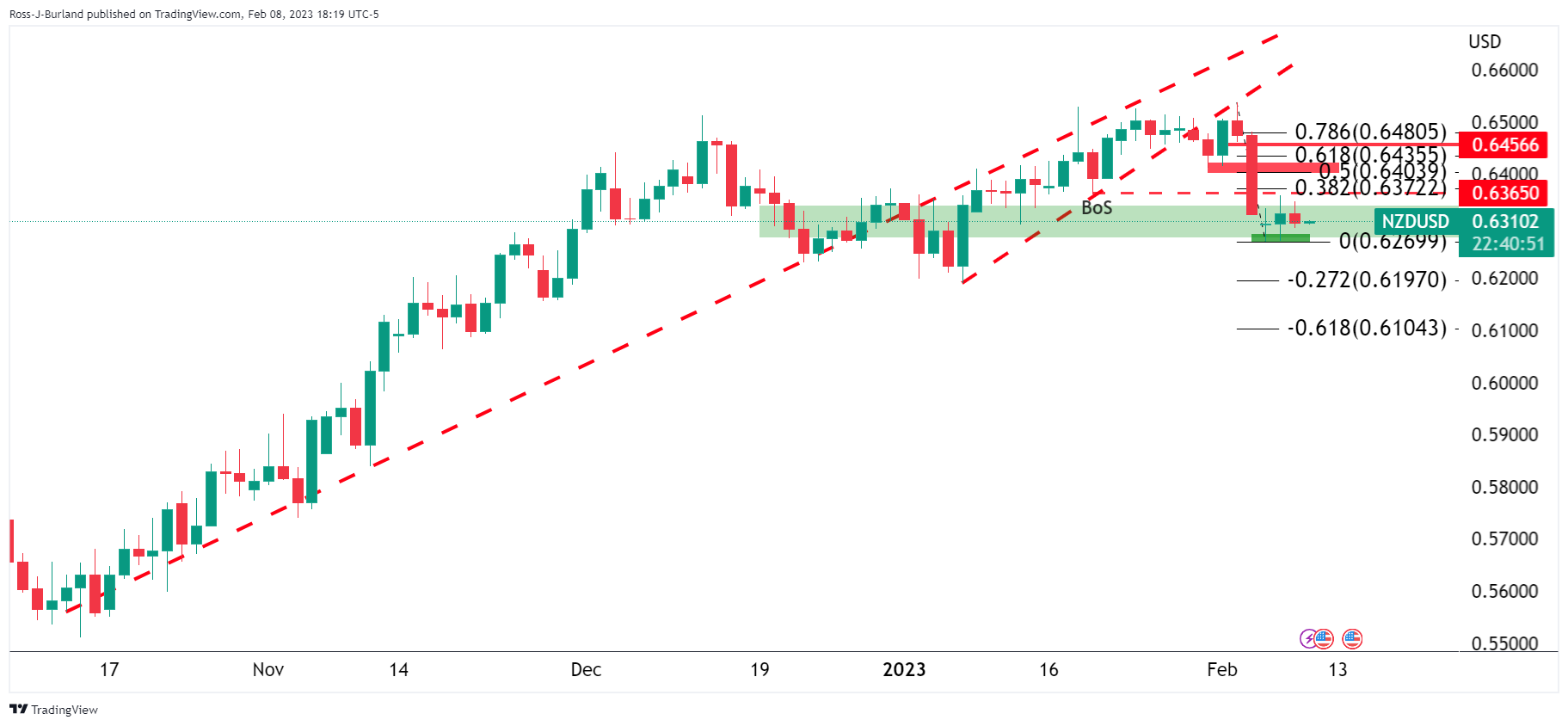
The price is on the backside of the bullish daily trend but is being supported, although the downside bias for the medium term is solidified considering the break of structure 0.6365.
Zoomed in ...

However, as seen the bears can't shake off the bulls that have defended this area of support:

If we are going to see a move, it could come sooner than later with 0.6370 eyed in a 38.2% Fibonacci retracement:

NZD/USD H4 chart
Meanwhile, the 4-hour schematic is bullish above 0.6320:
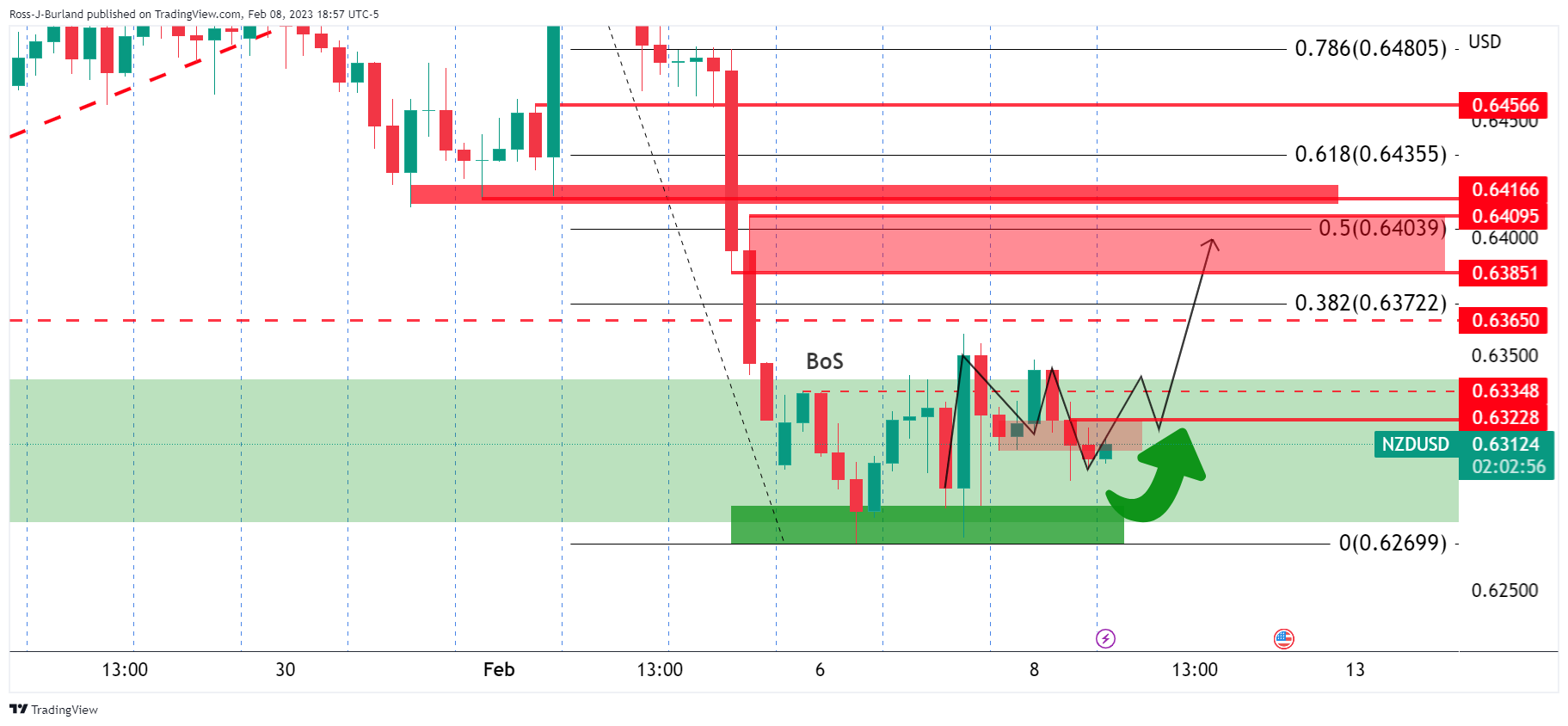
© 2000-2024. All rights reserved.
This site is managed by Teletrade D.J. LLC 2351 LLC 2022 (Euro House, Richmond Hill Road, Kingstown, VC0100, St. Vincent and the Grenadines).
The information on this website is for informational purposes only and does not constitute any investment advice.
The company does not serve or provide services to customers who are residents of the US, Canada, Iran, The Democratic People's Republic of Korea, Yemen and FATF blacklisted countries.
Making transactions on financial markets with marginal financial instruments opens up wide possibilities and allows investors who are willing to take risks to earn high profits, carrying a potentially high risk of losses at the same time. Therefore you should responsibly approach the issue of choosing the appropriate investment strategy, taking the available resources into account, before starting trading.
Use of the information: full or partial use of materials from this website must always be referenced to TeleTrade as the source of information. Use of the materials on the Internet must be accompanied by a hyperlink to teletrade.org. Automatic import of materials and information from this website is prohibited.
Please contact our PR department if you have any questions or need assistance at pr@teletrade.global.
